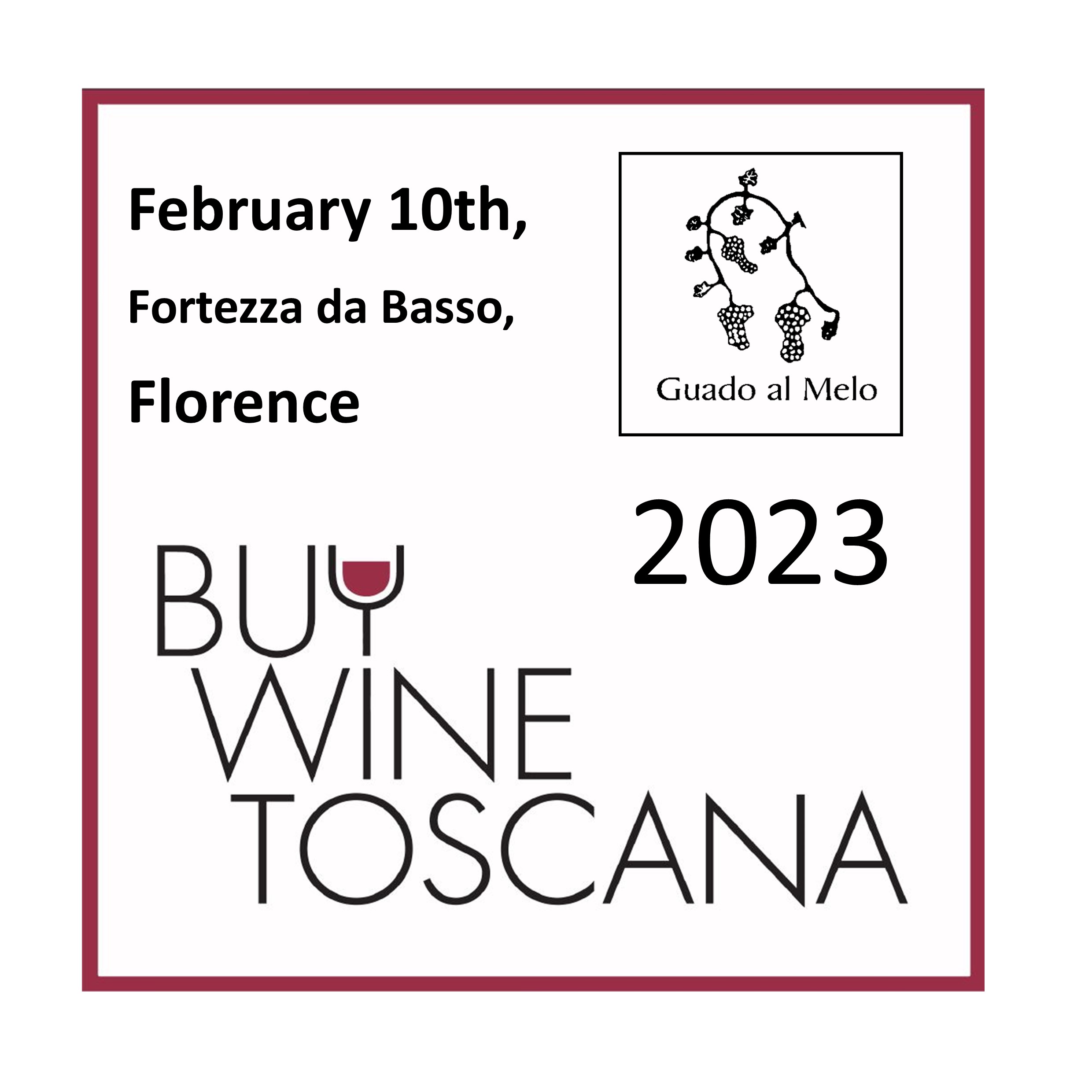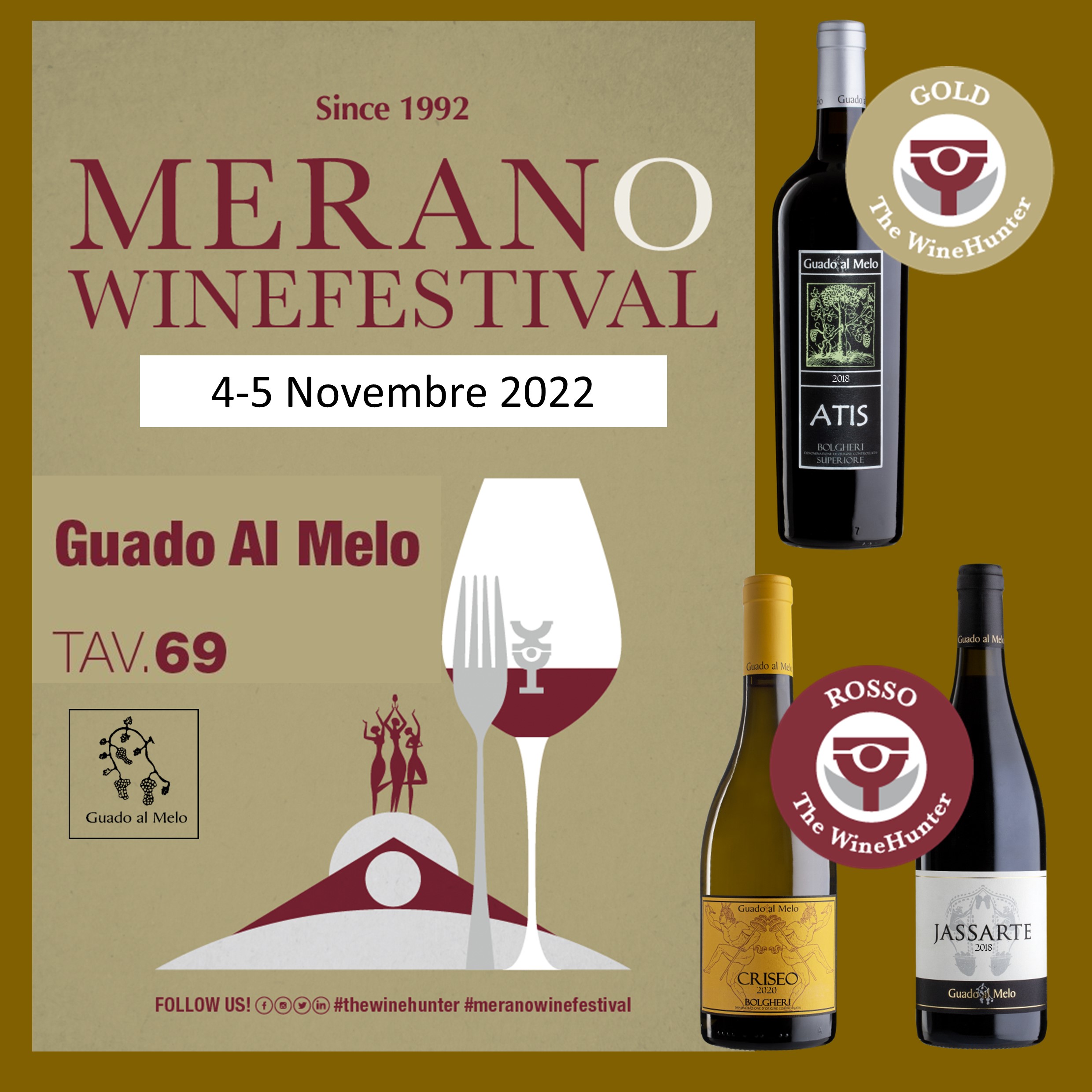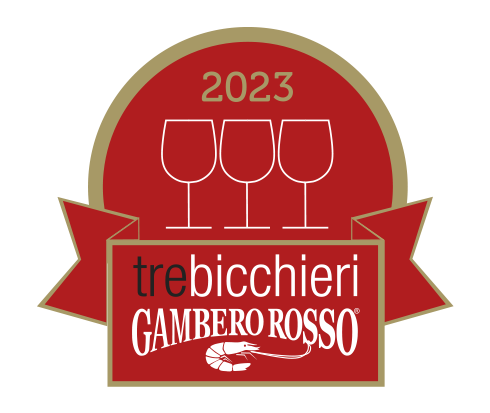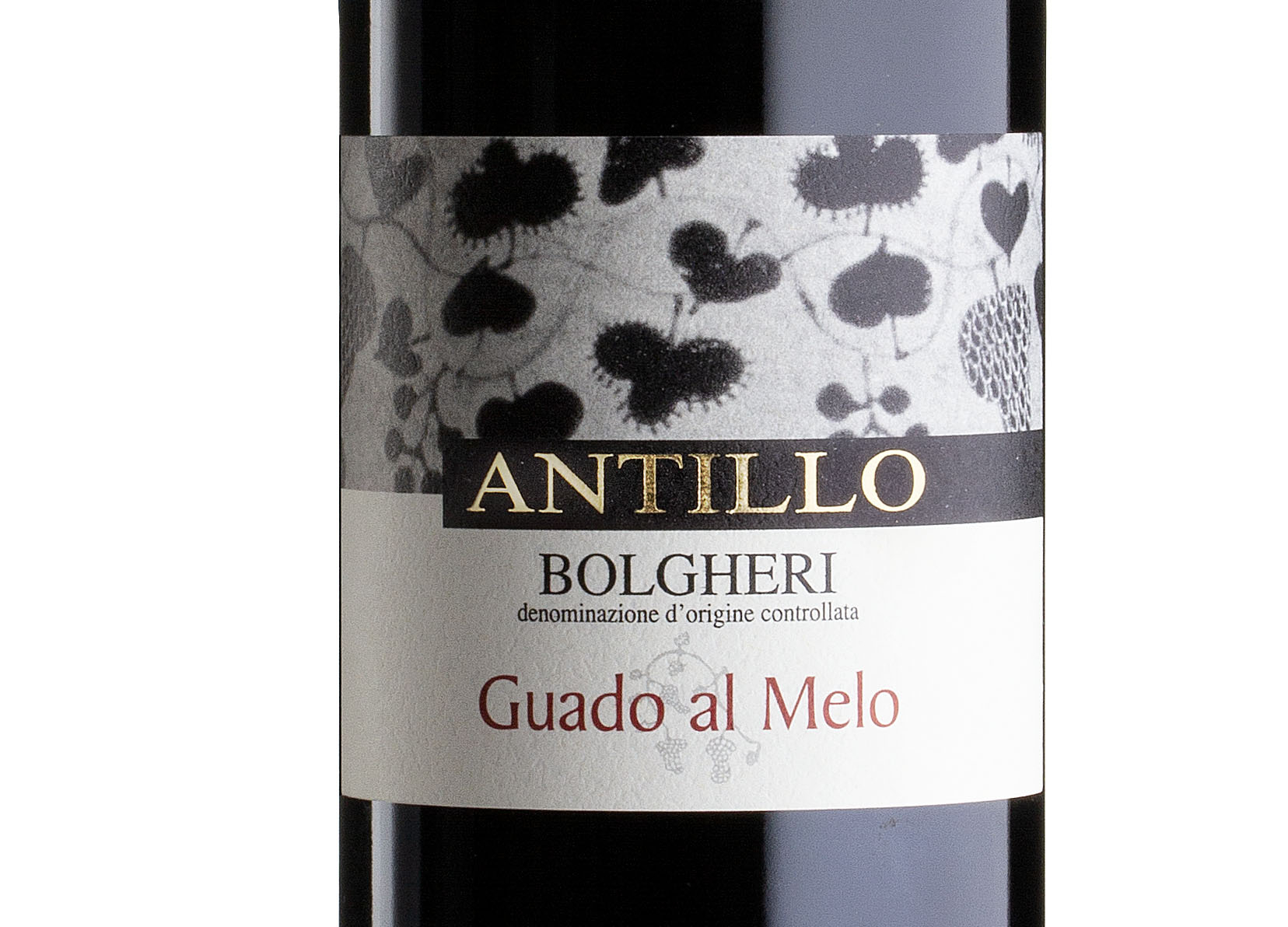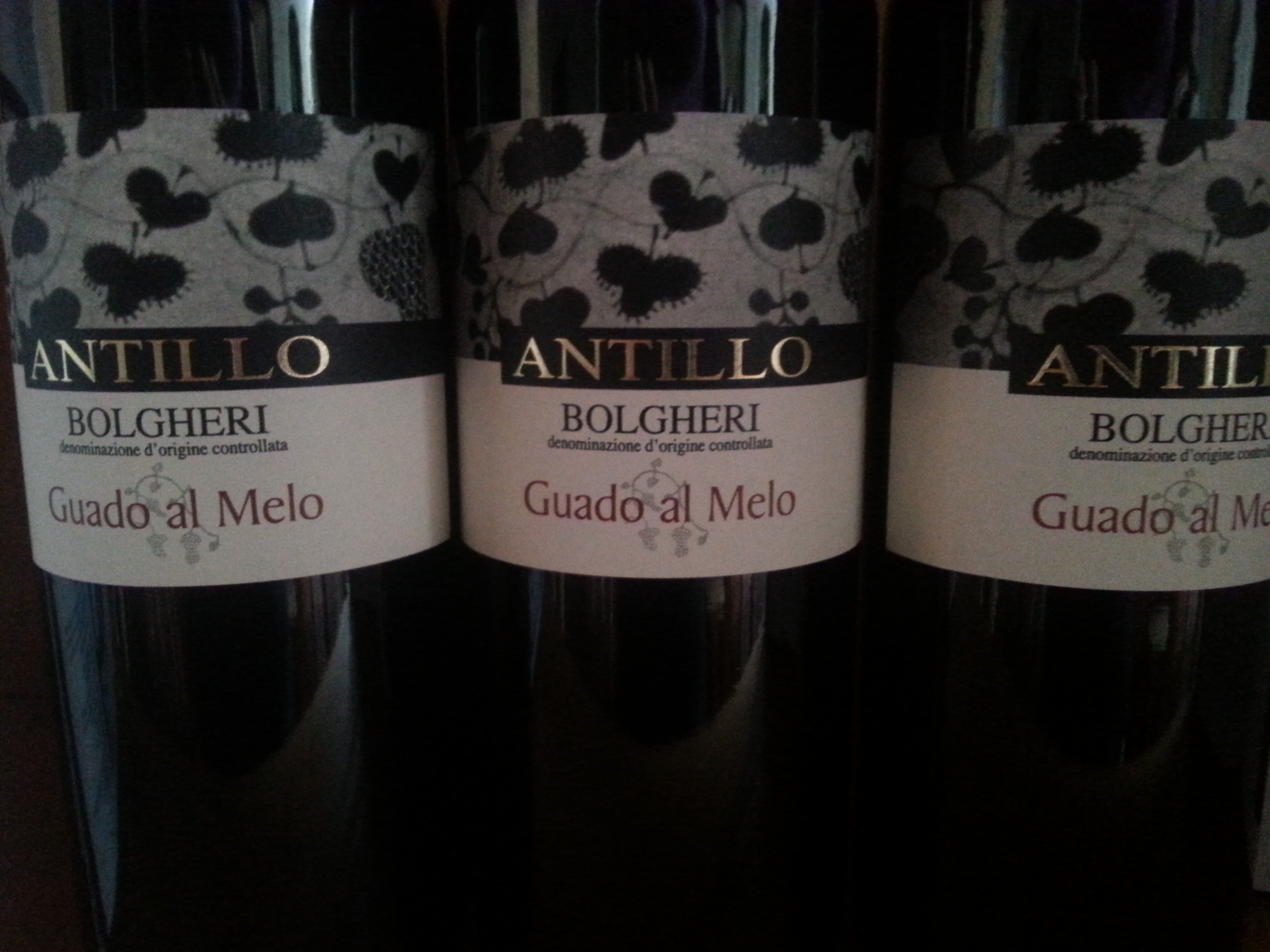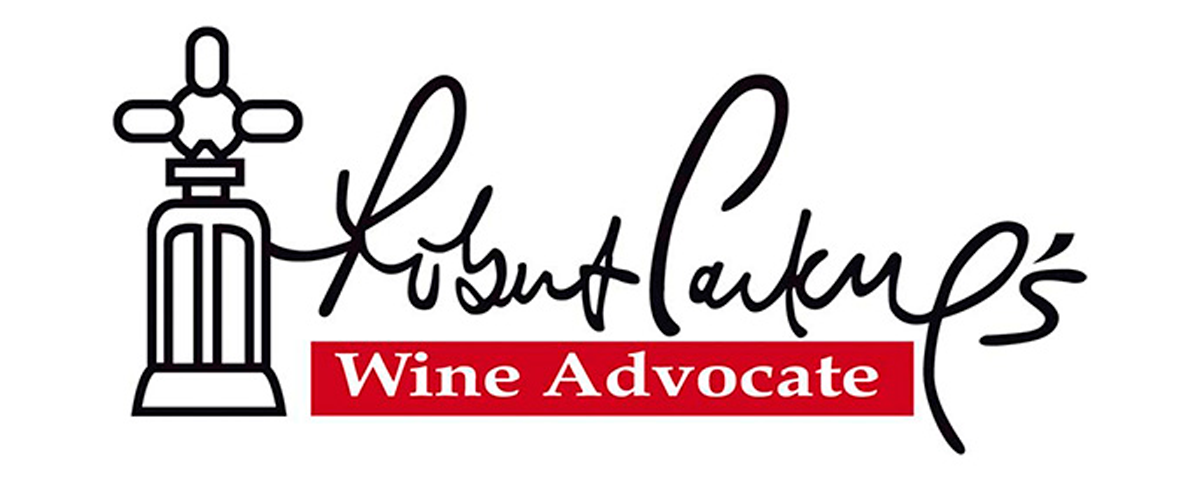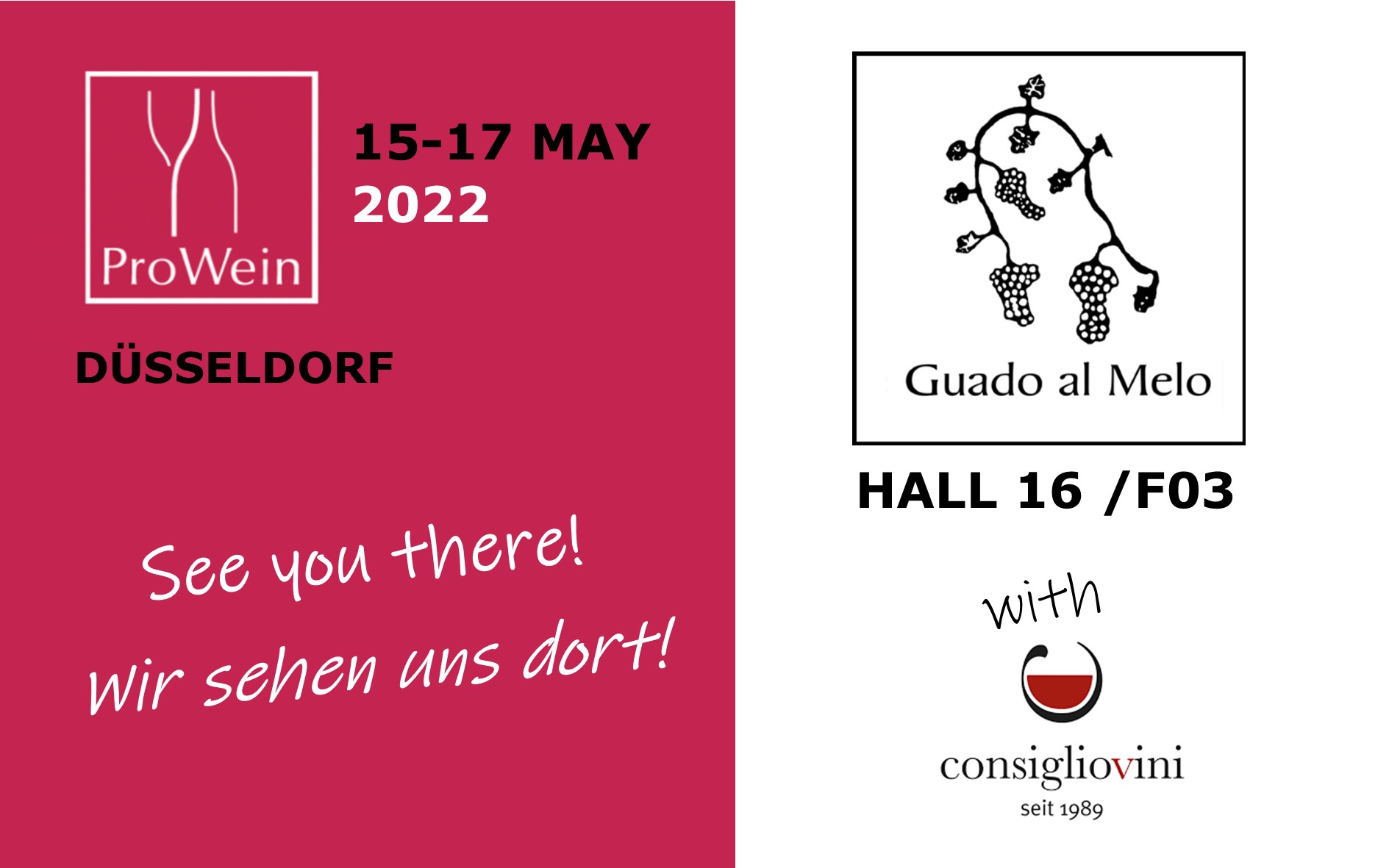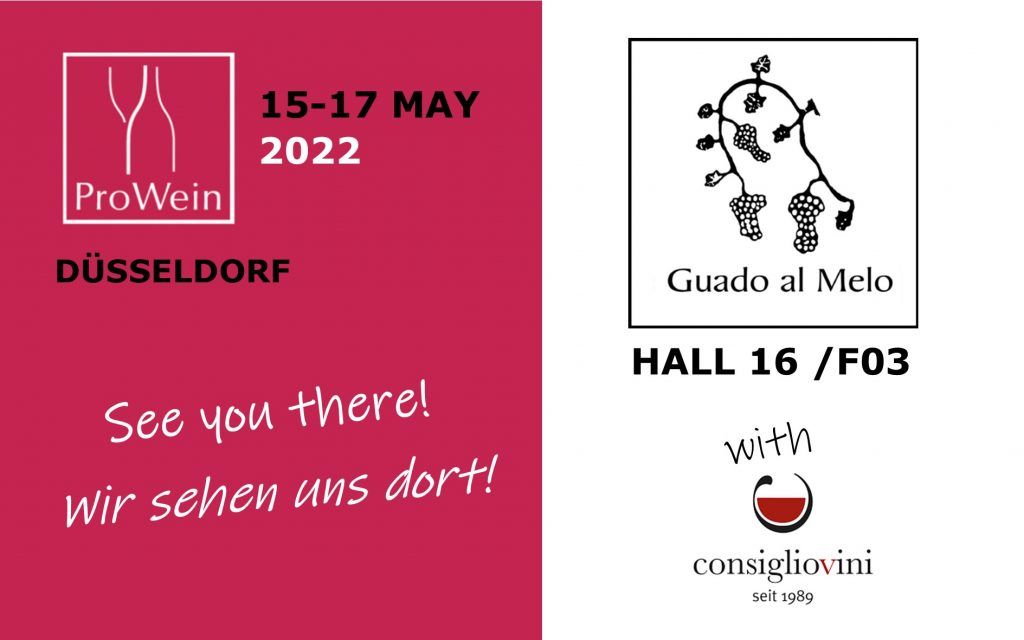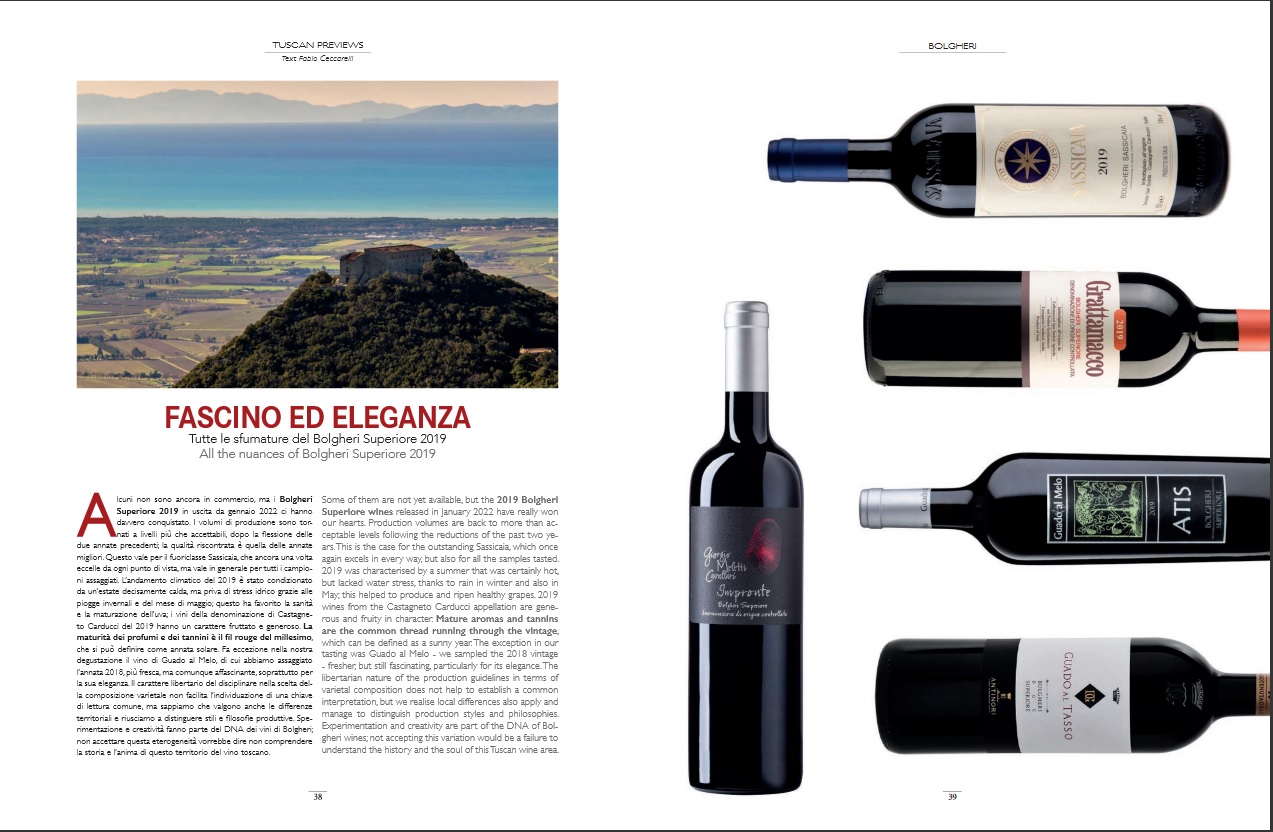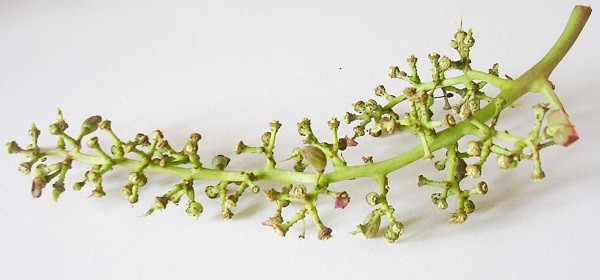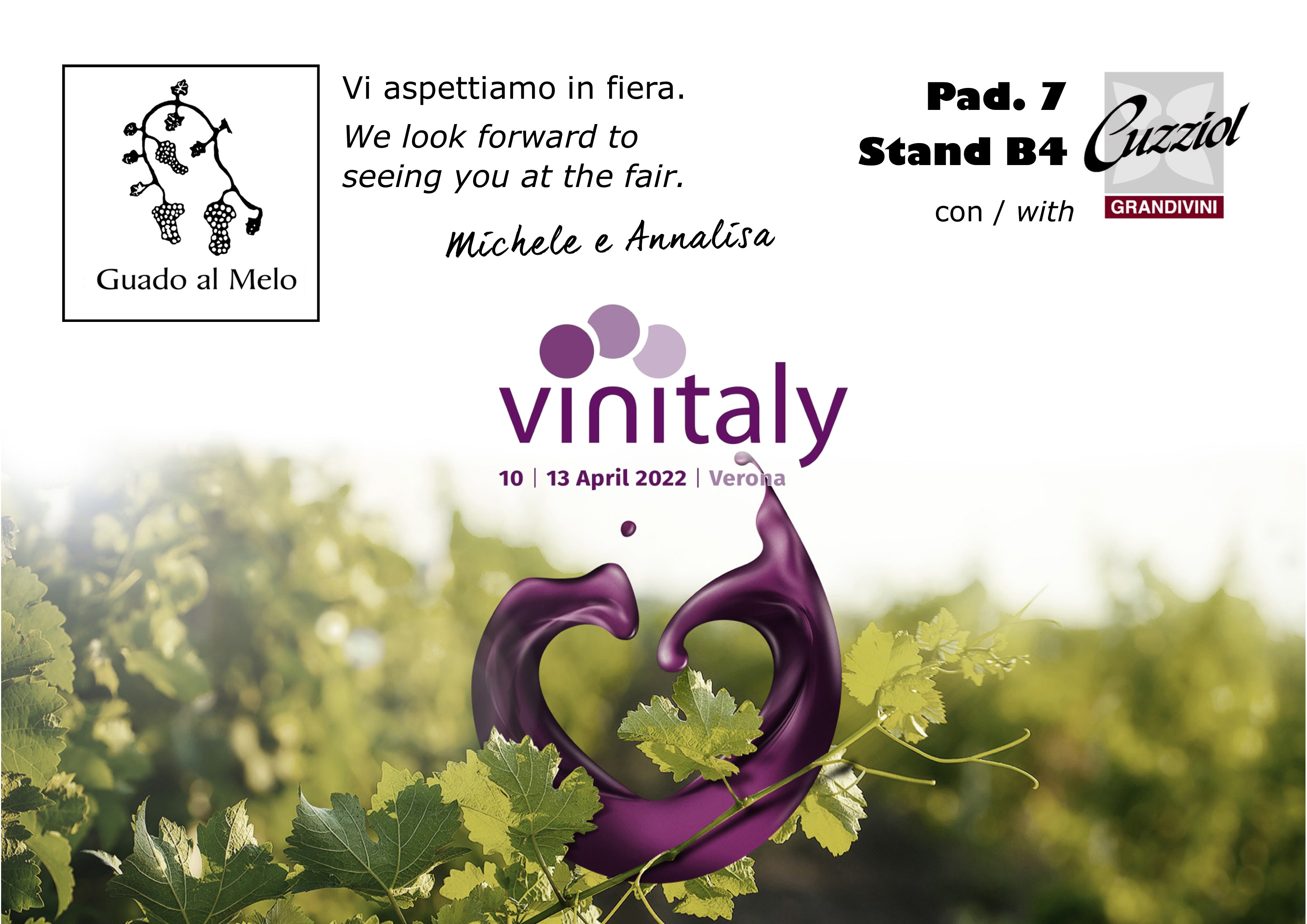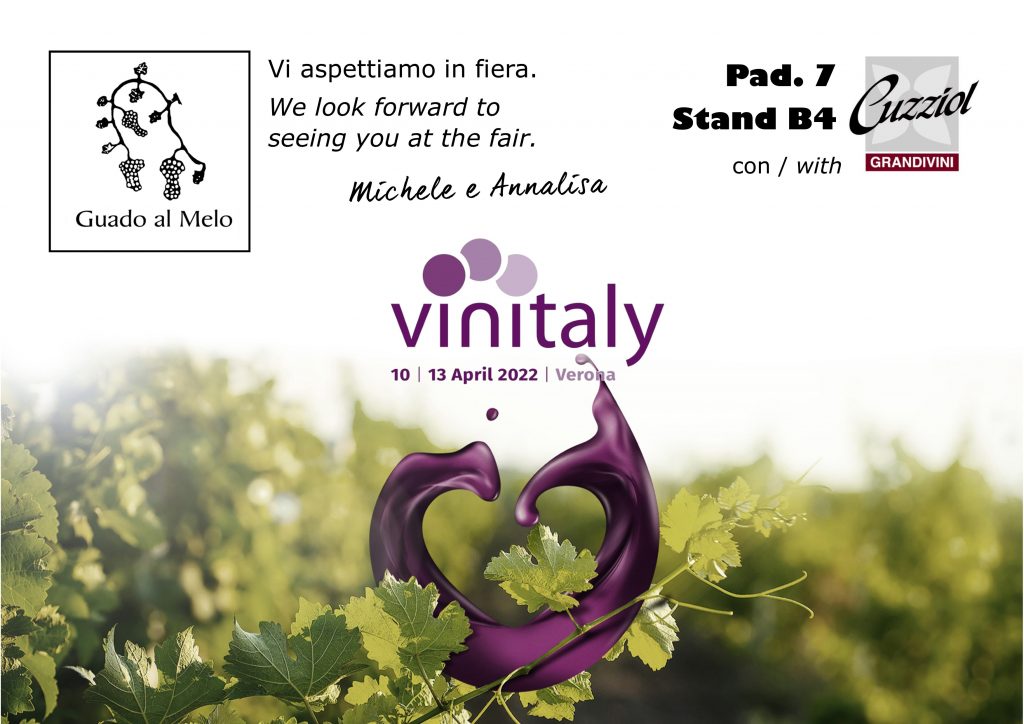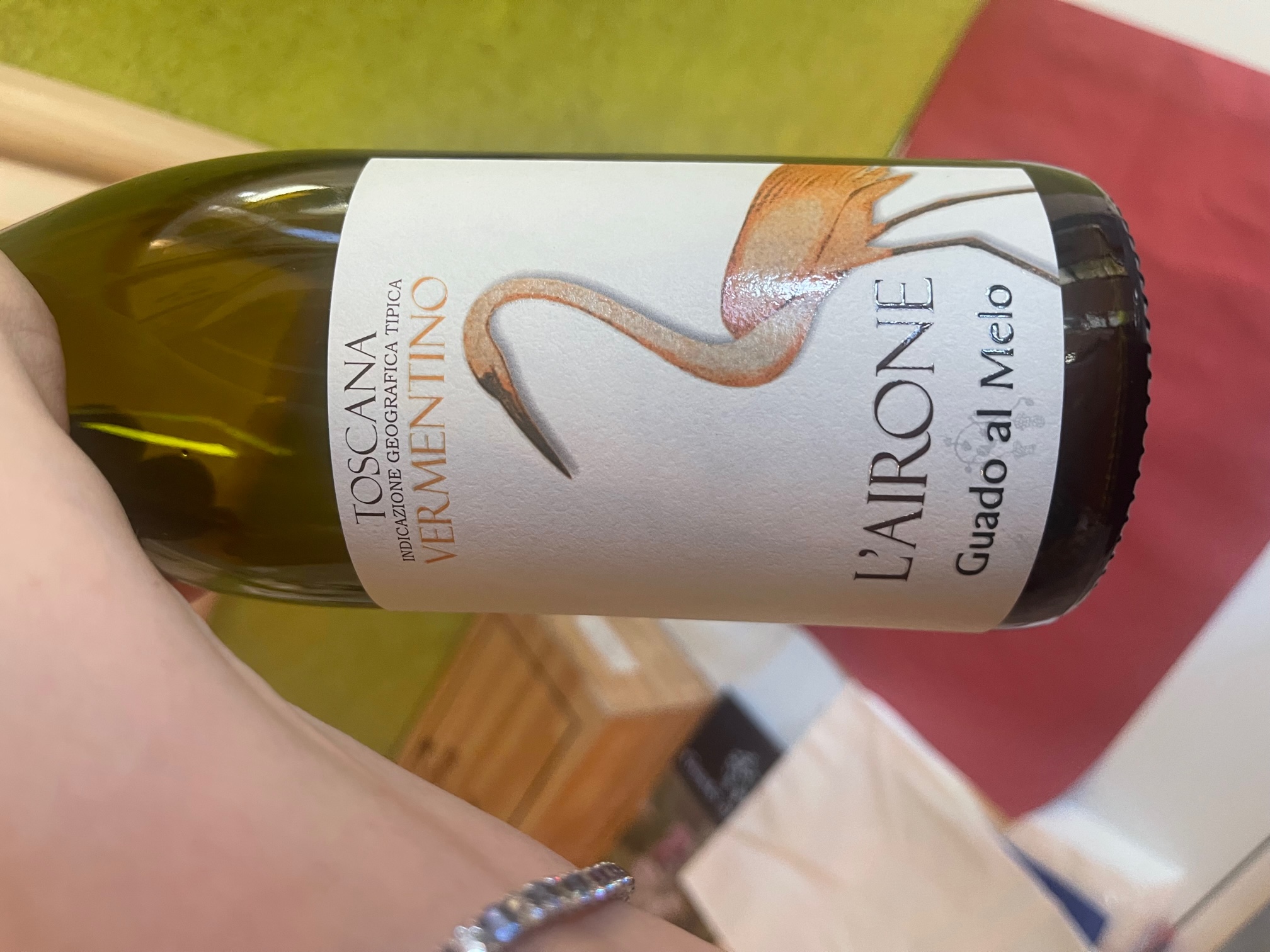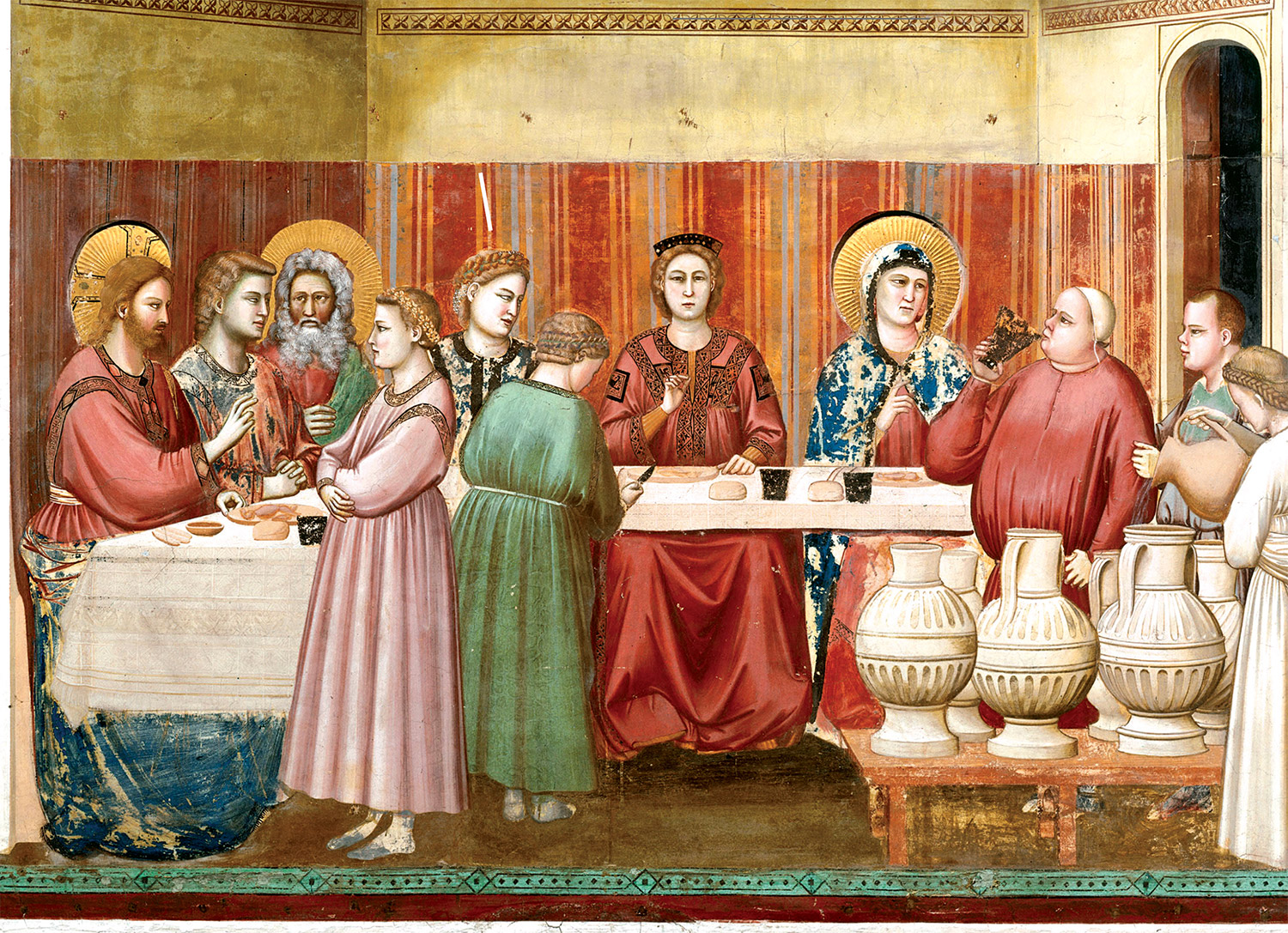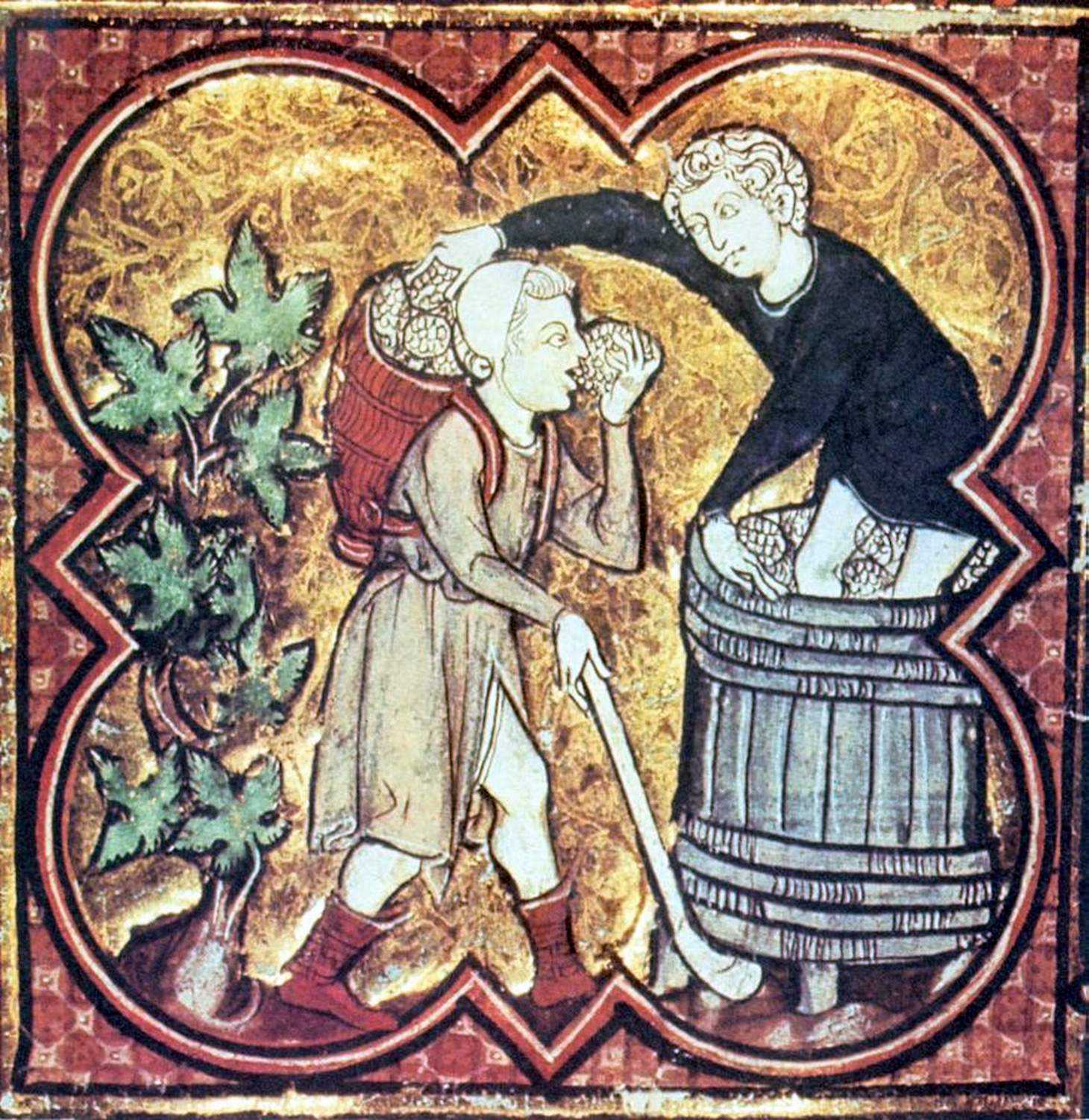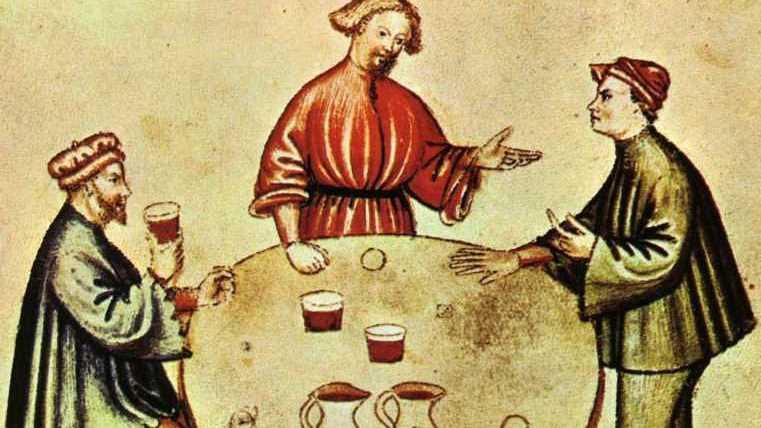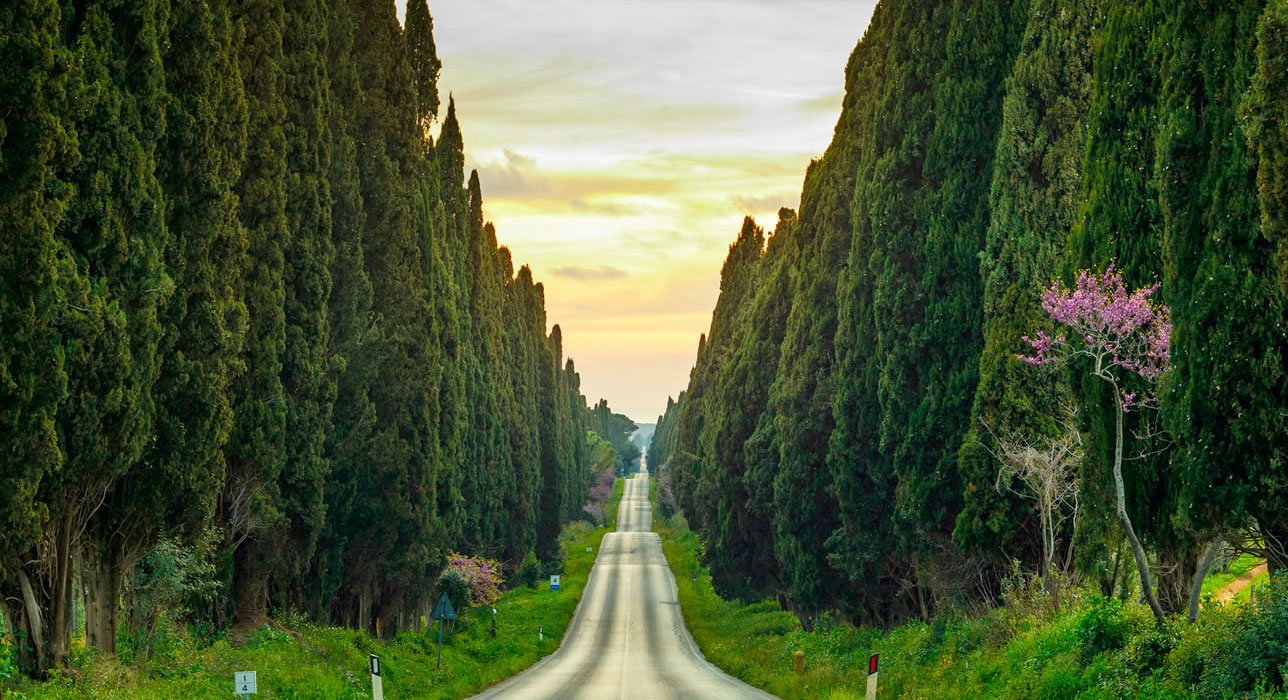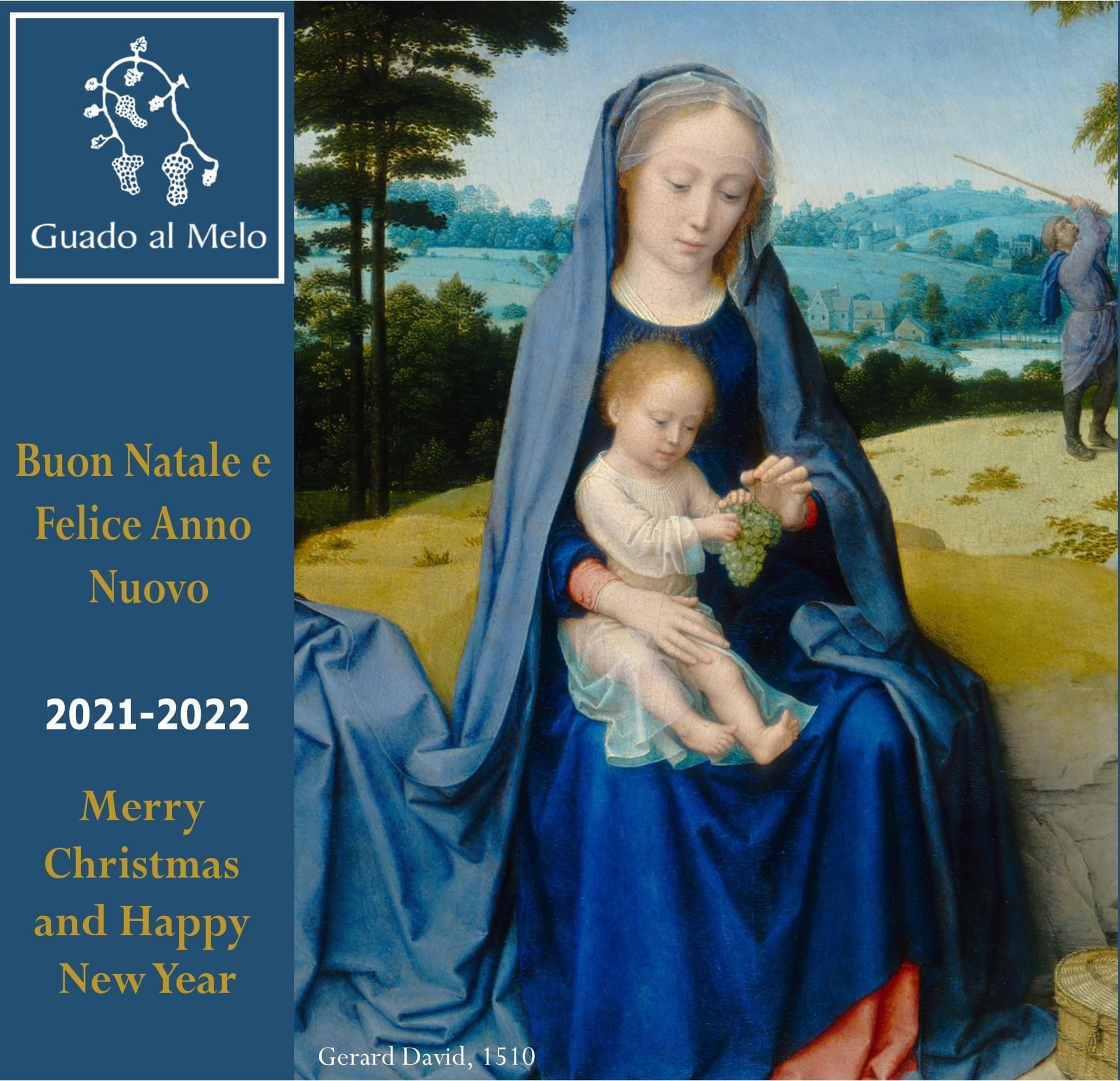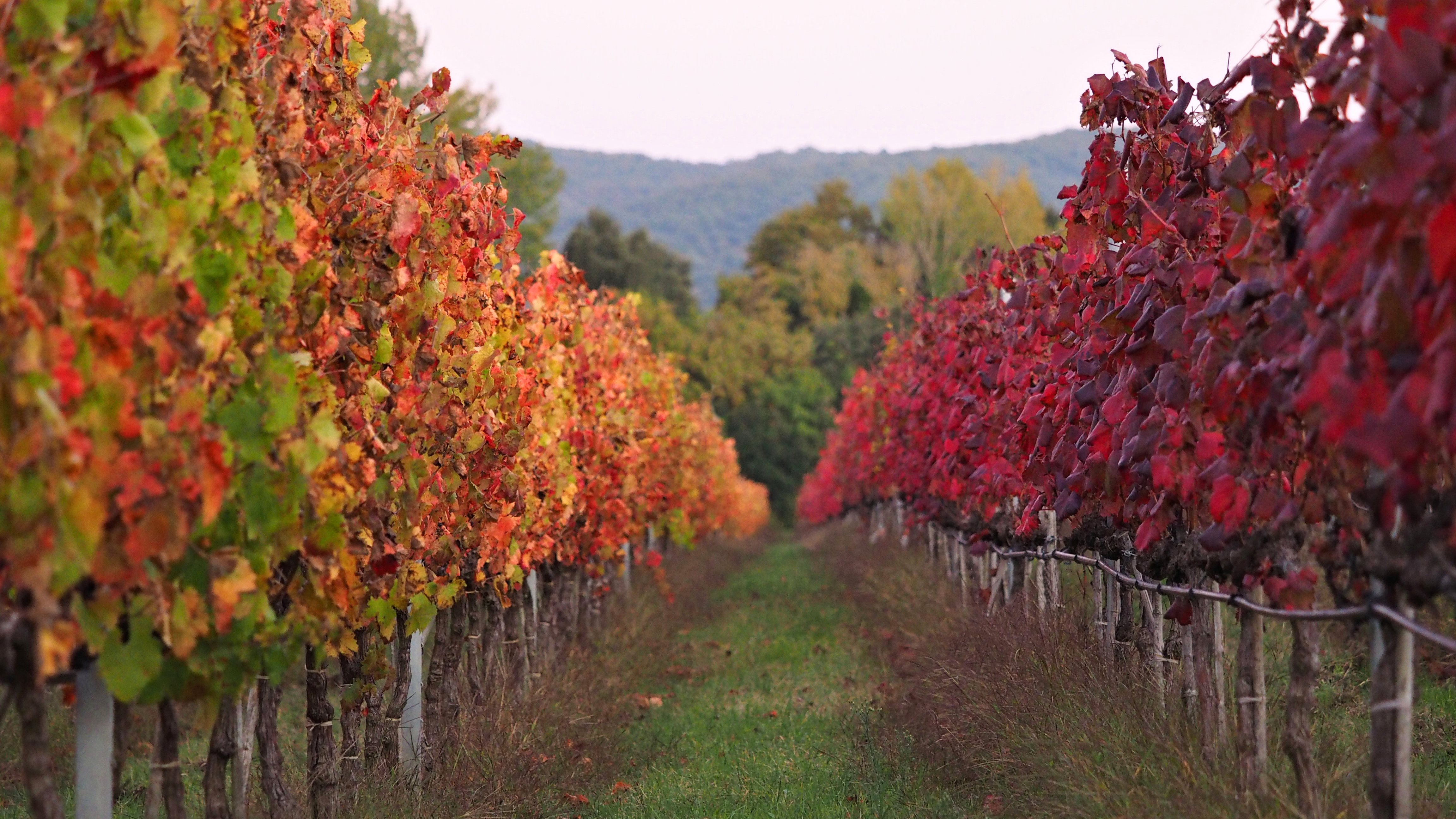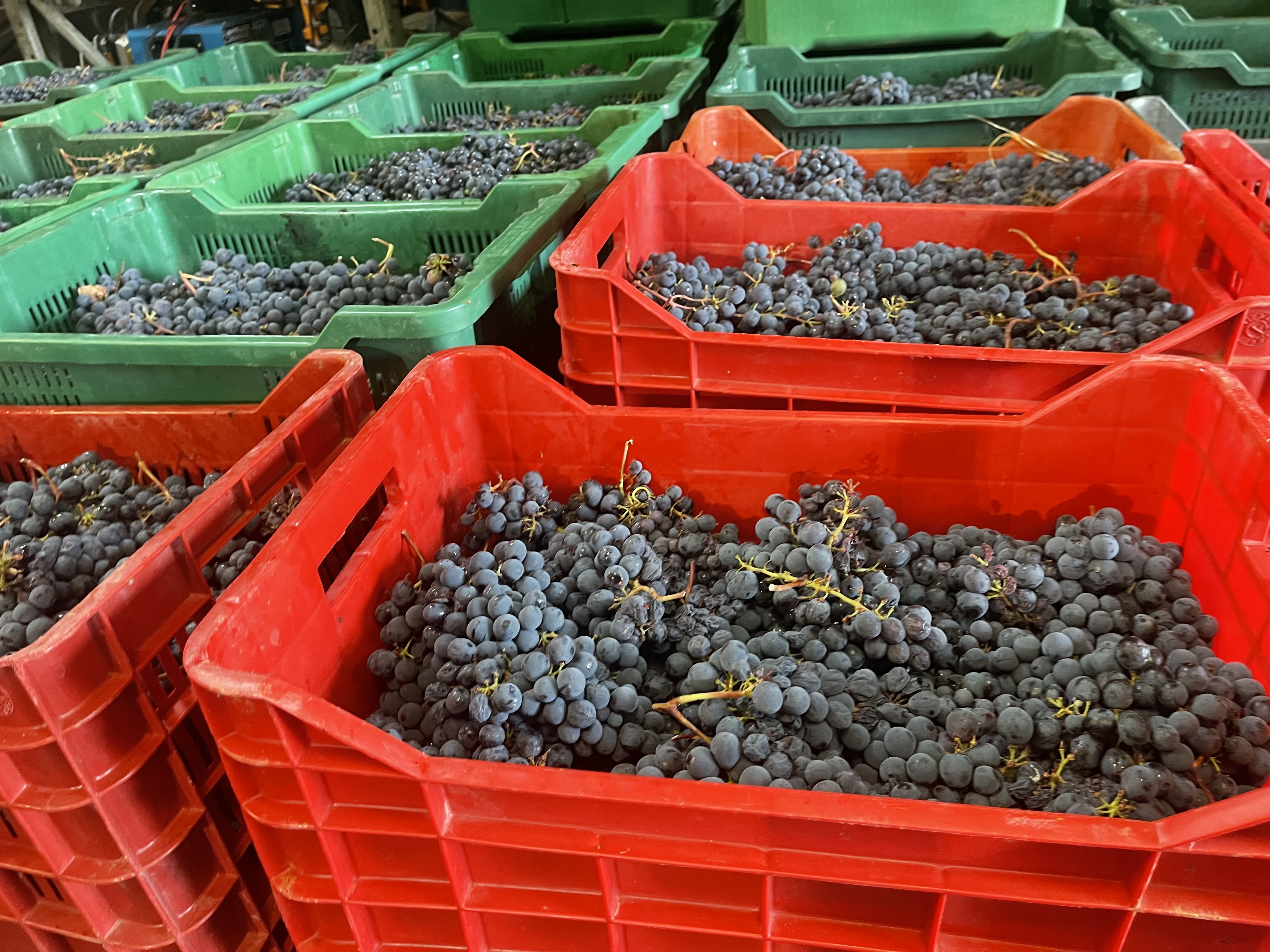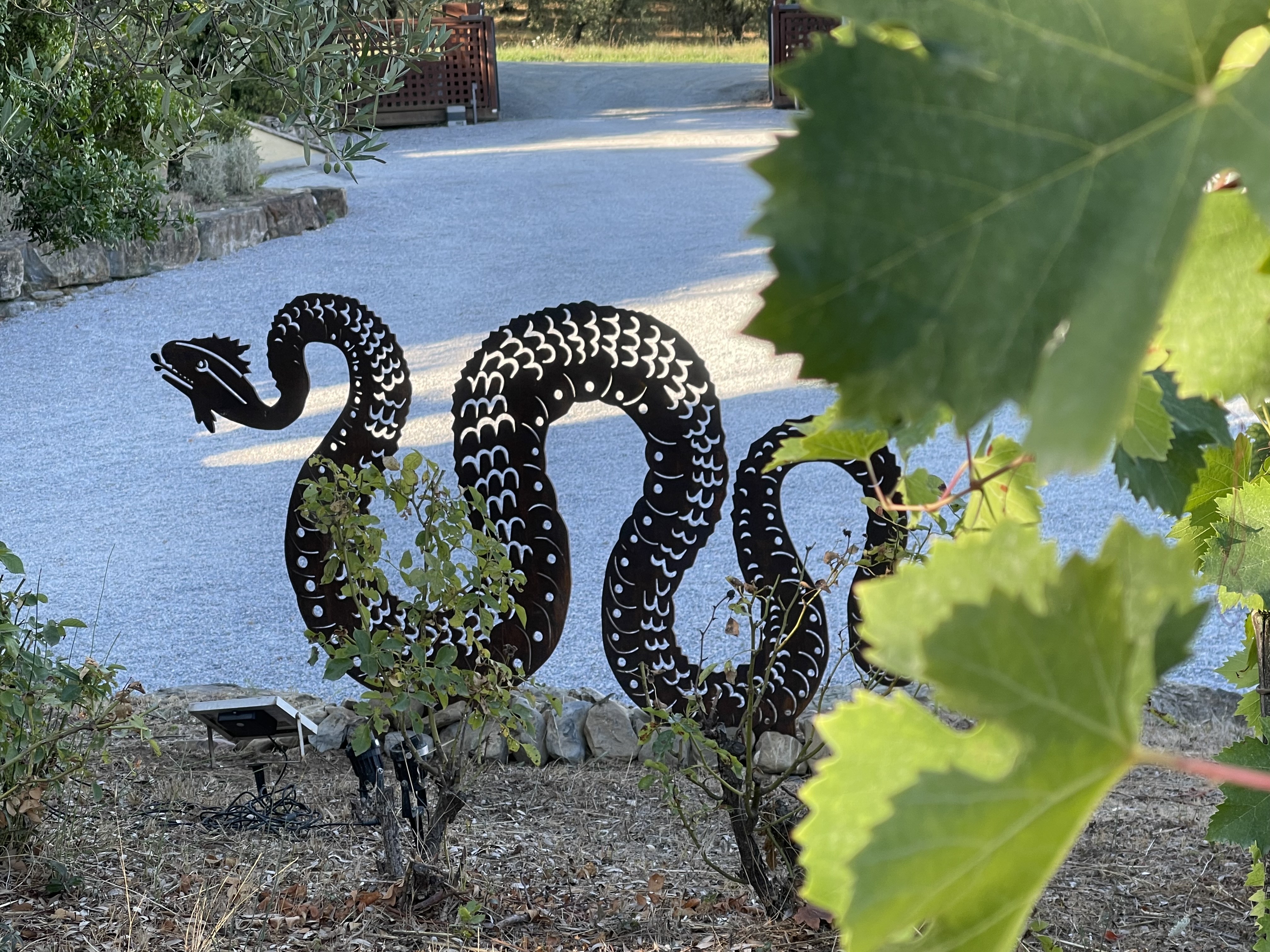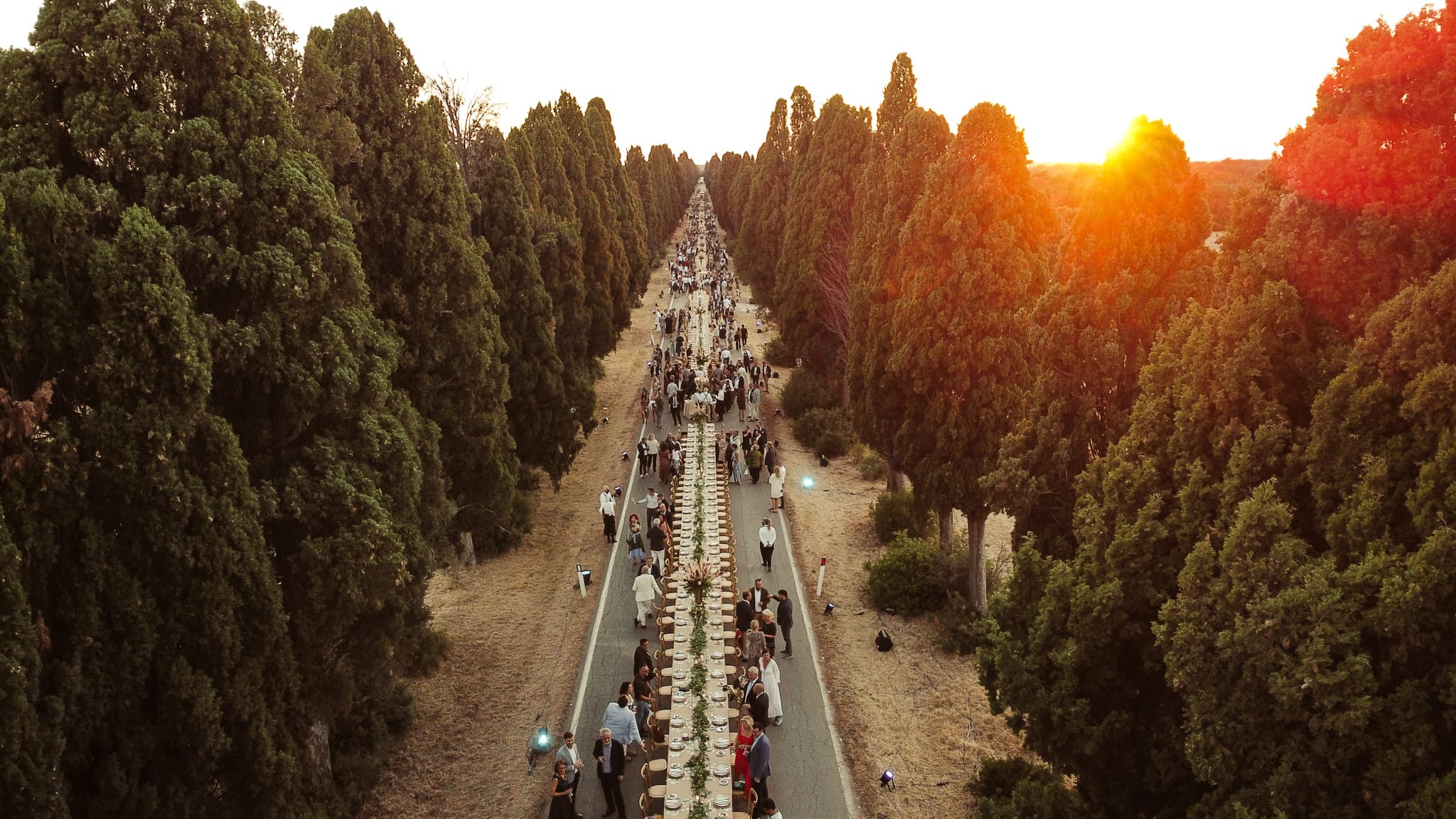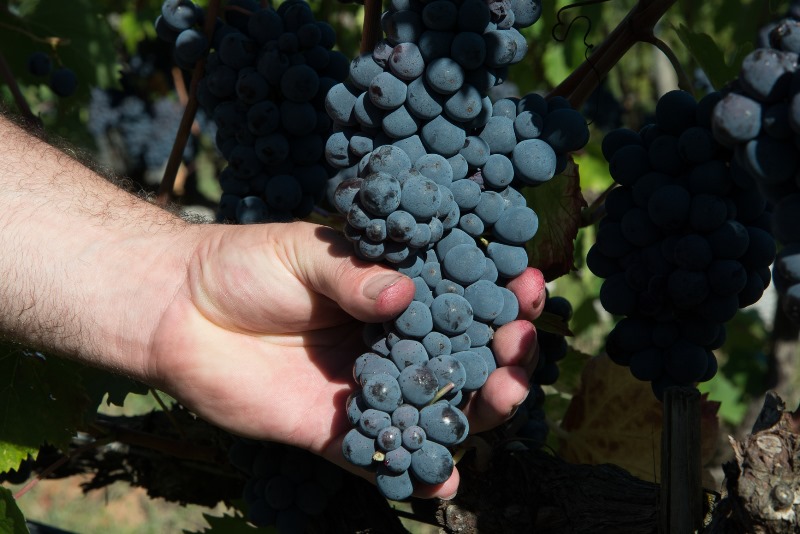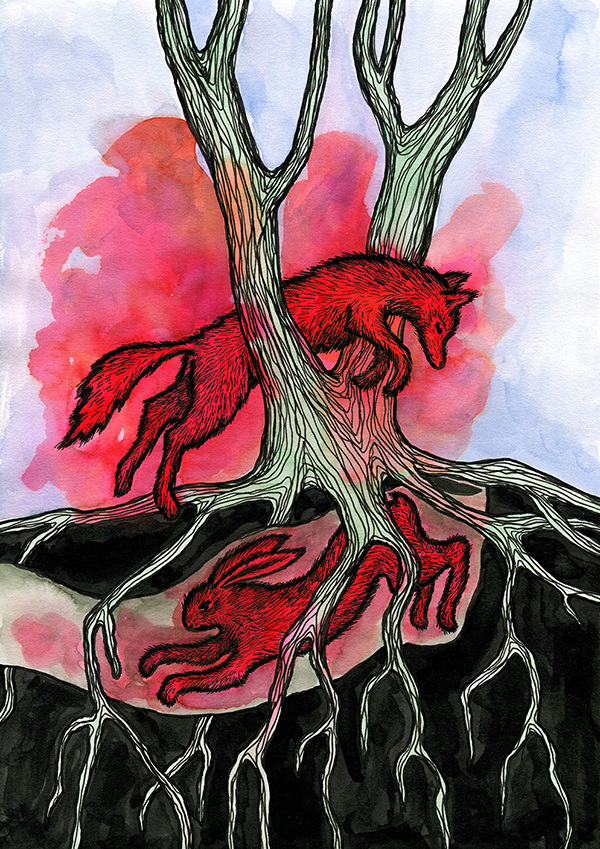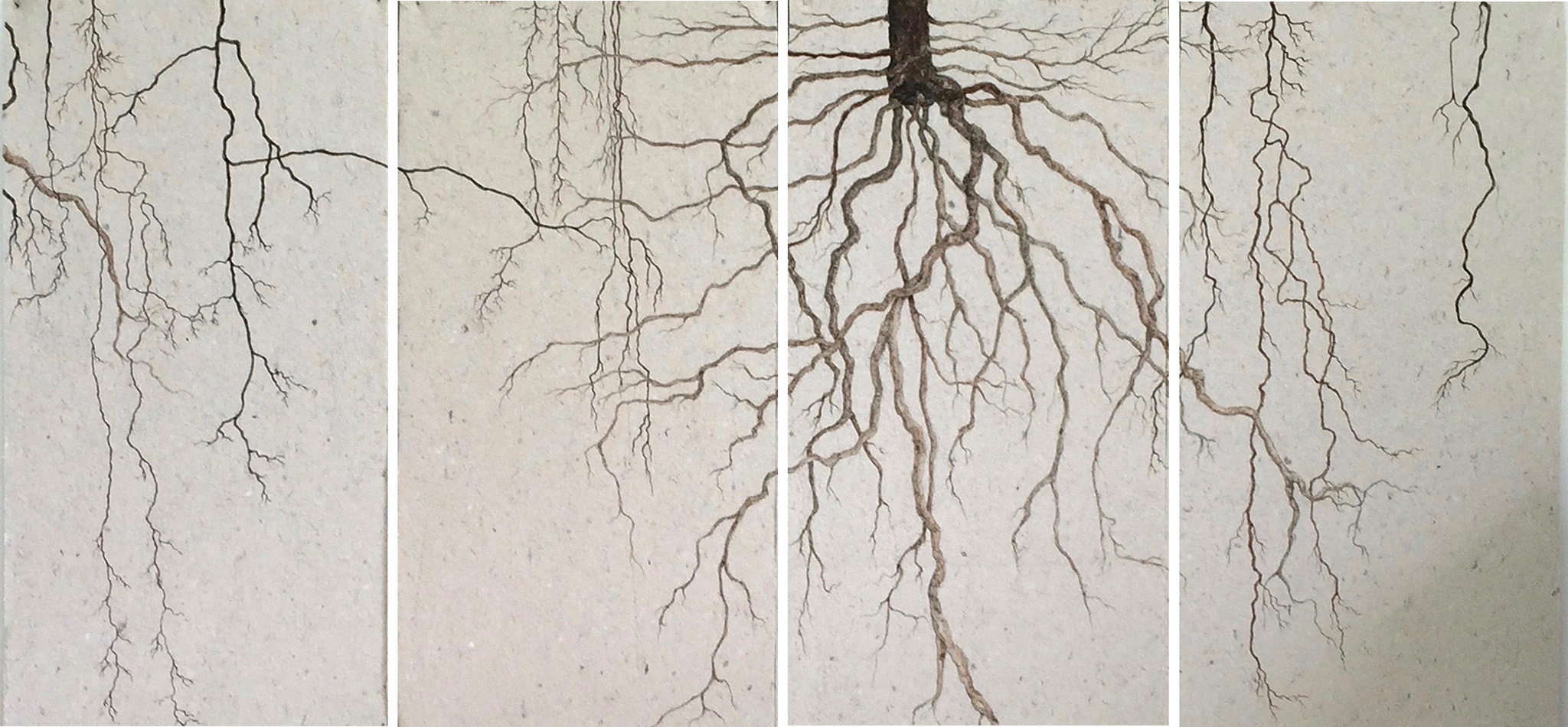Gambero Rosso Oslo Feb. 15th
Michele sarà a Oslo col Gambero Rosso, con i vini premiati, in particolare l'Atis 2019 che ha ricevuto i TreBicchieri.
Michele will be in Oslo with Gambero Rosso. He will present the prized wines, expecially Atis 2019 what won the TreBicchieri Award.
GAMLE LOGEN
Grev Wedels plass 2, 0151 Oslo
TASTING
14:00 - 16:00 | TRADE TASTING
17:00 - 19:30 | CONSUMERS TASTING
15:00 | TOP ITALIAN RESTAURANTS AWARDING CEREMONY
MASTERCLASS
18:00 - 19:00 | ITALY IN A NUTSHELL

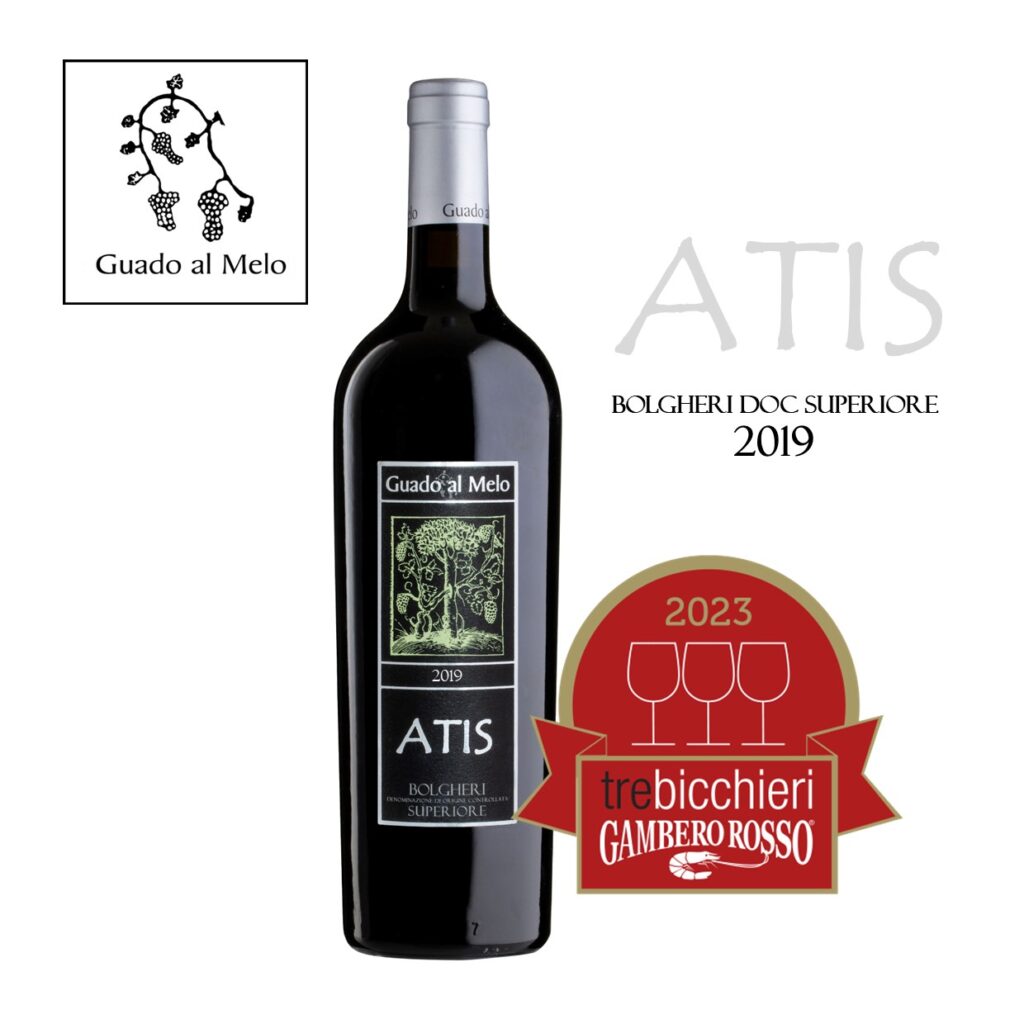
BuyWine 2023
Michele Scienza sarà presente al BuyWine 2023 con i nostri vini, fiera dedicata agli incontri B2B con importatori esteri.
Michele Scienza will be at BuyWine 2023 with our wines. It's a B2B fair for impoters.
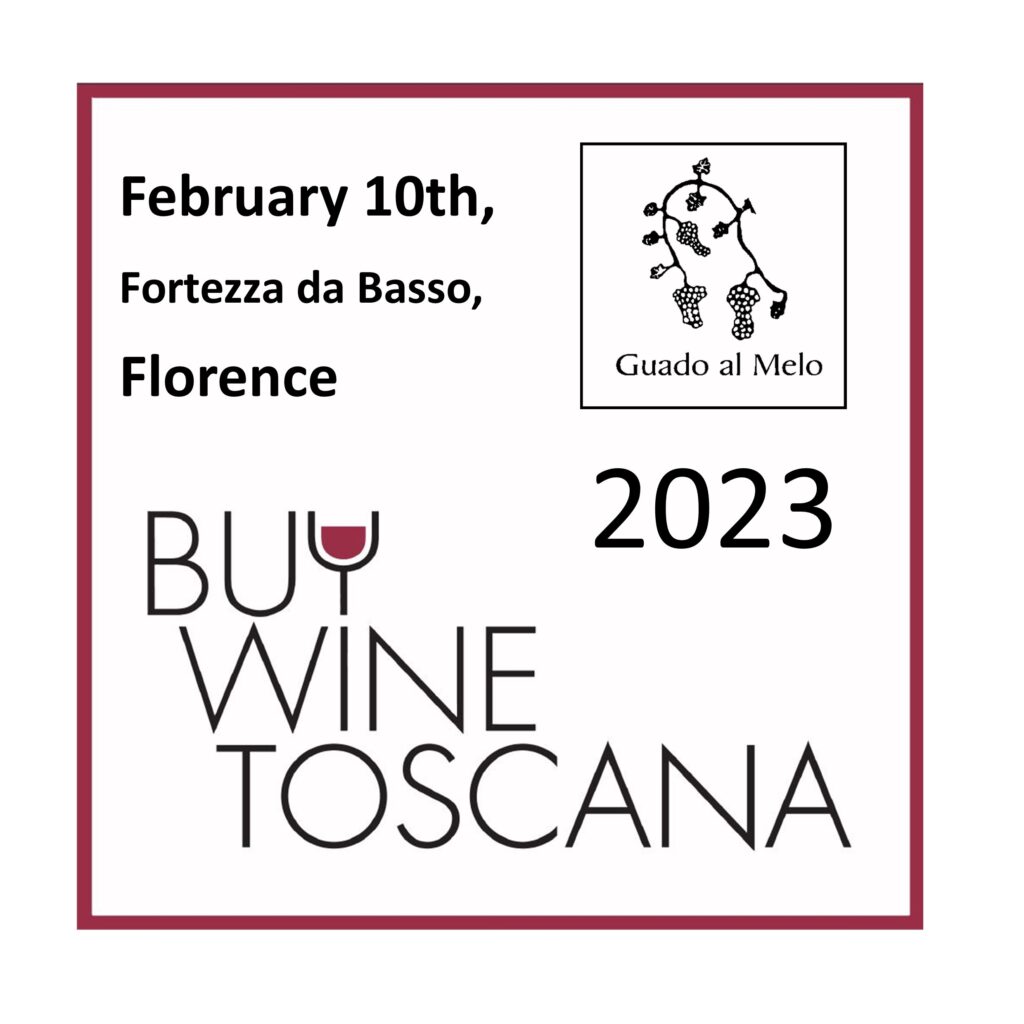
Merry Christmas and Happy New Year - closed for holidays from Dec. 17th to Jan. 8th (included)
After a year without ever stopping, we need some holidays. We will be closed from Dec. 17th to Jan. 8th (included).

I found a new image of the Madonna and Child Jesus with a bunch of grapes. It is by Fra Angelico (1425).
Michele and I send you our best wishes with it, even though we know it's not an easy time. Between the world that "burns" and personal difficulties, what saves us is always and only love.
Merano Wine Festival 2022
Si avvicina l’evento del Merano WineFestival 2022. Michele ed io, Annalisa, saremo lieti di incontrarvi nell’occasione, nei giorni 4 e 5 Novembre, venerdì e sabato, al tavolo n. 69, nella Galleria al primo piano, dove ci sono le aziende toscane. A presto!
The Merano WineFestival 2022 event is approaching. Michele and I, Annalisa, will be glad to meet you on the occasion, on 4 and 5 November, Friday and Saturday, at table no. 69, in the Gallery on the first floor (where the Tuscan wineries are located). See you soon!
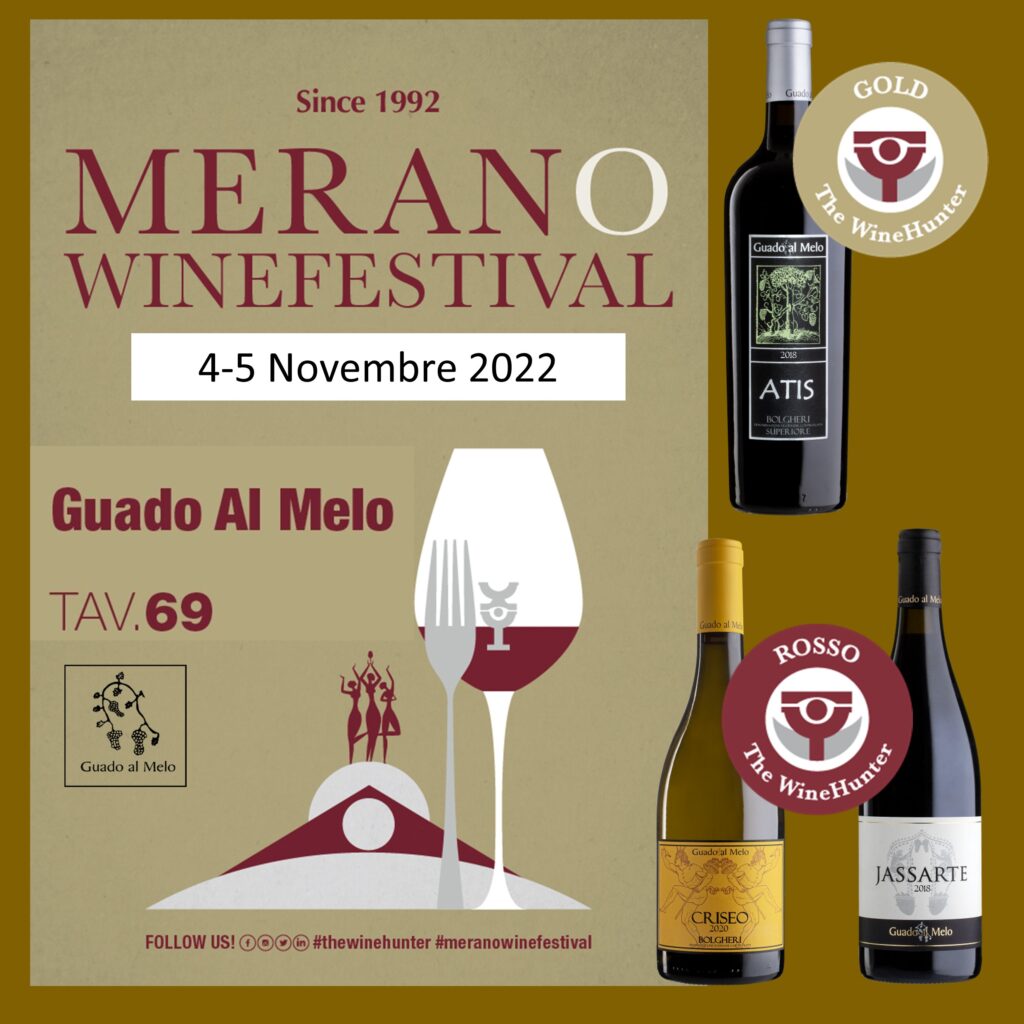
Not only Atis: Gambero Rosso's awards for the other wines
After the happiness of the TreBicchieri at Atis, here there are the awards for our other wines. They are no less important. The TreBicchieri shine but also
appearing in the guide with 1 or 2 Glasses is already a great result.
In particular, awarded with the 2 Glasses:
Criseo Bolgheri DOC Bianco 2020, alas already finished (only a few remain
bottle in the cellar). The new vintage 2021 will be released in June 2023.
Rute Bolgheri DOC Rosso 2020, forthcoming
Awarded with 1 Glass, the Jassarte 2019.
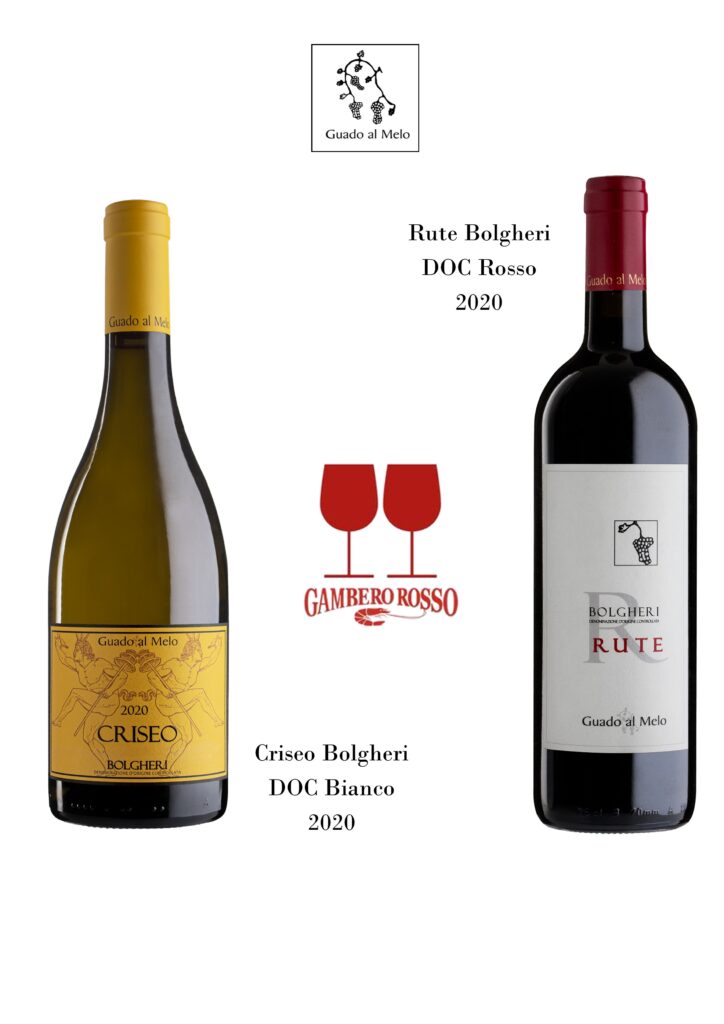
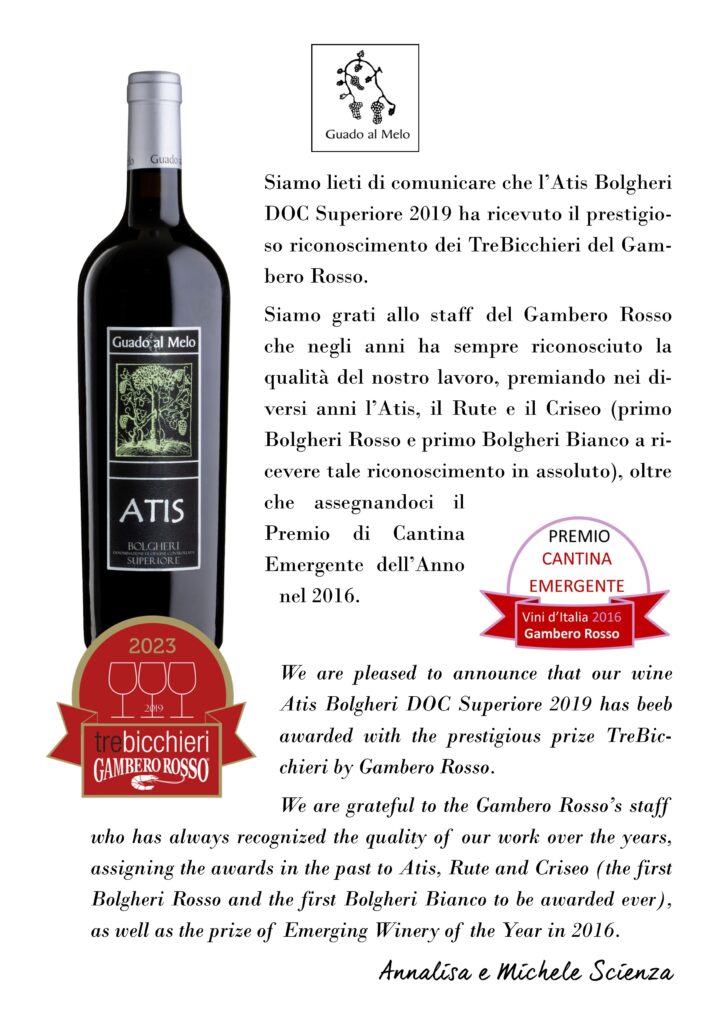
Attilio at Taormina Gourmet: how will be the future wine?
Attilio will be involved in the events of Taormina Gourmet, an important Sicilian food and wine event.
On Sunday Oct. 23, he will hold a masterclass in which he will talk about the evolution of wine, presenting 10 innovative wines. There will be our Criseo Bolgheri DOC Bianco 2020, an ancient wine, but at the same time incredibly modern.
The current challenges require the world of wine to rethink many choices that have limited the sector in its ability to interact with the environment and the climate change: sustainability, use of the best varieties for a territory and not those of fashion, field blends or cellar blends to create perfect balances in a natural way, ... How many interesting topics!

TreBicchieri to Atis 2019
We warmly thank the Gambero Rosso staff for the recognition. Decidedly, Atis is a unconventional Bolgheri Superiore, a great example of artisan wine from a small family winery.
It comes from the wisely complex blend of selected varieties and micro-particles of our vineyards.
However, it still needs a few months of bottle aging, then it will be perfect!

Antillo 2021: the new vintage is ready!
We're ready: here there is the technical sheet and a small presentation in video
Antillo 2021 has a fresher and more fruity taste than the usal idea of a Bolgheri wine, with a hint of spice. It is a short-aged wine, that is not too demanding but very fine. Antillo brings us back to the past traditions of our territory, due to the prevalence of Sangiovese in the blend.
Few people remember that wine production here is much older.
Unfortunately, it was the twentieth century, before the rebirth, the most difficult period for the local wine, due to the phylloxera. The parasite hit our coast especially from the 1920s and stopped the flourishing local production. It dropped to an all-time low in the middle of the century, replaced by olive trees and partly also by the production of fruit and vegetables. Then, the wine production resumed its rise, till the extraordinary evolution it has led up to our time.
Until the arrival of phylloxera, the territory was enjoying a magnificent moment for wine, after the reclamation of the late eighteenth and early nineteenth centuries. There had been a notable expansion of production and the local wines were praised by Giosué Carducci's famous odes.
Read more in this article.
Note: it is customary to say "the wine from Bolgheri", because the Denomination is called Bolgheri and, speaking of wine, this is the name known to most. However, let us remember that Bolgheri DOC wine is produced in the territory of the Municipality of Castagneto Carducci. If we are talking about geography, it would be more correct to say "the wine from Castagneto" for this reason. After all, it is the same thing (or almost, because non-DOC wines can also be produced in the territory).
The WineHunter Award to Atis, Jassarte and Criseo
The Wine Hunter is the award linked to the Merano Wine Festival.
Thanks so much!
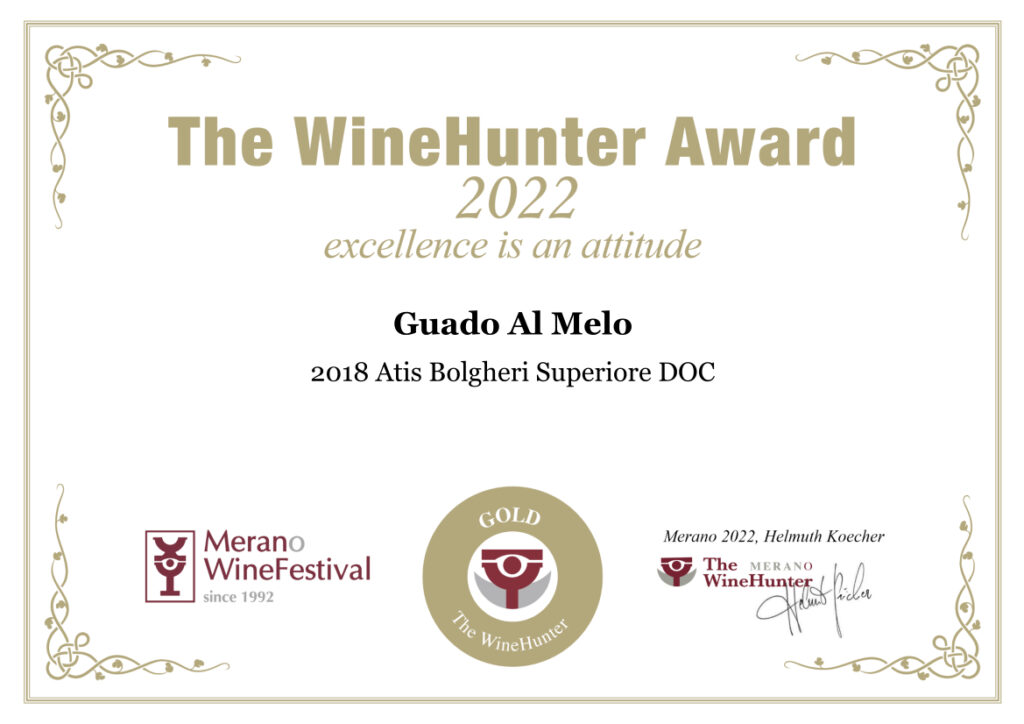
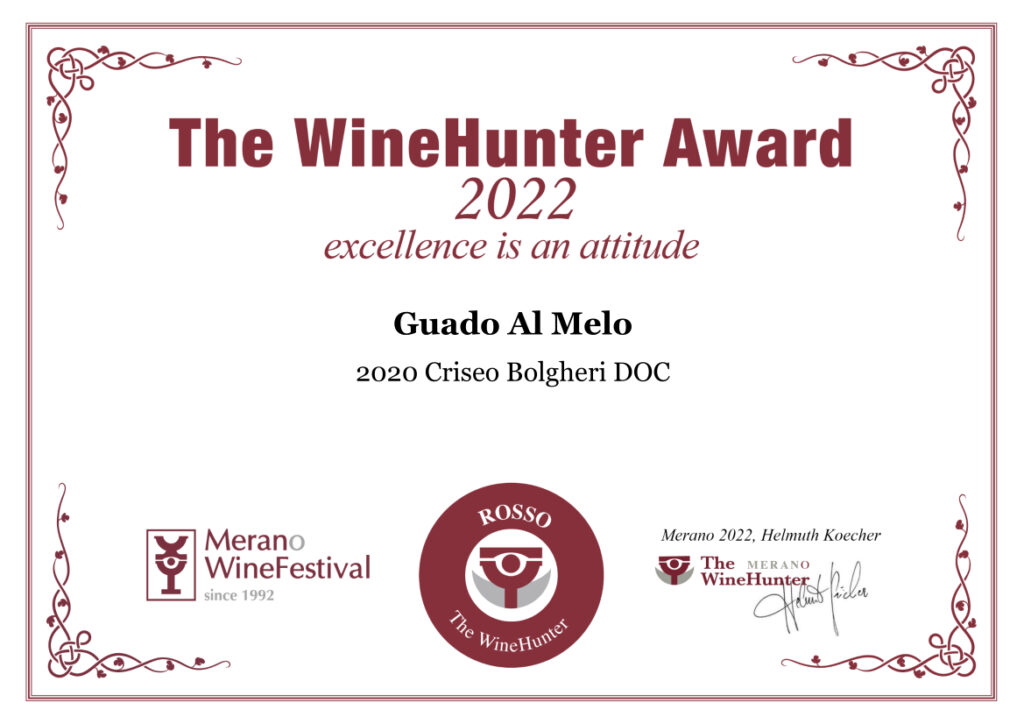
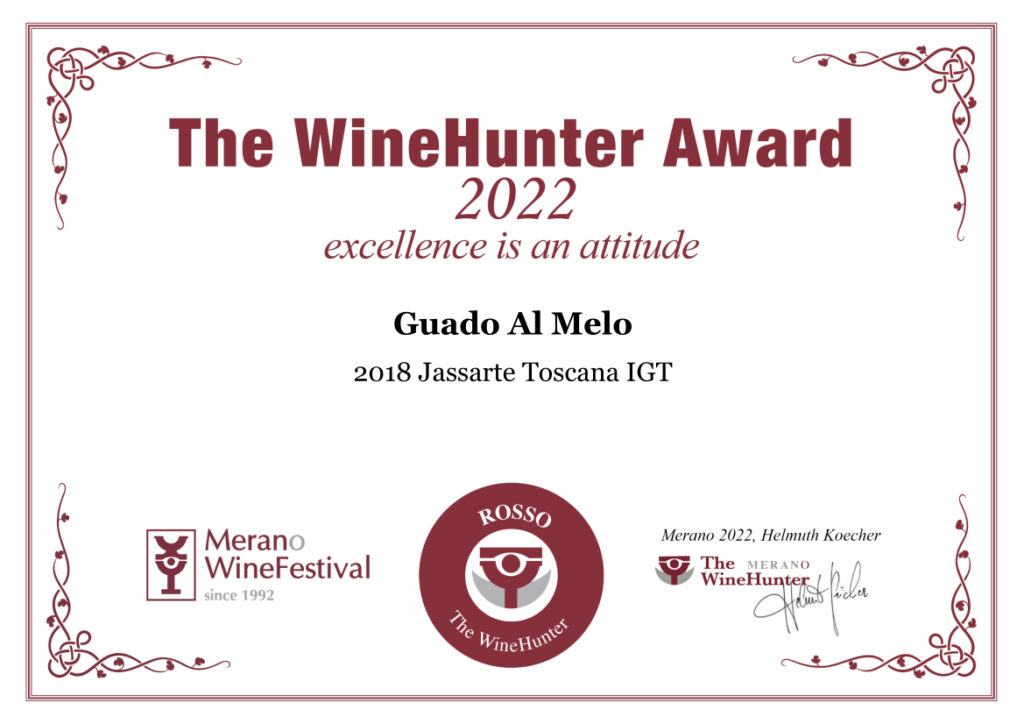
Very good Antillo for the Tuscan Sommeliers
Thanks so much to the Tuscan Sommelier Association: Antillo is one of the best entry level Bolgheri Rosso wines.
Antillo 2020 is out of stock in the winery but you can find it in the best wineshops and restaurants. The new vintages 2021 will be ready on September.
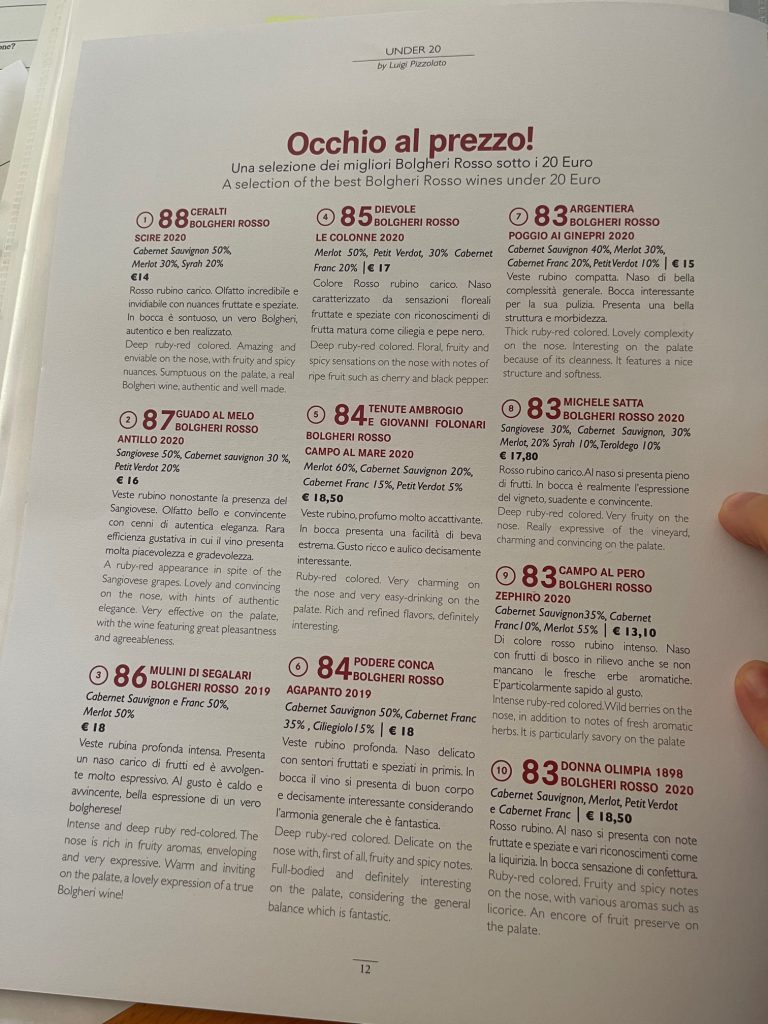
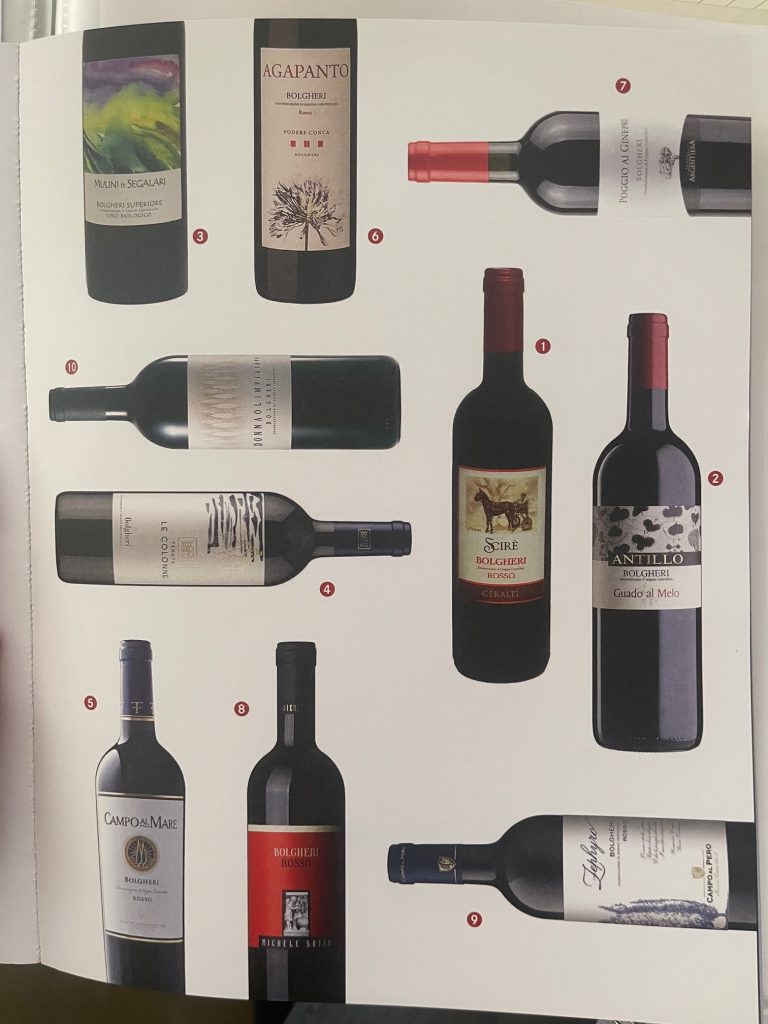
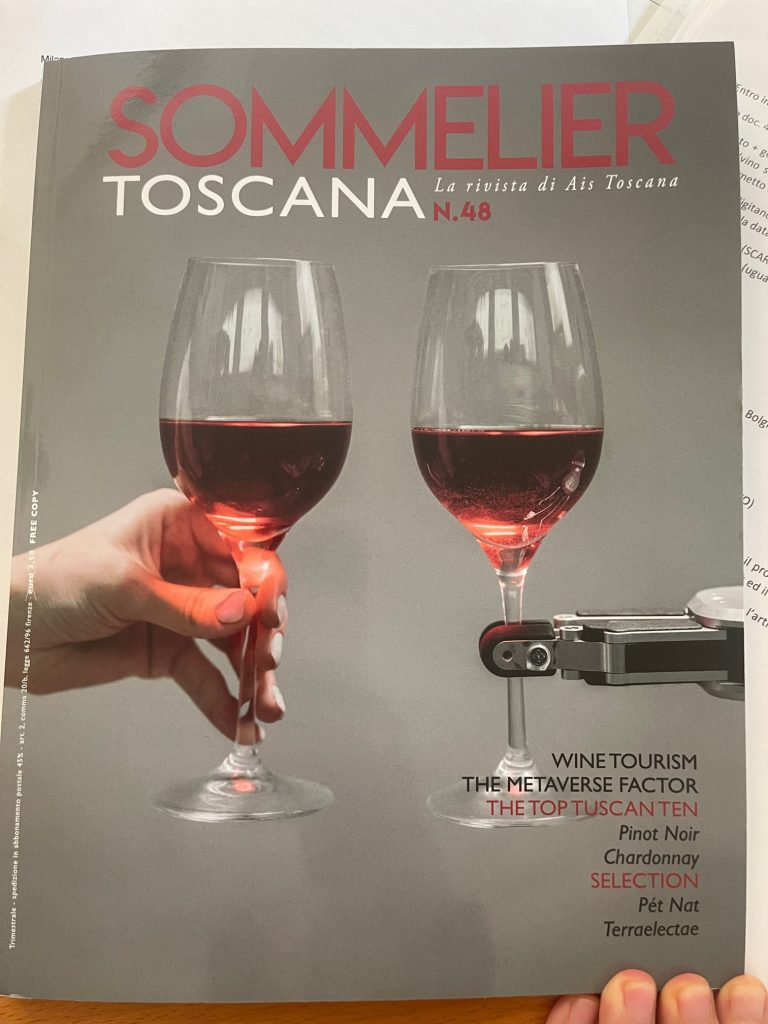
WineCritics, great Jassarte and Criseo!
Thanks so much for the great ratings!
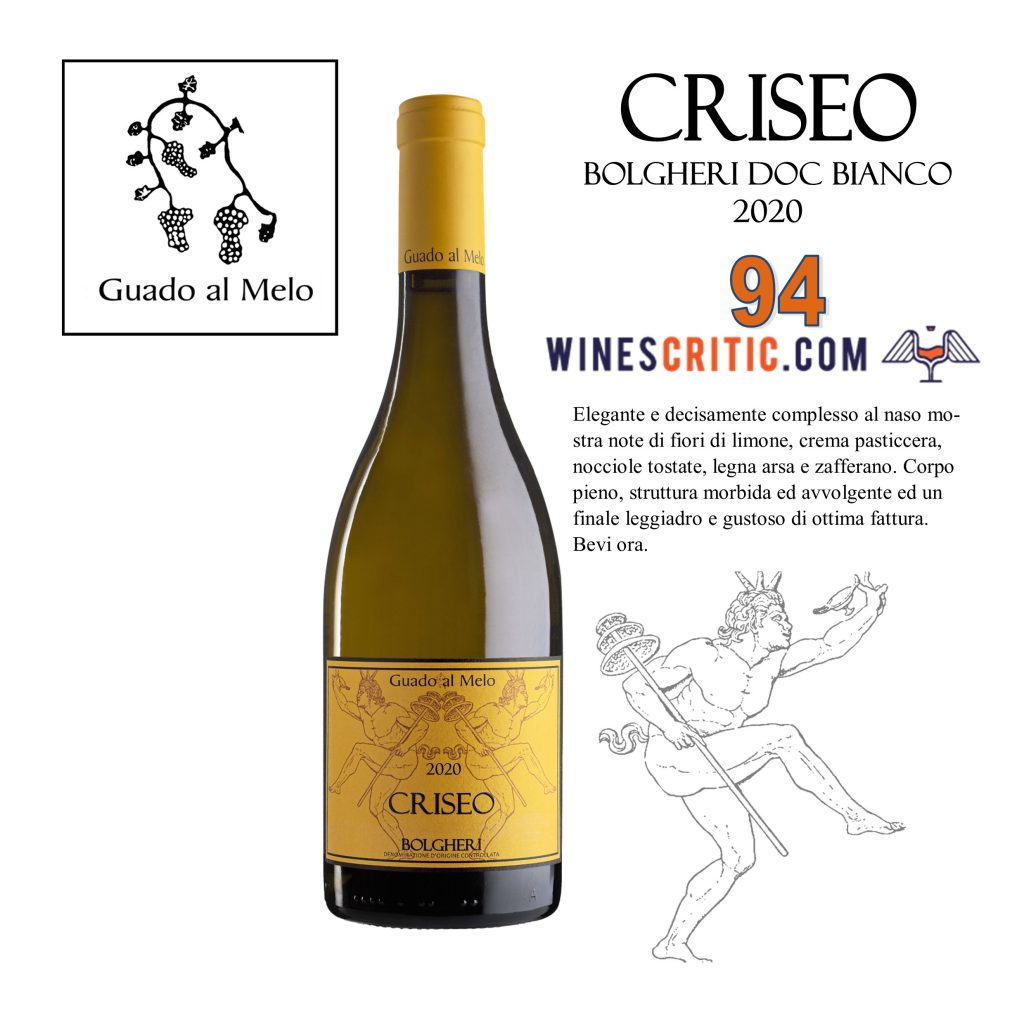

Wine Advocate: good but a little crazy
Many thanks to Monica Lerner for her appreciation of our wines, especially Atis and Jassarte. It is corious that this good American journalist always writes interesting comments for us, between the astonishment and that sympathy that is attributed to people what you consider a bit crazy 😊.
Last year she wrote that we are a very creative winery. This year she writes: "there is a bit of mad science here, but that’s what makes them so much fun".
May be she thinks we are a bit crazy to make counter-current choices in the world of wine which often prizes the homologation?
So, crazy or brave that we are, we consired her comments as a enormous compliment. We hope to have her as our guest as soon as possible, to have even more fun! (and to tell her about the experimental research and the rediscovery of the ancient Italian traditions behind these choices of ours)
Anyway, thank you very much, Mrs. Lerner, we really appreciate that you have tasted and reviewed our wines.
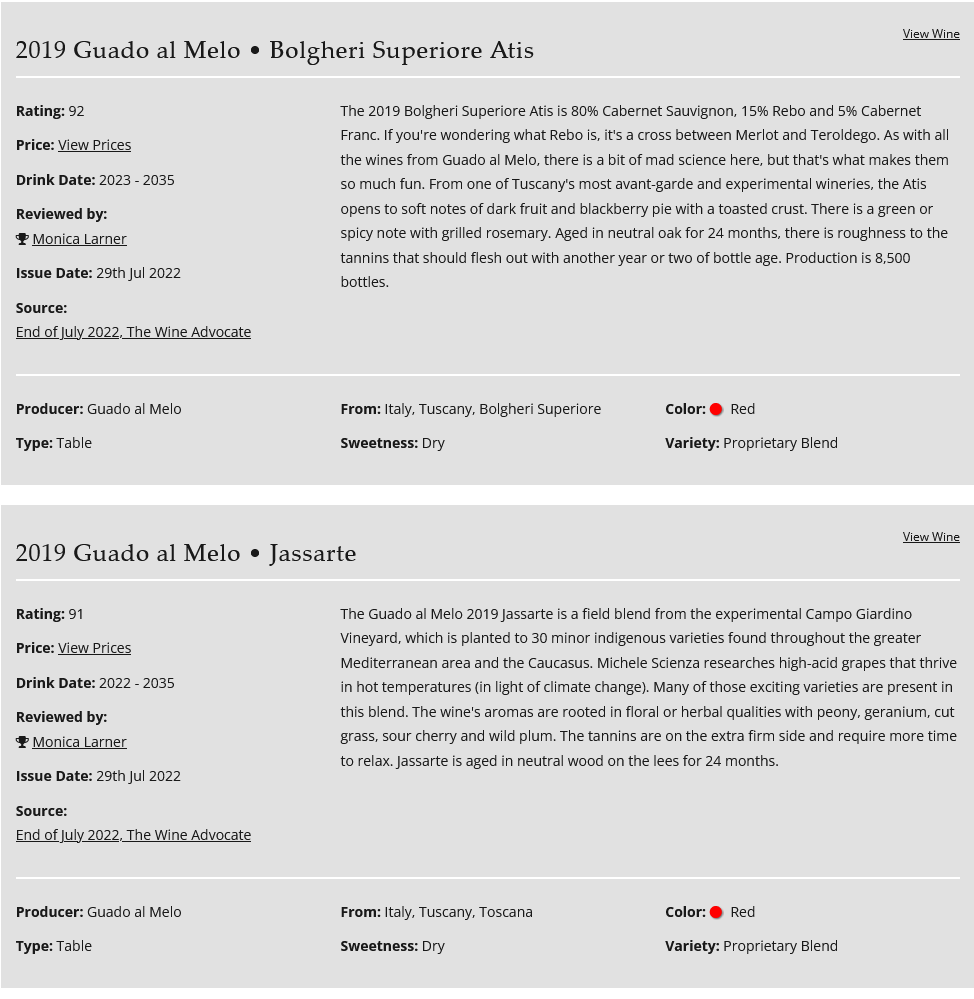
We're certifing our wines as sustainable
Be the change you want to see in the world.
(Gandhi)
I am glad to inform you that with the 2022 harvest our wines will be certified for the production of sustainable wine, according to the single sustainability standard set this year by the Italian Ministry, with the SQPNI mark (National Quality System of Integrated Production). The logo is the nice bee you see above, very evocative of a winegrowing that respects the environment and health. However, do not stop at this somewhat naïve appearance: there is a very rigorous and solid technical-scientific system at the base, that of integrated viticulture
We don't become sustainable now because we certify ourselves. Conversely, we certify something we have always been doing. Those who know us know that, since the birth of Guado al Melo, we have been working to make it a completely sustainable artisan company (on the management of the vineyard, the bio-architecture cellar, the management of winemaking, the recycling of rainwater, the spreading of the culture of wine and the territory, …). We are sustainable in essence, in our way of life and in the constancy of evolving over time.
Our certification starts with the 2022 harvest. You will therefore have to wait a while to see the pretty bee on our labels. The first wine will be the Airone 2022, which will be released more or less in March 2023. Then it will be all the others.

Is it necessary to be certified? I think that the certification systems can have limits, which is why we have not certified ourselves with systems we did not believe in. If the system is done well, however, it is an extra guarantee towards our customers.
Why only now? We waited for Italian politics to define a single sustainability certification system, based on a rigorous technical-scientific system. He did it late and, as always, in a tortuous and somewhat confused way. However, we are confident that we are at the beginning of a path that will be increasingly fruitful.
It is not our first experience. The Tuscany region has been verifying our adhesion to voluntary integrated viticulture for twenty years. A few years ago we had already participated, as a pilot-winery, in the birth of the first Italian sustainability certification, called Magis. The project, born in 2009, supported by several universities and research centers, was very rigorous. He was recognized among the best in the world by the OIV. Unfortunately, it ended after a few years, because it was too ahead of its time: many wineries pulled out because they did not see a vantage of image.
Sustainability was born from the evolution of integrated agriculture (integrated pest control) in the 90s. A few years later, some national certification systems were born in the wine-growing countries of the New World (first in California, then New Zealand, Chile, South Africa, …).
Italy (and Europe) lagged behind in terms of certifications of sustainability. Until now, there were only the regional regulations of the integrated viticulture, which is very excellent in Tuscany (my region, I have few knowledge of the other Italian regions). Sustainability spread in the society in recent years. Some certifications have thus been created recently, which have benefited from the rigorous system already set up by Magis. This year the Italian Agriculture Ministry has started working to define a single sustainble standard, based on the SPQNI system.
Unfortunately, this delay is due to the fact that in Italy (and Europe) the public debate on agriculture/environment issues has not always been dominated by the rationality, but often by clichés and romantic "natural" practices, perfect for politics or the most superficial media or corporate marketing, but little or not at all effective in the winegrowing.
If we really want to do good for the environment and for ourselves, the essential thing is not to stop at attractive slogans but to work to find truly effective methods that allow us to achieve concrete goals. In fact, despite all this, the world viticulture research has worked a lot in recent decades and many winemakers have kept up with the it.
How the sustainable certification works
The pillars of sustainability are three, closely intertwined with each other: the environmental, economic and social.
The protection of the environment and health in the vineyard passes first of all from the technical-agronomic practices, which are based on voluntary integrated viticulture (which we have always done and which I have therefore told on our website and in some posts here). It includes multi-disciplinary viticultural practices that allow for high quality grapes with the lowest (measured) impact on the environment. Other check points are added to it. Some are related to the work in the cellar: the traceability of each wine from the field to the finished bottle, the containment of the winemaking products (we do not use any), the verification of the absence of residues in the finished wine. Moreover, there is a control of other winery's general parameters, in relation to energy consumption, water saving, and the fate of waste.
If you don't know what voluntary integrated viticulture is, I have written a reminder in the green box. If you know it, skip it.
What is the integrated viticulture? It is the most rational way to solve the environmental impact problems of viticulture. It is not a "philosophy" but simply the choice of the best practices available, taken from tradition and the best innovations, with the aim of minimizing human interventions and the use of each phytosanitary product in the vineyard (possibly up to elimination), maintaining at the same time an adequate quality and quantity of the grape (and wine). Therefore, a practice is accepted only if, at the same time, it satisfies two conditions: it works well and with the minimal impact on the environment. It is a system that benefits from decades of study and experimentation. The concept of "integrated pest management" was born in the 70s and has grown considerably over time, with an important leap especially in the 90s.P
Why is it called integrated? Because it considers the vineyard as an integrated ecosystem in which numerous living organisms interact, influenced by the situation of the soil, climate and atmospheric variations. The multidisciplinary approach only, which manages to bring together all the knowledge on these elements, allows for the minimum possible impact in agriculture.
Some key concepts: Among the practices used there is a priority scale. Those that allow the prevention of adversity are always favored first. Where this is not possible, biological control systems are used. If even this is not possible, there is the use of plant protection products, chosen from those that have demonstrated excellent effectiveness and the lowest impact on the environment. They are used the smallest amount possible, only where it is needed. In this way, we can achieve a very low impact, which research is trying to lower more and more. To make decisions, it is essential to collect the data that allow us to understand what is happening in the vineyards (from observation to the collection of atmospheric data, …) so as we promptly intervene with the best methods for that particular situation, only where it is needed. A fundamental principle is the integrated approach: each problem is faced from several fronts, in order to minimize the impact of each intervention. Another basic principle is the damage threshold, that is, there is no need to "sterilize" the vineyard, but it is sufficient that the adversities are below a minimum threshold that does not affect the quality of the grapes.
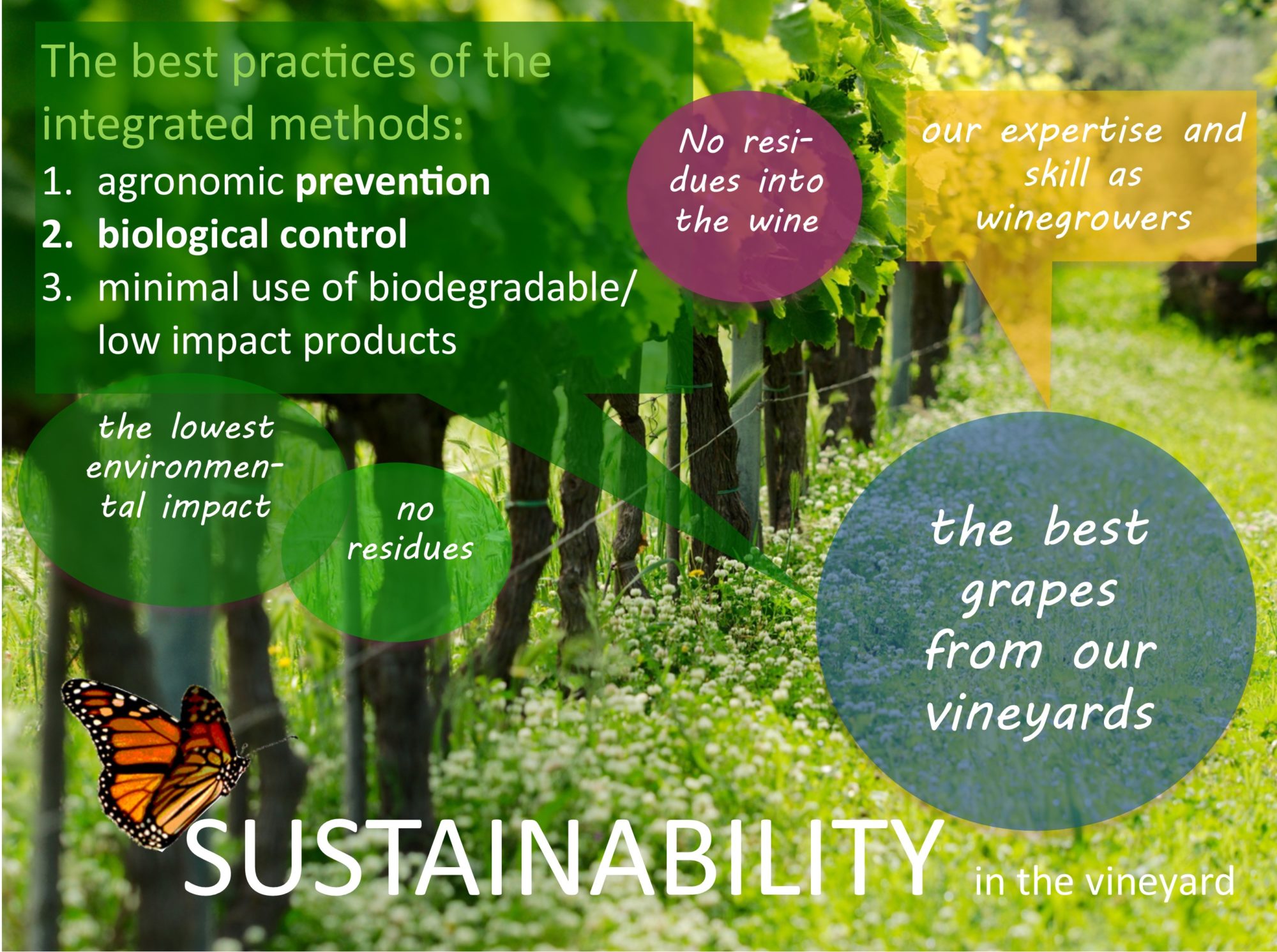
Why is it little talked about ? Honestly, it has always been my question! Even if it is not famous, it is applied by many companies of Italian (and worldwide) winemakers. Above all, I always wonder why wineries, universities, regions and the technicians who deal with it hardly ever talk about it. Or are they not listened to?!?! I have given myself several explanations. It is a complex system, not very suited to the simplicity required by the media and marketing, which want concepts that are not well reasoned, easy and charming. In my experience, I also realized that this system is generally chosen by old-fashioned winemakers' companies, which do not put marketing first but the optimal care of the vineyard, which on average are bad communicators (sorry, but unfortunately this is the case ).
However, it is not enough. Parameters relating to the economic and social sphere are also verified to complete the concept of sustainability. There are a series of checks on the integrity of the winery in relations with its workers, as regards safety and enhancement, as well as in relations with the territory and the rest of the production chain.
What is sustainable viticulture? It is the upgrade of the integrated viticulture. In the 90s, the scholars began to reflect on the fact that it was not enough to consider the impact in the environmental field. A complet sustainability must be integrated with the economic and social aspects.
Economic sustainability. For example, let's assume that I find a cultivation practice that does not have a negative impact on the environment but makes me produce very little product or it is of poor quality, or it costs me a lot to produce it … So, that practice is not sustainable, because it solves one problem but creates many others. Agriculture must give income to the people, otherwise it risks disappearing or it must depend on public funds to survive. It must also offer sufficient food products to meet the needs of the community, both in quantity and quality. In reality, this basic concept has always been inherent in the integrated viticulture, which has always sought practices with the lowest environmental impact but which, at the same time, maintain an adequate qualitative and quantitative level of the grape.
Social sustainability. Furthermore, every human activity must include respect for the workers and people who live in the area, fairness towards suppliers and customers (and the whole chain that is before and after), supporting the local community, maintenance and the spread of the culture of the wine and the territory, …
All these elements must coexist in the sustainable viticulture, or better, we must found the best possible mediation between them.
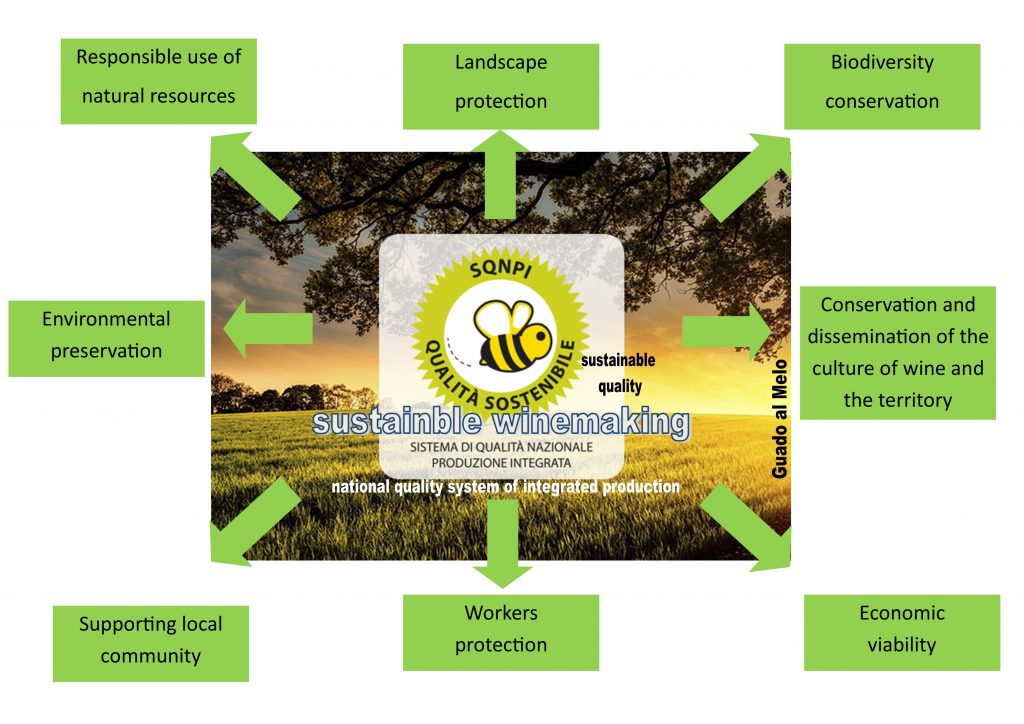
It is a supply chain and product certification. It means, unlike others, that we must demonstrate every year not only to follow some practices, but that there are the goals of the absence of residues in the vineyard and in the wine. So, we can "conquer" the bee on our bottles.
Bolgheri: hills, plains and soils, understanding a territory beyond the commonplaces
I love you, fruitful and pious land, and I admire you,
and I touch you, and I fill my hands with you,
and over you I bow my face, greedy, and
your healthy perfumes, grateful, I aspire;and in you the eye turning, in a short tour
I discover mountains and forests and valleys and plains,
…
(Edmondo de Amicis, Alla Terra)
Often our visitors ask us why viticulture in Bolgheri did not develop in the hills. In fact, it mainly includes the foothills and lowlands. This question is understandable: how many times have you heard that the best viticulture is that on the hills? "Bacchus amat colles", Bacchus loves the hills, also wrote Virgil in the Georgics. Why is it not like this in Bolgheri (and elsewhere)? Because here there is so much sun :-) Let's try to understand better why.
Before answering this question, I invite you to reflect on the fact that, as in many other fields, also in wine there are some rules that may seem general but that, with a less superficial approach, you can understand that they are not exactly valid in all cases. The simplifications (or clichés) aren't rappresentative of the multiform diversity of the wine production. As I have often reminded you, viticulture is always local. The viticultural choices can change a lot between the territories, even between the vineyards. It is the particular conditions of soil, climate, micro-climate and variety that determine the best choices on where and how to create a vineyard, as well as on how to manage it. We must consider them if we want to make a great wine, a local wine with its splendid uniqueness.
Sometimes people tend to generalize using as a reference the choices of successful territories or famous producers or the reality they know best. However, if you approach a territory with prejudices, it becomes truly impossible to understand its peculiarities. The generalization is even more risky for the wine producers: reproducing ottimal patterns from other territories or companies in the vineyards can lead to errors which are then paid. In a suitable territory for the winegrowing, the lack of understanding of the vineyards is the great discriminating factor between the production of a great wine or not. The viticultural zoning studies are used precisely for this, to help producers make the best choices for their micro-realities (not to make quality rankings as is often thought). Bolgheri was one of the first Italian wine territories to do the viticultural zoning studies, carried out in the early 90s and continued until 2004, conducted by the University of Milan under the guidance of prof. Attilio Science.
So, let's go back to the original question. The concept of the higher quality of hillside viticulture was born correctly in territories with continental or similar climates. They are places where water is generally not lacking, indeed they are on average (or very) rainy. In these cases, the valley floor or the plains are places where there is an abundance of water, they are often also humid or even the water can stagnate in the soil. The vine is a very rustic plant but humidity is the worste condition for it. Too much water availability in general leads to an excess of vigor, which is a limit for the wine quality. The humid climates also cause several serious diseases, such as the downy mildew and the molds that affect the bunch. When the humidity becomes decidedly too high in the soil, major problems can occur to the roots and therefore to the plant itself, the rot and the root asphyxiation.
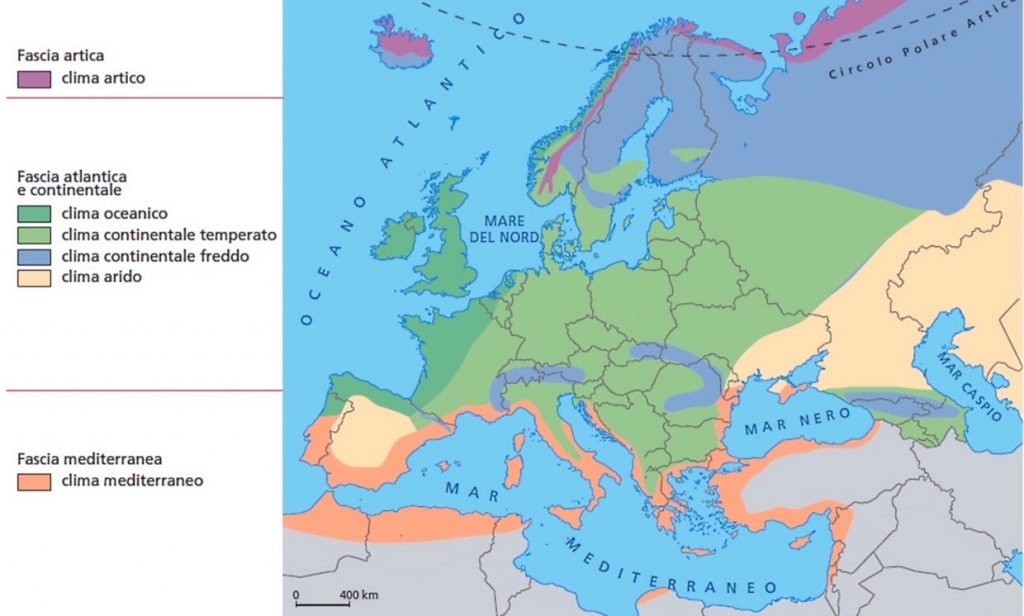
For all these reasons, the sides of the hills are often the most suitable for the vine in the territories characterized by these situations, because these places are the least humid and not too fertile. The problem of soil moisture is avoided: the water flows downwards, so the hilly soils are the most drained and dry. There are also better exposure to the sun, better temperatures and there is no stagnation of humid air. In the past, in reality, the optimal choice of the hill was often guided by other priorities. The most fertile and water-rich soils were reserved for crops essential for food, cereals or other. Given the rusticity of the vine, the leaner and poorer soils were left to it, often those of the hills, where it was difficult to cultivate anything else.
If these considerations are valid for territories such as those just described, it does not mean that they apply everywhere! There may be lowland areas without humidity problems to which these concepts do not apply. I would also like to add that the current climate change may lead to the modification of many consolidated models.
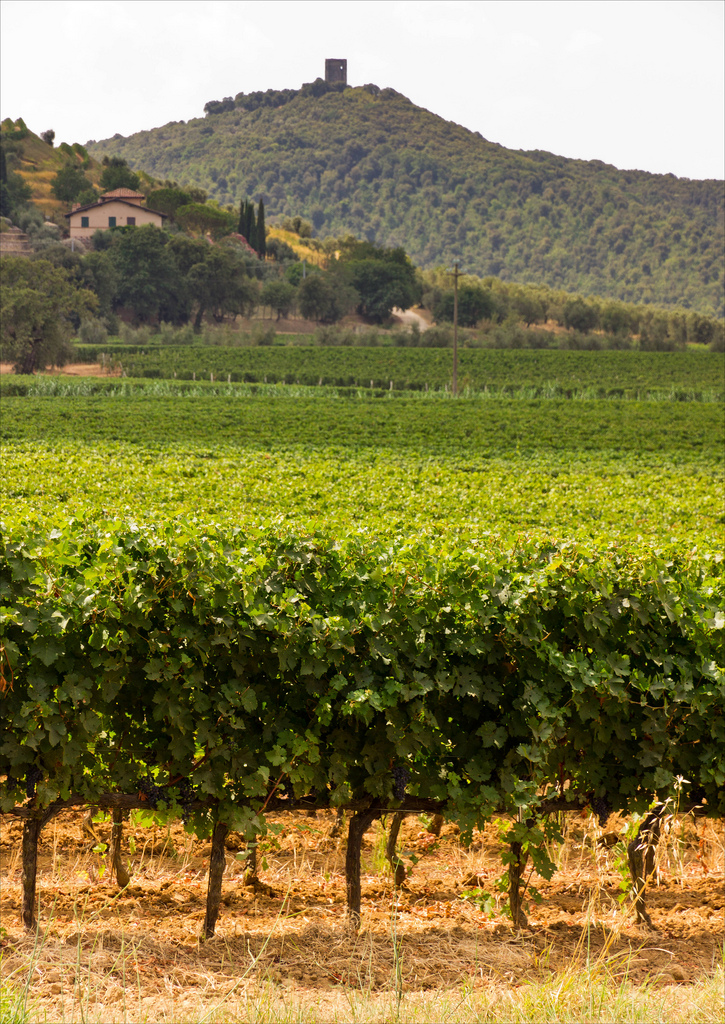
In the Mediterranean territories, such as Bolgheri, the climatic situation is completely different. The vine here is indigenous, this is its natural environment and does not even have many phytosanitary problems. What may be missing, unlike the continental areas, is precisely water. As I have mentioned several times, the vine does not need a lot of it, but it must also not be lacking in the important moments of the plant's cycle, otherwise it can undergo water stress that leads to the production of a few unbalanced grapes. The millennial viticultural experience teaches that the vine must undergo a slight stress to give the best grapes for making wine. Typically, less qualitative situations arise from two extremes: when the vine is too well or when the stress gets too high.

In these climates, the thin hill soils can be too poor and limiting for the vine, especially as regards the water availability. The soils are generally deeper in the foothills or lowland areas, so the roots can develop fully and can find water even in summer, where it has accumulated in the deeper aquifers during the cooler seasons. There is not even too much fertility; on the contrary, there is often the opposite problem: the mineralization of the organic substance in the Mediterranean climate is very speeded up by the high average temperatures. Of course, this is not necessarily the case everywhere: there may be difficult areas in the plains or favorable in the hills. For example, there are areas of the Bolgheri plain where the soils are made thin by superficial tuffaceous crusts. Some soils are poorly drained and flood in the cool seasons. Before deciding where to make a vineyard, a macroscopic examination of the area and then of the micro-situation is essential, with the support of zoning studies and a good geologist.
You will therefore have understood that, in a dry and breezy Mediterranean climate like ours, the continental concept of "low and high" is quite useless for these aspects: down there are no problems of humidity and the solar radiation is abundant everywhere. So, you understand why the right question to ask in many Mediterranean territories is not the altitude of the vineyards but rather the response of the soil to the long dry summer season.
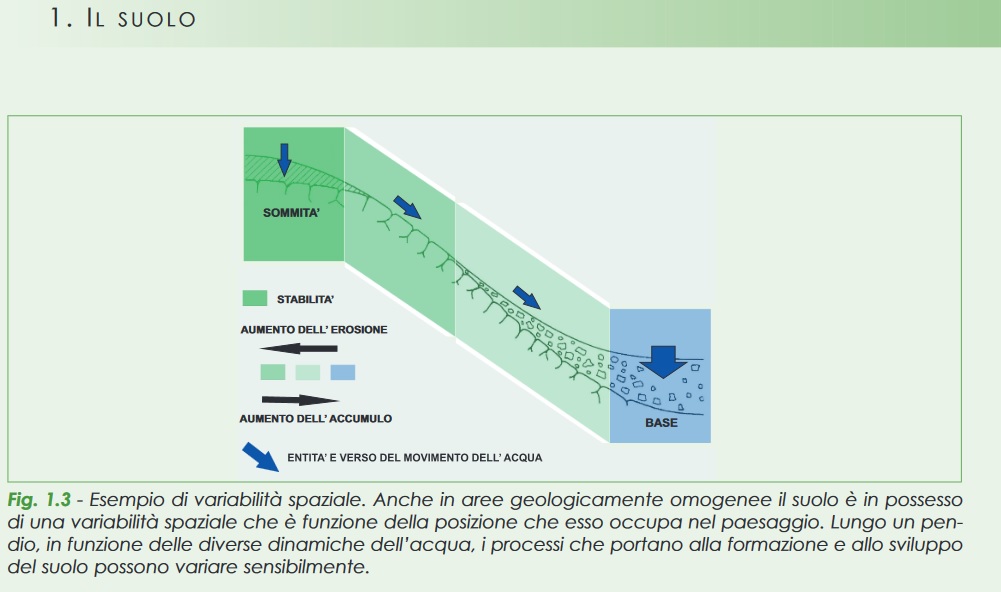
The position of the vineyard in our territory is also important as regards the winds. Certain cold winds (Tramontana from the north and Grecale from the north-east) can be the cause of spring frosts, since the temperature here hardly goes below zero. Therefore, the areas that are too exposed to the winds are more at risk, such as the upper parts of the hills (of the slopes concerned) or the more open areas of the plains. On the other hand, the vineyards of the foothills, protected by the hills, or the areas sheltered by other natural or artificial obstacles (such as woods, rows of trees, etc.) are less exposed.
The main difference between hills and plains in Bolgheri DOC is linked to the differences in temperatures and as regards the summer temperature range between day and night. In general, Bolgheri enjoys a cooler climate on average than the neighboring territories. Inside it, the average annual temperatures are lower in the hilly area and increase going towards the sea. The temperature range is greatest in the small valleys between the hills, lower on the top of the hills and moving towards the sea. It therefore becomes important to understand which types of wines and varieties are best in each condition, without forgetting to correlate these data with the other elements described above, especially with the summer water availability.
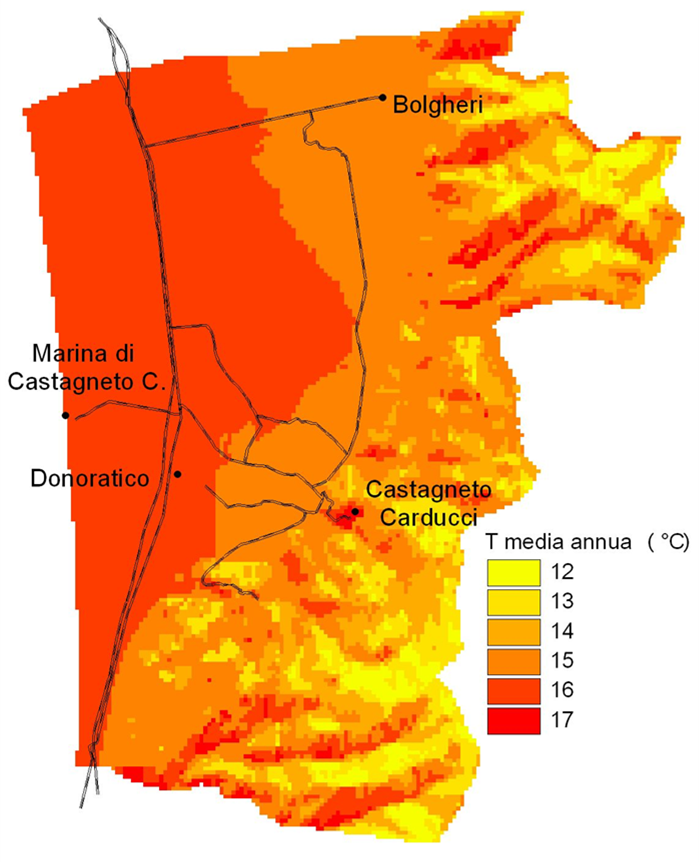
In viticulture, the climate is inevitably related to the soil. It often happens to attribute a greater qualitative value to some soils. In reality this is not always true. There are examples in Italy and around the world of great wines on all types of soils, from predominantly clayey to sandy or silty ones. The texture of the soil (i.e. the size of the soil particles, in the relationships between its various components, from the finest to the coarsest) is important as it affects the expression of the wine characteristics and the work choices of the winemaker. However, it does not necessarily define different qualitative levels, only different sensory characteristics. It is also true that there may be varieties that prefer one or the other type of soil but many others simply give different results. For example, in a very general way, the soils with a higher clay component produce powerfull wines, the sandy soils produce elegant wines. Which are the better? It depends only on personal taste or, at most, on the taste trends of the moment.
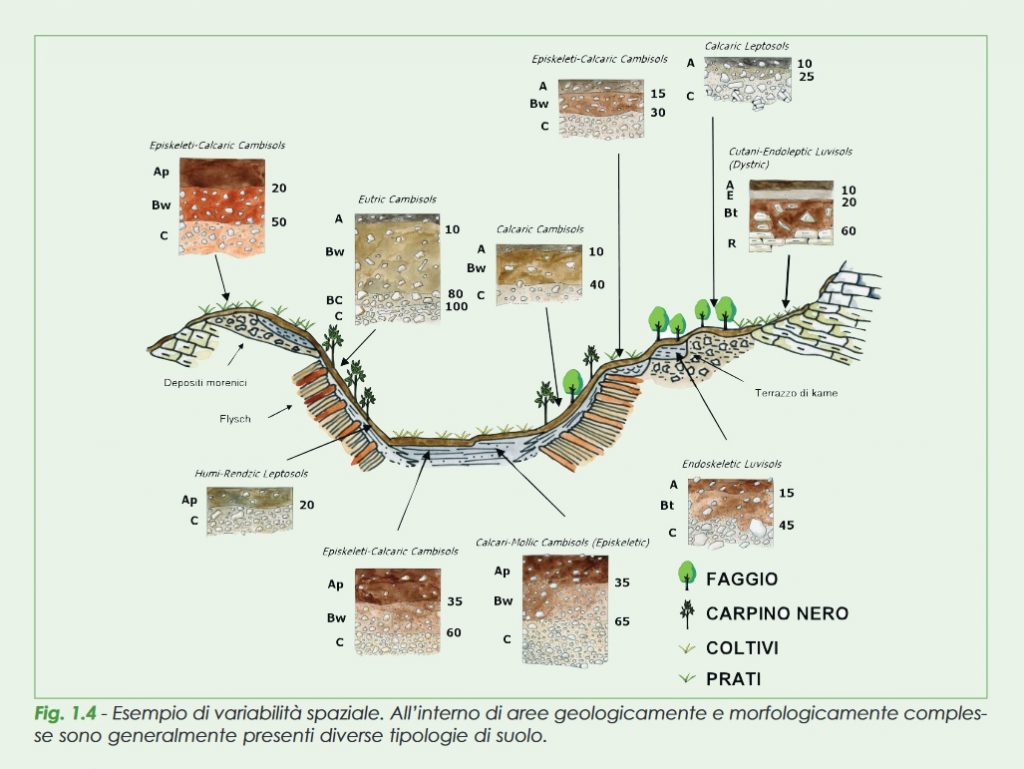
A much more interesting element to understand the balance of the vine (and therefore of the wine), but which is much less talked about, is the depth of the soil, i.e. how much space does the vine really have in order to develop a performing root system (see here and here on the roots). However, it is a very complex topic. The roots will necessarily develop little In a thin soil, which is certainly a limitation in less rainy climates. In areas where there is good water availability, however, it may be of little importance for water, although it can be a limitation for the mineral nutrition. The winemaker must understand that he must intervene more with fertilization. Furthermore, the climate-soil rapport can vary the actual availability of space. For example, a clayey soil in a very arid area can be problematic for the vine, because it becomes hard as a stone for most of the year, effectively reducing the growth capacity of the roots.
In conclusion, I have given several (non-exhaustive) examples of how there is a lot of variability in viticulture compared to certain stereotypes and prejudices, taking the example of Bolgheri Denomination. I therefore hope it is clear that, if a territory is suited to viticulture, the production choices can also be very different. There are no rules that are good everywhere. Instead, there are right or wrong choices for each particular condition. Furthermore, I hope I have clarified that the differences between soils and microclimates are not necessarily indicative of different quality levels, rather of different agricultural needs and different characteristics found in wines or, sometimes, of a better predisposition for certain varieties or types of wines.
Every winery that produces territorial wines knows that the inimitable identity of their products lies in the peculiarities of the vineyards. Only the right choices can enhance them in the wines.
Atis 2018, new release: 95 p.ts by AIS
The AIS Sommelier Toscana magazine came out with an article presenting the new Bolgheri Superiore wines where Atis is among the best tastes, with 95 points.
2018 is the new release for us, because we have made the choice (since the origins of this wine, back in 2003) to let it mature for a longer time than the choices of other companies in the area which, as you can see, are releasing now the 2019. These are winery choices: in our opinion, Atis is a great wine that deserves more evolution and complexity, which it can receive from 2 years of aging in old wood on the lees and 1 year in the bottle. It is not filtered, but cleaned from the dregs only by decanting. We therefore propose it to you perfectly ready to enjoy, with the ability to evolve for decades.
2018 was a cooler than average vintage. Among other things, the second part of September was characterized by a significant drop in the temperatures (from about 30° to 20°C), thanks to the north-east wind. The ripening of the grapes at milder temperatures than usual, in a situation of sun and wind, has determined unique notes in this extraordinary wine.
Another peculiarity of this special vintage concerns the grapes. Do you remember that we replaced 10% of Merlot with Rebo (read here) for the 2017 vintage? With 2018 we have increased even more this resistant variety, very interesting and perfectly adapted to our territory, reaching 15%, to the detriment of Cabernet franc, which has dropped to 5%. The main base, 80%, remains the great king of our vines, Cabernet Sauvignon, present here for over 100 years.
NB Unfortunately, these images are a preview of the magazine of not excellent quality. If you want to read the texts better, connect to this link, p. 38-39 (in Italian).


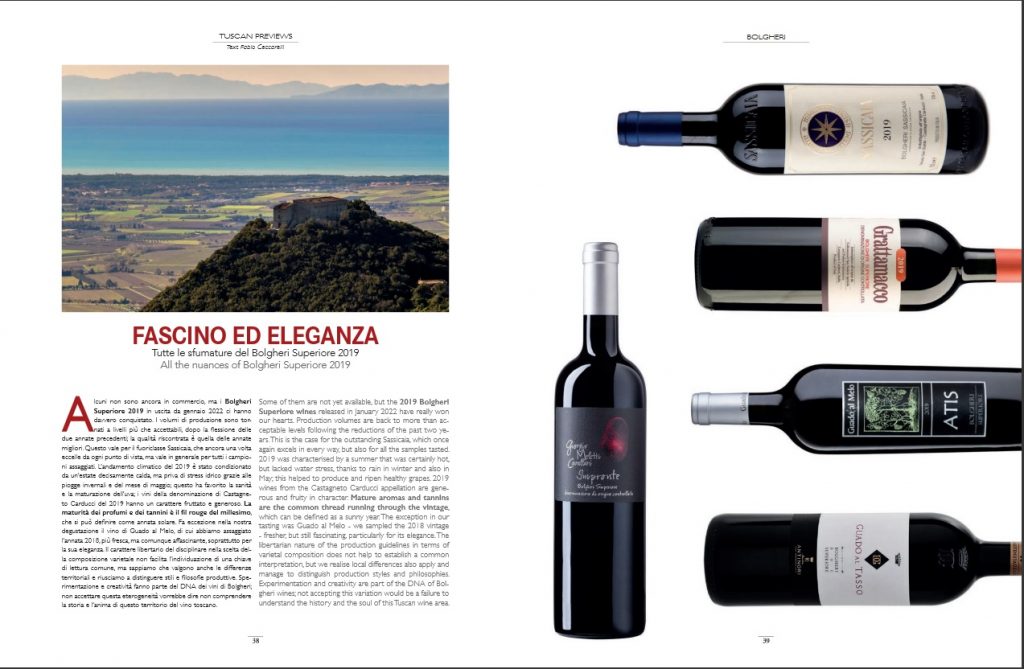
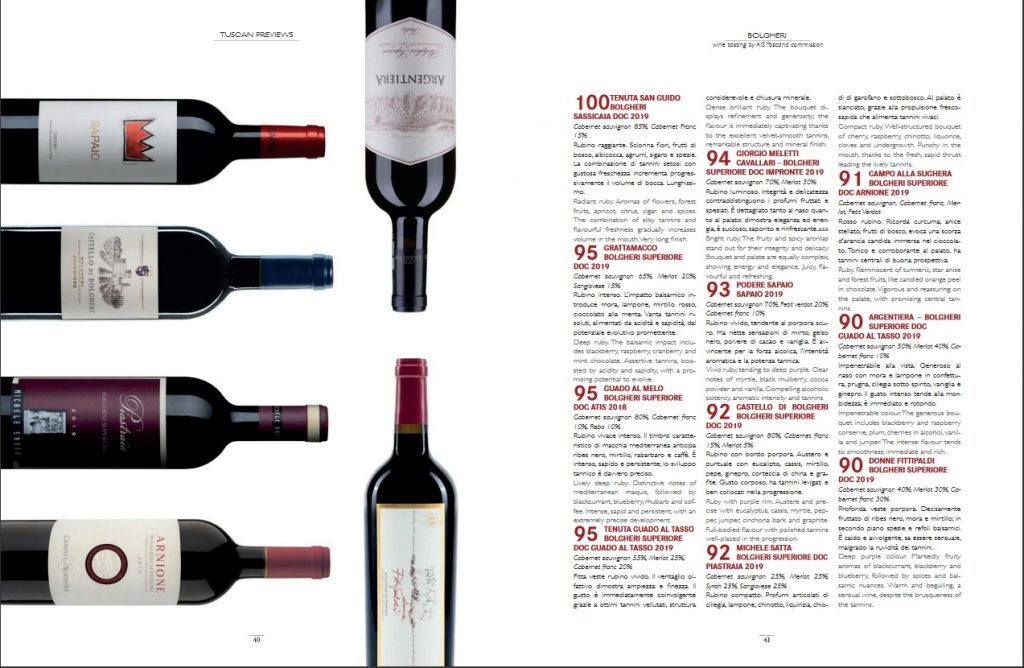
Stem or not stem vinification?
Have you ever heard of winemaking with grape stalks? Conversely, have you ever wondered why the destemming is the prevalent practice in the cellars? However, the “stem or not stem” diatribe is most likely as old as wine (or nearly so).
The grapes are usually destemmed and then pressed before the vinification. In fact, we speak of destemmer-crushing machines (be careful not to invert the sequence!). The stem vinification, on the other hand, consists in the vinification of the whole bunch, without destemming. The buch is lightly or not at all pressed. Another system provides that the grapes are first de-stemmed and crushed, then some stalks are added to the fermentation tanks. What is the best choice? Or rather, what are the advantages and disadvantages of these two practices?
Inevitably, by soaking in the must/wine, the stalks interact with it. They can release substances they contain or, conversely, absorb others. What is the stem composition? Try sucking on a piece and you will easily taste that it is tannic, slightly acidic and has a herbaceous aroma. The stalk contains water and various substances including some organic acids (tartaric and, above all, racemic), many tannins, etc. The acid component decreases with the lignification (it occurs in the last part of their seasonal cycle).
In wine history, both cases of winemaking can be found. Often, the choice was the result of chance, of the local tradition, or a consequence of the pressing techniques used. However, there was already a reflection on which system was better. In fact, if we read the viticultural treatises of all eras, from the Roman author Columella to the present day, the most common opinion was that vinification without stalks was better for obtaining fine and elegant wines, due to the bitter and herbaceous tastes brought from the stems. The stem fermentation was instead considered useful for wines from young vineyards or to improve those that were poor, in any case for wines with lower quality claims. We will see the reason for these statements. Today, we also have the data of numerous scientific researches that have compared winemaking with stems to that without.
So, let's try to understand what are the general advantages and disadvantages of vinification with stems compared to that without. Here is a brief summary of the state of the art. Let's start with the secondary effects, to get to the most important ones. The analytical data that I report are taken from the article by M. Blackford et al., "A Review on Stems Composition and Their Impact on Wine Quality". , Molecules. 2021 Mar; 26 (5): 1240.
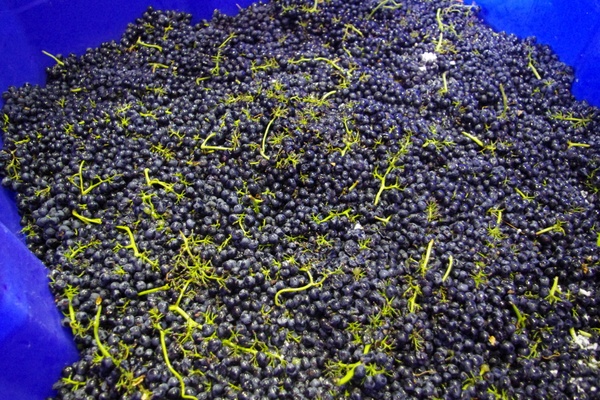
Does it improve the fermentation?
A first positive effect often mentioned in stem vinification is that there is a better fermentation. From the tests carried out, it is in fact possible to verify a slightly more favorable general trend. It is thought that this effect may be due to the additional amount of yeast that the stalks carry on their surface, as well as the ability to trap an amount of air between their roughnesses which favors the vitality of the microorganisms. Furthermore, the mass of the stalks seems to limit a little the temperature changes during fermentation, which favors the survival of the fermenting yeasts.
However, it has been found that the increased presence of oxygen also favors the development of unfavorable microorganisms. The most consequence is that there is generally a higher volatile acidity. Furthermore, in the presence of grapes that are not quite perfect, with some mold, the stem vinification seems to accentuate the severity of the effects on the wine, the so-called oxidase alteration (but it is not clear why).
The diluting and adsorbing effect
The stalks can release water in the must/wine, with a diluting effect on the other components. The water released is actually minimal on the mass of the must. Whether it is for this or for other reasons, in the research carried out there are differences in the composition of the must/wine, some minimal and others more important. Let's see which ones.
In stem vinification compared to that without, a slight increase in pH was measured (it varies from 1% to 9% in the studies) and a decrease in acidity (2% -15%), but not always confirmed in all studies and for all varieties. The variation in acidity could depend on the dilution but not only. It is thought that there is also an action on the phenomena that induce the precipitation of tartaric acid. In fact, the stalks increase the presence of salts (especially potassium, but also calcium and phosphorus), which bind to the tartrate and favor its precipitation. In some studies, there were also slight variations in other acids.
It is often said that stem vinification has the effect of lowering the alcohol content of the wine (today considered positive). There are those who have correlated it to the dilution, but also to a possible adsorption effect of the ethanol molecules by the structure of the stalk. However, this effect has not been seen in the studies: in some cases, the variation is zero, in others slight (it varies from 1% to 8%). I think it makes much more sense to work well in the vineyard to have adequate production balances.
The stalks, on the other hand, seem to have an effect on the decrease in the color of the red wine, more or less evident depending on the variety. Anthocyanins decrease from 1% to 22%, as does the intensity of color (from 7% to 33%). In particular, the yellowish reflections are accentuated in aging. The hypotheses about the cause are different, perhaps all together: dilution, color adsorption and pH variations.

The most important effects: aromas and tannins
The stalks release aromas that are not exactly the most pleasant ones. Chemical analyzes confirm the increase above all of pyrazine compounds, which give "green" (grass or pepper) aromas. Aroma studies are not easy. As I wrote previously, even if we analyze the presence and concentration of the aromatic molecules in a complex solution such as wine, it is not easy to predict their olfactory perception. Studies of sensory analysis showed that the wines made with stalks are less fruity (fresh fruit), while the sensations of cooked fruit (jam), grass and spices increase. Somebody speaks of greater complexity, but the doubt remains about pleasantness, which is still a very personal element.
The effect on the taste of the wine, on the other hand, seems to be more defined. The researches have shown that stem vinification increases the sensation of astringency and bitterness in the wines. In fact, we finally arrive at the most important event in the winemaking with stems: the release of a great number of total polyphenols, in particular of tannins. The release of tannins is not always the same but still important, from 20% to 80%, depending on the grape variety, temperature and duration of the maceration. The incidence of tannins from the stalk is inverse to the duration of maceration: the longer it is, the more the tannins of the skins become predominant. If the maceration is short, however, the tannins of the stalk become (logically) the most important in the wine. We have therefore come to understand the main reason why it was considered useful in the past, in some cases, the vinification with stalks: the release of tannins in red wines.
The grape tannins are found mainly in the grape skin and are released into the must/wine during the skin maceration. Sometimes, however, the tannin is lacking, because poor quality grapes are used (for different reasons: because they are grown in unsuitable places, badly cultivated, for unfavorable vintages, harvests done at the wrong time, etc.), or because that variety is naturally poor of them. Historically, since the Roman times, systems have always been sought to add tannins to wines that do not have enough of them. However, since the ancient times, it was also understood that vegetable tannins are very different. Using one type rather than the other leads to a significant final difference in the taste of the wine. In the stalk, there are mainly tannins of a certain chemical type (catechinic) similar to those of the grape seeds and all the other green parts of the plant. Compared to the "noble" ones present in the grape skin, they are rougher in the mouth, much more herbaceous and bitter. Furthermore, they have a much stronger oxidative tendency.

In the past (since the Roman times), the tannin considered the best to add to wine was that from the oak galls. If you walk near these trees, you can easily see strange growths on different parts of the plant (branches, stem, etc.). The gall is formed following the attack of a parasite that causes an uncontrolled proliferation of cell tissues. The plant reacts by accumulating defense substances, the tannins, in that point. The use of gall tannins is very ancient and continues today, although purified products are now used which can also have very high costs. Instead, the stalks were considered another system to add tannins, but with low quality results. Sometimes the leaves were also added in vinification, with decidedly less elegant effects in the wine. These systems were however tolerated and recommended in the past for the great mass of low quality cheap wine.
But, do we really need to add tannin to wine today? That is the fundamental question! In an artisan production as our, thanks to today's knowledge, in a suitable area to the winegrowing, it is not necessary to correct the wines. It needs only when the grapes are the result of a bad work in the vineyard and in the cellar. In our opinion, the addition of tannin, whatever its origin, is something foreign to the production of a terroir-expressive wine. I don't think there is conceptually much difference if it is done with stalks or with a purified oak tannin.

In the winery: from the hand destemming to the destemming machines
With the evolution of the winemaker practices of the nineteenth century, not only the stalks were rejected in fermentation, but even in the grape-pressing phase. The destemming became a qualitative practice described in all the viticulture texts, but carried out in the (few) wineries that produced refined wines. Later, it became more and more common.
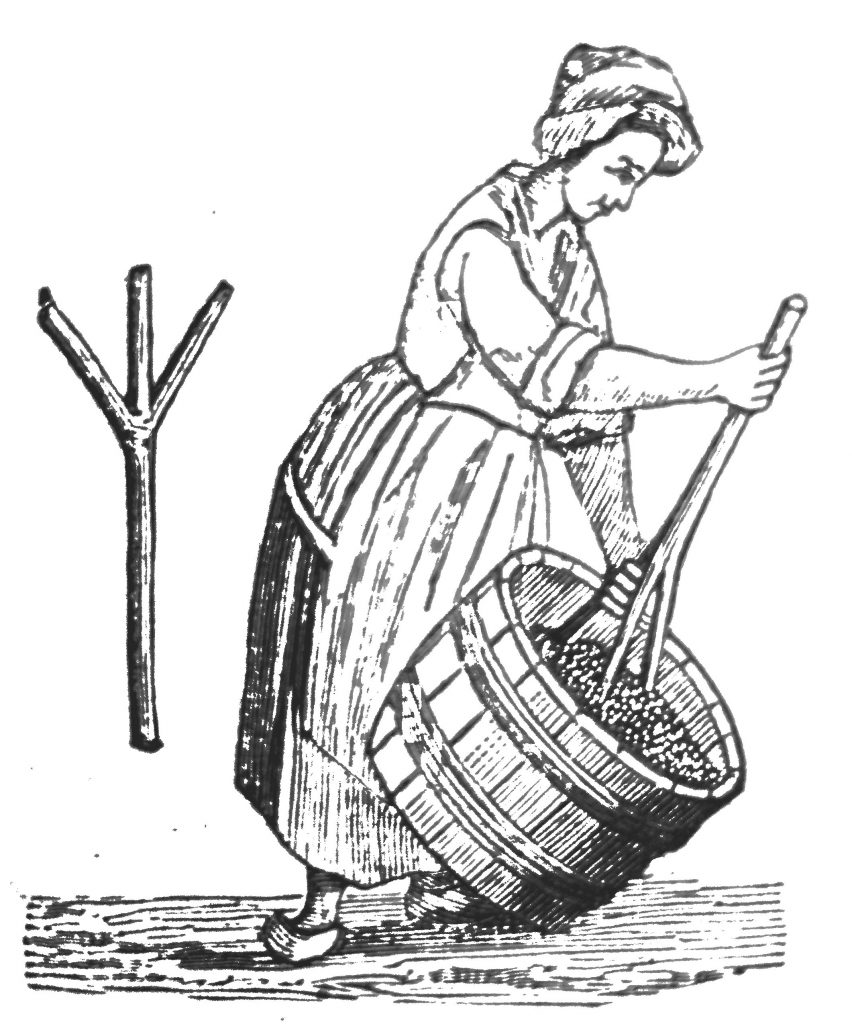
A very crude ancient system for destemming, ancestor (at least in the concept) of the modern machines, was to rotate a branched stick in a basket of grapes. In the most advanced companies, a more laborious but delicate system was preferred, that is to remove the berries from the stem by hand. For obvious reasons, these expensive practices were reserved for the few high-value wines.
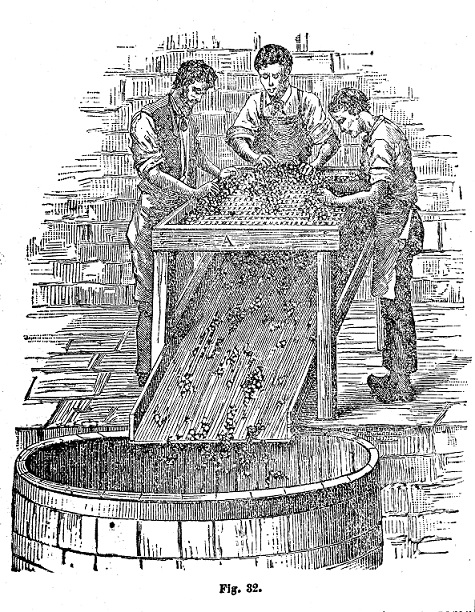
The first mechanical machines, first only crushers, then also destemmer-crushers, were for a long time viewed with suspicion due to the too destructive action on the grapes. The ones we use today are the result of a remarkable evolution which, over time, has leaded more and more towards the ability to act in a delicate way, carefully detaching the berries from the stalk without tearing or shredding the pedicels and the other green parts. Today's machines also have the ability to press the berries very little.
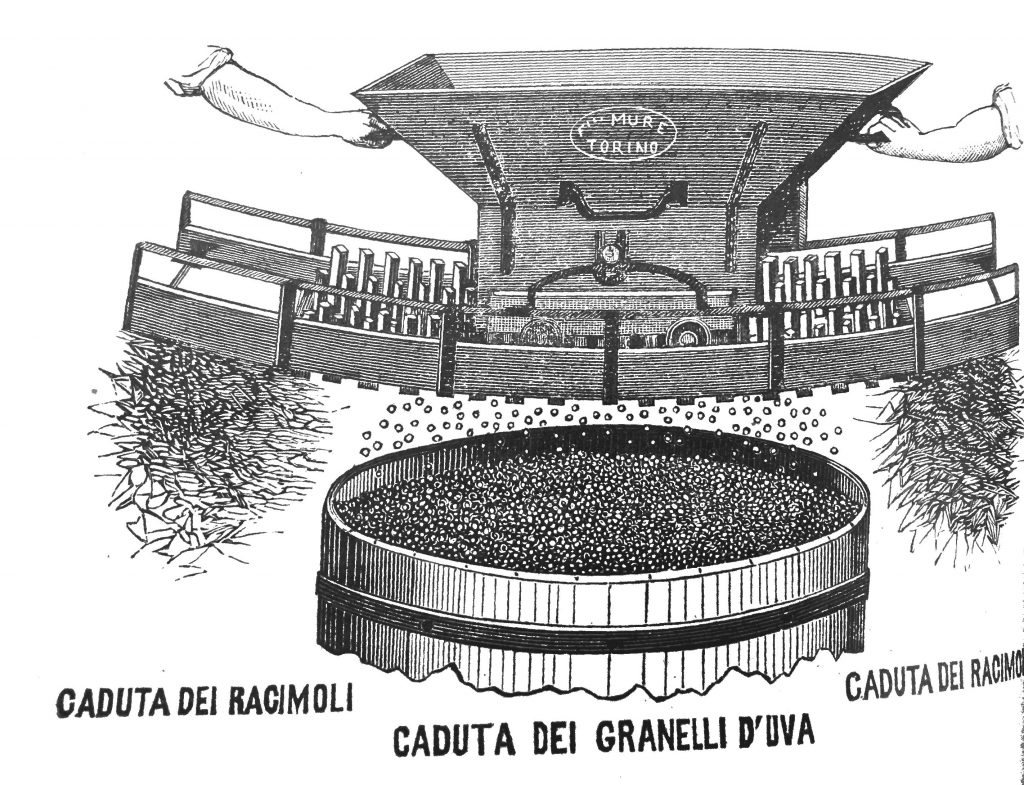
In the production of white wines, where the taste is much more delicate and the wine alters much more easily, it is yet more important not to bring bitter and astringent tastes unnecessarily in the must/wine, as well as easily oxidizable tannins. Many artisan winemakers, like us, do not press the whole bunches, but first they practice the destemming. After that, to be absolutely sure to eliminate all the small pieces of leaves or stalks or other, the cleaning of the must is carried out by spontaneous sedimentation. The must is stored overnight in the cool of the cellar and the sediments go down naturally to the bottom of the tank. Then, we remove the must from the above of the tank, without moving the sediment, and it was transferred to a new container for the fermentation.
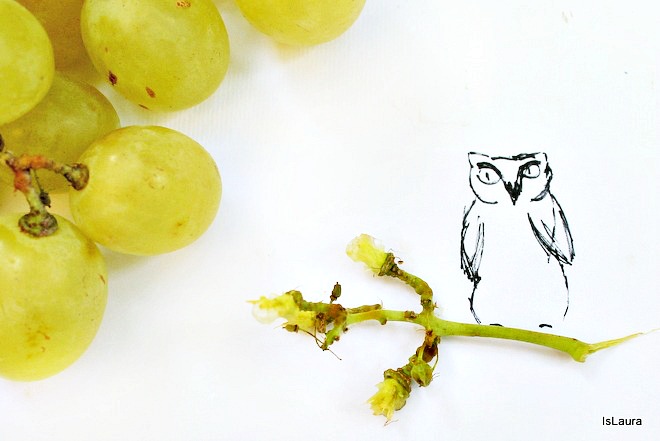
Ultimately, I think you have understood that Michele and I do not vinify with stems and the reason. For us, a natural wine is made with grapes only, with its unique balances that are born in suitable vineyards, thanks to a very good work for each individual plant. We don't want to add nothing. The stalks bring something foreign to the fruit, not even so pleasant, which we prefer not to have. Our great territory already gives so much to our wines naturally, both in terms of taste and aromas. This does not mean that other winemakers could think that the contribution of stalks is useful, giving more importance to the advantages rather than the disadvantages.
The stalks are however important in our farm cycle, they are not just waste: after destemming, we put them in our composting area, where they contribute to form a perfect vegetable compost for fertilizing our vineyards.
Bibligraphy:
Riberaux-Gayon et al. “Trattato di scienza e tecnica enologica”, ed. AEB Brescia, 1980.
M. Blackford et al., “A Review on Stems Composition and Their Impact on Wine Quality”, Molecules. 2021 Mar; 26(5): 1240.
The vintage illustrations are from old books of our library on wine.
L'Airone 2021 is ready
We welcome the new vintage of the L'Airone which opens, as every year, our new releases. L'Airone is our white that expresses all the freshness of Vermentino, a perfect variety for our marine climate, which tolerates perfectly the wind and the heat of a mild Mediterranean climate like ours. This variety has been present on the Tuscan coast and, in general, the Tyrrhenian ones, for centuries, even if its origin is uncertain.
I have already talked at length about the last harvest: we judged it to be an excellent vintage. The summer was dry but our vines showed no symptoms of water suffering, because instead it had rained abundantly in winter. The temperatures were warm but without excess and the climate was been very well ventilated. The grapes were fabulous, perfect and healthy.
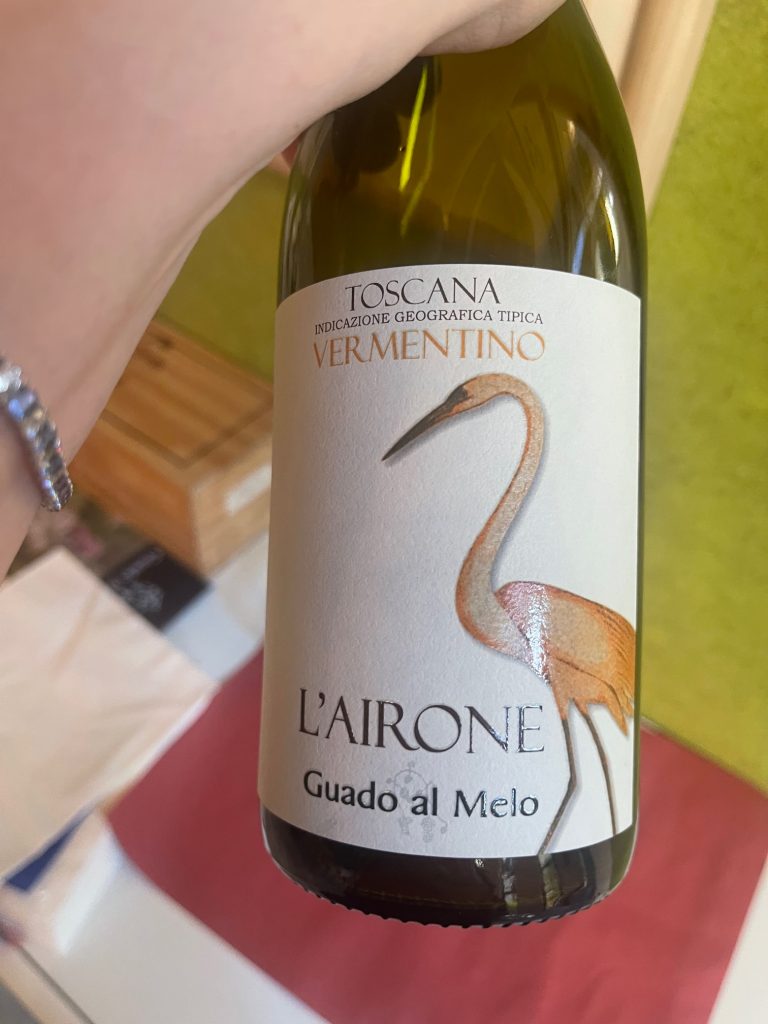
As usual, it has excellent aromas. In this juvenile phase, they are reminiscent above all of the typical citrus fruits of Vermentino, in particular the grapefruit, with delicate aromas of sage. It has also slight hints of exotic fruit, such as pineapple and passion fruit. In the mouth, it is very fresh and pleasantly light, with a fair length. However, an artisanal wine is alive and it will evolve over the months in the bottle . You'll can feel some aromas increase, such as those of exotic fruit, add others such as white flowers, light hints of honey and bread crust, …
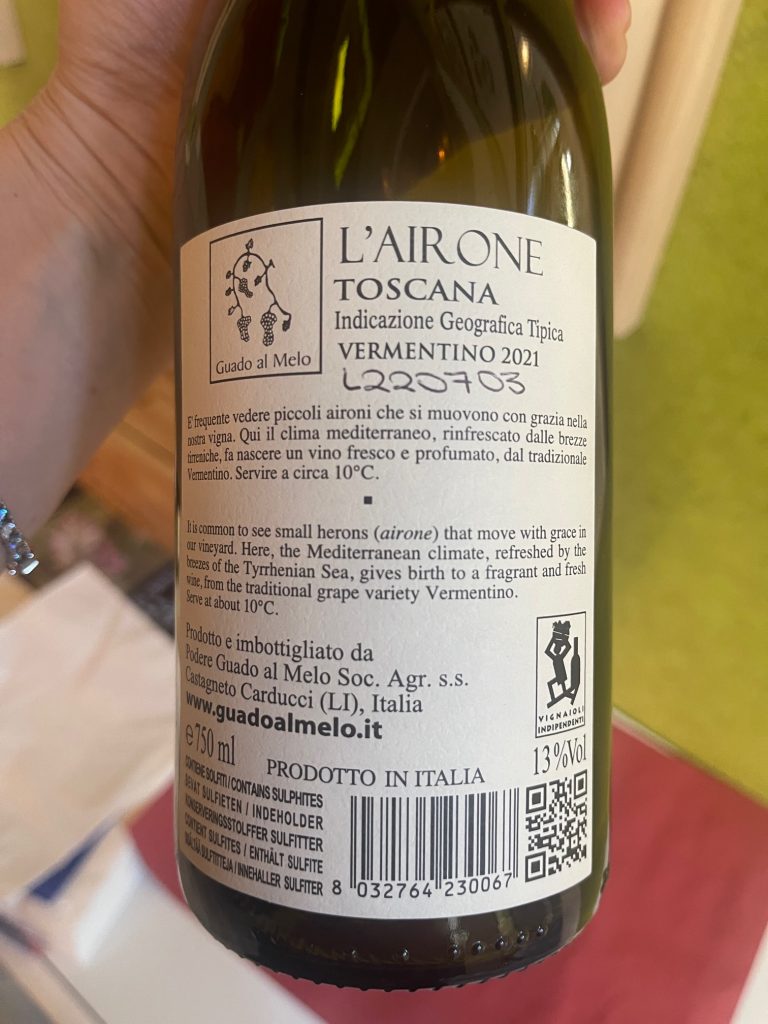
It is an excellent wine to drink cool, I would say around 10°-12°C. As soon as it is taken out of the fridge (4°C), it will have few aromas. Remember: wait a while before drinking it, so it to warm up slightly and you'll enjoy all its aromatic complexity. Moreover, wait still a few minutes after uncorking, to oxygenate it well.
It is perfect as an aperitif but also to accompany dishes that are not too intense. For example, I can suggest you to drink it with classic spaghetti with clams, fried fish orfried vegetables, an omelette with aromatic herbs, a spring vegetable pie, …
If you don't drink it immediately, I recommend a good conservation! It is not really the best to keep a wine in the light (worse than ever under a spotlight!), at room temperature or in the heat. It's no a good idea to forget it in a refrigerator for months. All these situations mess it up, alter its aromas and taste, can cause precipitation of small crystals (nothing that hurts, it's just the natural potassium tartrate of the grapes). This happens because it is an artisanal wine: we do not do chemical stabilization or intense filtration, there is also the minimum possible sulfur dioxide. Store it with respect: the best is the bottle is lying down (standing up is possible only if you drink it shortly), in a cool place (about 10 °-12°C), in the dark.
Here there is the technical sheet of the wine, here the PDF.

Between the Middle Ages and the Renaissance: the dawn of a new Italian viticultural geography
During the fourteenth century, another oriental luxury wine was established. Its name was Malvasia, marketed by the Venetians. It seems that the name derives from the place where it was stored, Monembasia, a port in the Peloponnese, while the production seems to have taken place mainly in Crete Island. Malvasia was even stronger, fortified and sweet wine than the previous ones (it is thought between 16 and 18 % alcohol). It became the noblest wine of the time in all of Europe. It was imitated everywhere in Italy. Hence born the legacy of the many current Italian varieties named Malvasia (black Malvasia, black from Basilicata, long black, white, long white, white from Candia, white from Basilicata, from Casorzo, Lipari, Sardinia, Schierano, Istriana , etc.). All they are not genetically related to each other. They owe their name, most likely, to the fact that they were used locally in the past to produce the same type of wine.
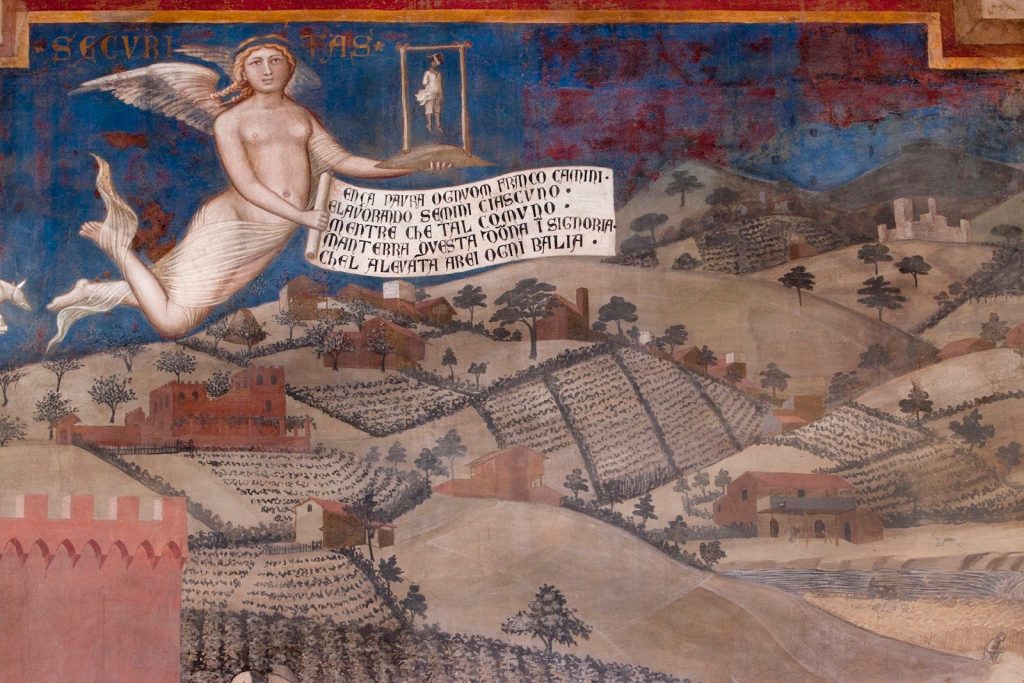
As written in the previous post, almost all Italian wines up to the thirteenth century were anonymous and distinguished only by color (white= album, red = vermilium, ...), by flavor (dulce = sweet, bruscum =acid, ...), from the area of production (vinum de plano = wine from level ground, vinum de monte = wine from the hills, ecc.). With the fourteenth century, more and more local quality wines emerged, even if they did not imitate the oriental wines. They were yet for a local consumption, at most regional. They weren't luxurious, but they were starting to have higher prices, within the reach of medium class people. They were also the most recommended in medical treatises, which often disdained those of luxury because they were too heavy and aromatic. These wines slowly began to have a name, which could be linked to the production area or other characteristics. Among these we remember the different Moscatello, produced in various areas of Italy, Piedmontese Nebbiolo and Arneis, Ligurian Razzese, Lombard Groppello, Lombard-Venetian Schiava, Garganigo and Marzemino from Veneto, Friulian Refosco, Chianti Tuscan, Lacrima and Fiano from Campania, the southern Gaglioppo, etc. Some were a sort of local cloning of luxury wines, such as Vernaccia of Cellatica (near Brescia), Vernaccia of San Gimignano, Ribolla from Imola, Greco from Corsica, Greco from Velletri, Malvasia and Vernaccia from Sardinia.
The dawn of the modern grape varieties. There is little point in looking for current wines and varieties in the Middle Ages, even if sometimes the same names are found. There are too many centuries and many probable transformations between. The Middle Ages, like the ancient times, were a period in which wines but also a lot of varieties traveled, for the Mediterranean and for Europe, with also the possibility of crossings with local grapevines. These exchanges are recounted, for example, in "Trecentonovelle" ("Three hundred stories") (1390) by Franco Sacchetti. He wrote that in Italy there was so much desire to produce great wines that the winemakers tried to grab the best grape varieties from all over, recovering the rooted cuttings directly or exploiting the network of contacts offered by the Church. For example, Sacchetti reports that the Florentine nobleman Vieri de' Bardi sent off from Portovenere to his estate in Antella (Bagno a Ripoli, near Florence) some cuttings of a variety with which the famous Vernaccia of Coniglia wine was produced.
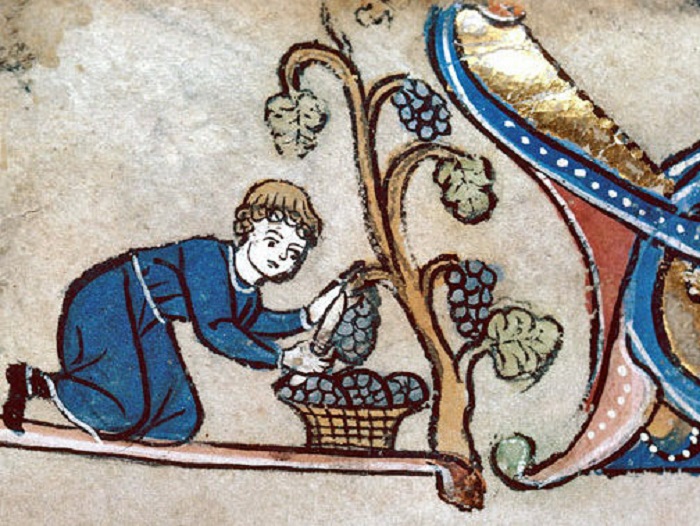
From the mid-1300s to the early 1400s, there were some important transformations which once again significantly changed the Italian wine geography.
On the one hand, the climate began to worsen more and more, after the medieval warm period that had favored the boom in viticulture. That cold period called the "Little Ice Age" began, which will shock all of Europe with a general agricultural crisis. The famines contributed to the spread of epidemics such as the Black Plague which, from 1348, led to the decimation of the populations. The crisis caused the decrease of agriculture in general, including the winegrowing. Furthermore, the cold made the grape vine disappear from all those territories where the climate had now become an insurmountable limit.
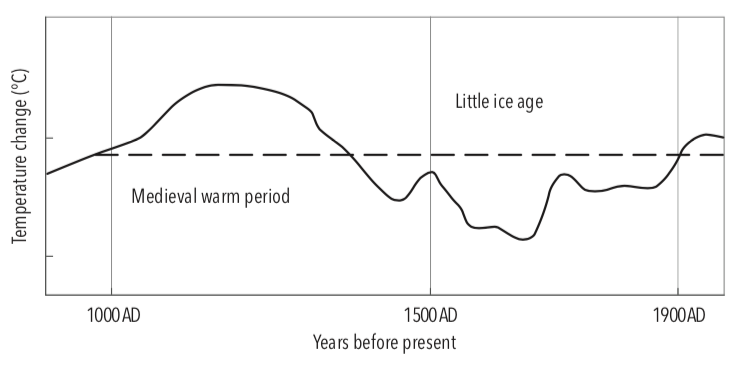

The wine between drunkenness, mockery and pleasure. The Black Plague is the background to Boccaccio's Decameron, about which I have told so far as the greatest medieval work that talks so much about wine. The Decameron is made up of a series of short stories that a group of young Florentine nobles, seven girls and three boys, tell in turn to pass the time in the country villa where they took refuge to escape the infection. In the introduction, Boccaccio describes the beauties of this residence, including the cellars, rich in fine wines, according to him more suitable for "good drinkers than for wise and honest women". In the Middle Ages, reputable women never must drink too much. However, at the times, the excess of wine was deplorable for everyone, both for the morals and for the health. But Boccaccio's stories are not very moralistic, often semi-serious. Drunkenness is linked to deception or teasing, while intelligent women often manage to cunningly overcome life's adversities.
The story of Alatiel. The beautiful Alatiel, daughter of the sultan of Babylon, is sent by her father in marriage to the king of Morocco. A long journey to the Mediterranean begins for her, during which she is kidnapped and violated by several men. The first, Pericone, thinks of making her give in with the wine. "Since he realized that she liked wine, which she was not used to because her religion prevented her from drinking it, he thought of making her surrender with the help of wine and Venus. One evening, he invited her to a party and ordered the cupbearer to serve her a glass of various wines mixed together. Having drunk the mixture, the woman, forgetting past misfortunes, became happy and seeing some women dancing Spanish dances, she too danced in the Alexandrian manner. So, she spent most of the night between wines and dances. When the guests left, the man, who was very robust and energetic, went into the room with the woman. She, warmer with wine than honesty, undressed and went to bed. " At the end of the story, Alatiel manages to return home. At that time, all these misadventures would compromise the life of a girl. However, she manages to convince her father that she has been welcomed all that time in a convent and so she marries her fiancé.
The semi-serious history of Tofano and Ghita. The rich Tofano is very jealous of his wife, the beautiful Ghita. His torment prompts her to correspond to a young suitor. The woman starts frequently gets her husband drunk to meet her lover. One night, as she returns from a date, her husband locks her out of the house, to unmask her in front of the neighbors. The woman threatens craftily to commit suicide, telling him that they would later blame him. Then, thanks to the darkness that hide her actions, she throws a stone into the well. The worried man runs to watch. Ghita quickly enters the house and locks her husband out. Tofano starts screaming and swearing, waking up the neighborhood, while Ghita yells at everyone that her husband always gets drunk and spends the night in the taverns. Tofano's misconduct spreads and reaches also the ears of Ghita's relatives, who beat the man and take the woman away. Eventually, Tofano, realizing that everything had started from his mad jealousy, repents and convinces his wife to come back, leaving her free to do as she pleases, as long as discreetly.
Between the end of the 14th century and the beginning of the 15th century, there was also an epochal change in trade, called the "freight revolution". Until then, the wine trade was limited to the most expensive products, as well as durable, because the shipping costs were calculated essentially on the basis of the volume occupied by the goods on the ship. The wine barrels take up a lot of space. Proportionately, it was cheaper to transport gemstones. The freight revolution instead introduced the use of calculating the cost also taking into account the value of the goods. The wine trade benefited greatly and, consequently, it had a very important increase.
As mentioned, until then the vine was grown practically everywhere in Italy, to have wine available for the community and, except for luxury products, the consumption of common wines was essentially local. As transportation became cheaper, more wines began to travel. The trade was also facilitated by the birth of larger political entities, which lowered the number of duties in travel and therefore the final price to the consumer. Furthermore, in the richer areas of Northern and Central Italy, there was also an improvement of the roads. So, people started to have a wide choice at their disposal. More and more, the consumption was focused on the best wines, not necessarily the local ones.
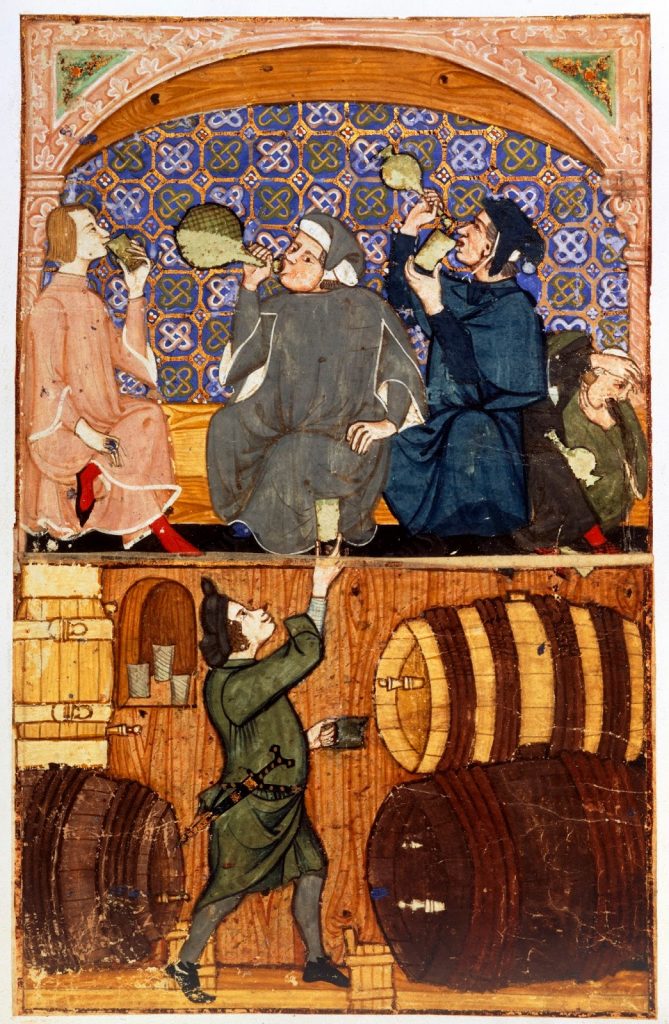
All these events contributed to once again change the Italian geography of wine. Viticulture decreased in general and, in particular, decreased or disappeared from all those areas where it is little or no suitable. On the contrary, it grew more and more in those districts considered of higher quality, where the economic performance became more and more relevant, such as Tuscany, the "Oltrepò Pavese", the Venetian hills, Istria, the Castelli Romani area, Apulia, Calabria, Langhe, etc. The high alcohol content of oriental wines (or made in that style), obtained by drying or concentration style, was not more necessary. It was enough if a good alcohol content, derived from an area suited to viticulture, for the wines to be preserved well enough, saving their pleasantness and aromas.
As marketing increased, the need for wines to be recognizable, with precise identities, increased more and more. Till then, they spoke only of red or white wine or a little more. From now, the names of the wines began to become a common practice. They often derived from the type of product, often combined with the place of production or, in other cases, that of storage or distribution, rarely of the grape varieties. Particularly suited areas began to be mentioned more and more, sometimes even the single high-quality vineyards. For example, 106 different wine producing locations near the city are identified in the Florentine land registry of 1427.
But don't think that there was a great clarity, like today. The situation was still very confused, both for the time and for modern scholars who tried to decipher it, because with the same name and origin there are also wines with very different characteristics (white and red, sweet and non-sweet wines, etc.). We are still a long way from a very precise and defined geography of wine. We can say that it was starting to take shape.
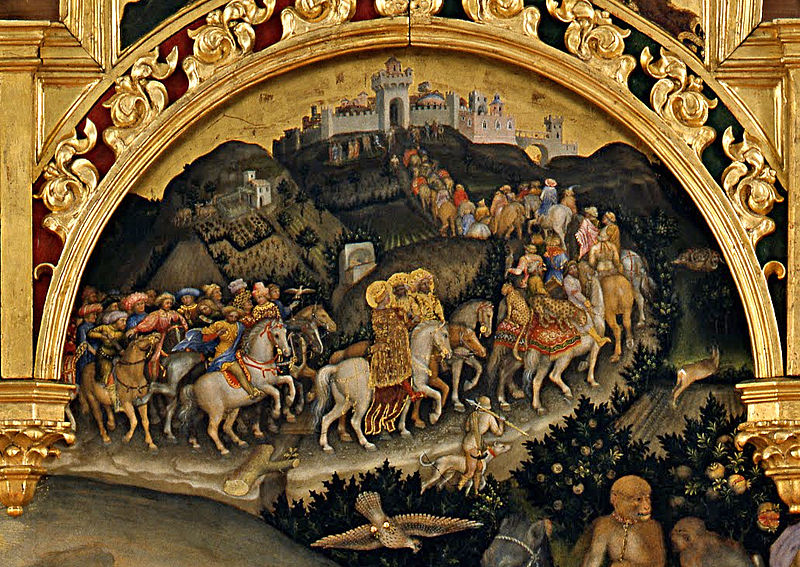
In the fifteenth century the consumption of wine was by now very advanced. The wines began to be distinguished and known for their organoleptic and cultural peculiarities, as well as for their combinations with food. The first cookery treaties were also born in that period.
In the mid-fifteenth century, the Byzantine Empire collapsed, Genoese trade with the eastern Mediterranean disappeared, while the Venetian one was considerably reduced. The prestige of oriental or oriental-style wines (very sweet, flavored and alcoholic) collapsed. However, their taste was not completely lost, especially in the banquets and the ceremonies. However, a new type of luxury wine was imposed, the one coming from a suitable territory, dry, not excessively alcoholic, white or red, pleasantly scented. They were young wines, as the aging processes will only be "discovered" again a few centuries later. However, we will talk more about the Renaissance another time.
... To be continued
Bibliography:
Prof. Alfonso Marini (AA 2020-2021) Dispense del corso di storia medievale.
Pini, Antonio Ivan (2003) Il vino del ricco e il vino del povero. In: La civiltà del vino. Fonti, temi e produzioni vitivinicole dal Medioevo al Novecento. Atti del convegno (Monticelli Brusati, Antica Fratta, 5-6 ottobre 2001). Centro culturale artistico di Franciacorta e del Sebino, Brescia, pp. 585-598.
Antonio Saltini (1998), Per la storia delle pratiche di cantina (parte 1) enologia antica, enologia moderna: un solo vino, o bevande incomparabili? In Rivista di Storia dell’Agricoltura n.1, giugno 1998.
Branca Paolo (2003) Il vino nella cultura arabo-musulmana. Un genere letterario… e qualcosa di più. In: La civiltà del vino. Fonti, temi e produzioni vitivinicole dal Medioevo al Novecento. Atti del convegno (Monticelli Brusati, Antica Fratta, 5-6 ottobre 2001). Centro culturale artistico di Franciacorta e del Sebino, Brescia, pp. 165-191.
Anna Maria Grasso, Girolamo Fiorentino (2012) Archeologia e storia della vite e del vino nel medioevo italiano. Il contributo dell’archeobotanica e di nuove metodologie di analisi integrate per la caratterizzazione varietale applicate ai contesti archeologici della Puglia meridionale. 2012, VI Congresso Nazionale di Archeologia Medievale
AAVV (1988) Il vino nell’economia e nella Società italiana medioevale e moderna. Convegno di Studi Greve in Chianti, 21-24 maggio 1987 Firenze, in Quaderni della Rivista di Storia dell’Agricoltura, Accademia dei Georgofili Firenze.
Emilio Sereni (1961), Storia del paesaggio agrario italiano, Editori Laterza.
Pietro Stara (2013), Il discorso del vino - origine, identità, come problemi storico-sociali, ed. Zero in Condotta.
Giovanni Spani (2010-2011), Il vino di Boccaccio: Usi e abusi in alcune novelle del Decameron, Heliotropia 8-9.
Gino Tellini (2014), Il "figlio del sole" : vino e letteratura in Toscana. Soc. Ed. Fiorentina
Between the Early and Late Middle Ages: overseas, Latin and Greek wines
“Vinum de vite dat nobis gaudia vite. /Si duo sunt vina, mihi de miliore propina. / Non prosunt vina, nisi fiat repetitio trina. / Dum quartum poto, succedunt gaudia voto. / Ad potum quintum mens vadit in laberintum. / Sexta potatio me cogi abite suppinum.” (Salimbene de Adam, XIII sec.)
“The wine of the vine gives us the joys of life. If there are two qualities of wine, give me the best. We do not enjoy wines if we do not repeat the drink three times. At the fourth, desire is followed by delights. On the fifth drink, the mind enters a labyrinth. The sixth drink makes me fall on my back. " From the chronicles of Salimbene de Adam (13th century)
Between the end of the Early and the start of the Late Middle Ages, the greater political stability and the favorable climate led to notable progress in agriculture. The vineyards, in particular, expanded and spread more and more. The notable increase in production made wine go back to being the drink of the people in Italy, as it had already been in Roman times. It was different in other European countries. Where production was more difficult or wine was an imported drink, it remained for a long time only the prerogative of the rich.
The wine went from sign of prestige or a liturgical necessity to an economic activity. After the year 1000, the bourgeois agricultural property also spread, in particular from the 12th century. The wine production was the symbol of social ascent for the bourgeois. The increase in production will increasingly lead to its commercialization, marking the success over time of those territories that were located in places that facilitated its transport, such as the coastal areas and along the navigable rivers of Europe. Let's go to discover how.
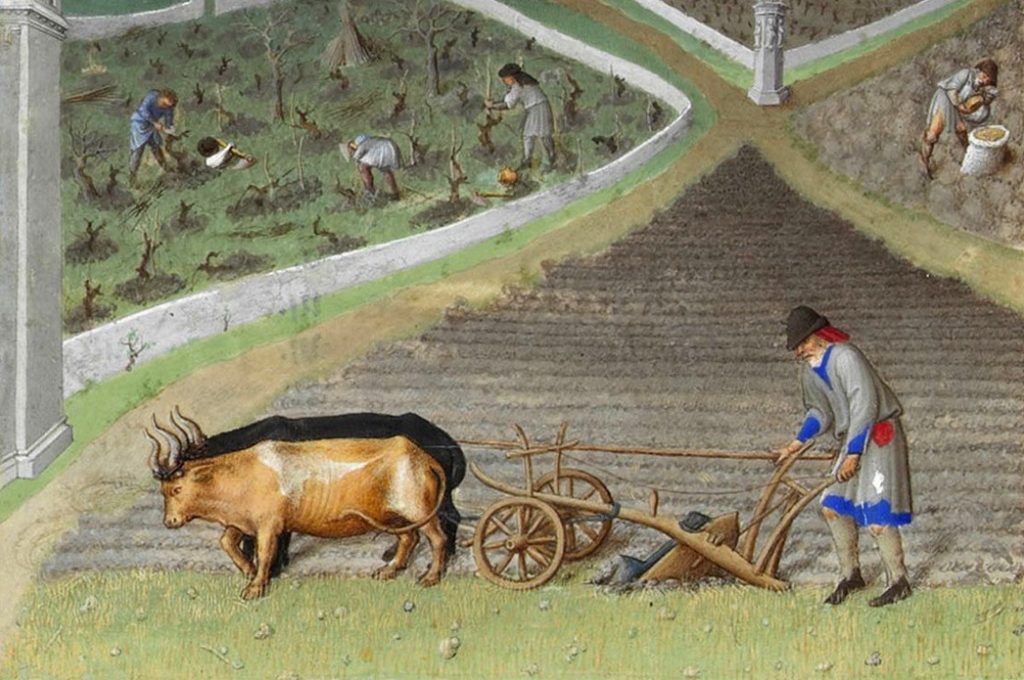
The viticulture spread very much In Italy. Each territory, even the least suitable, dedicated an important part of its agricultural land to the vine. The remarkable documentation we have of the period, especially between the 13th and 14th centuries, shows us an incredible spread of vines everywhere, both in the peripheral areas and in the centers of cities and villages. At the time, the local wines were anonymous, defined only by the color, the organoleptic characteristics, and the alcohol content. They were consumed essentially locally.
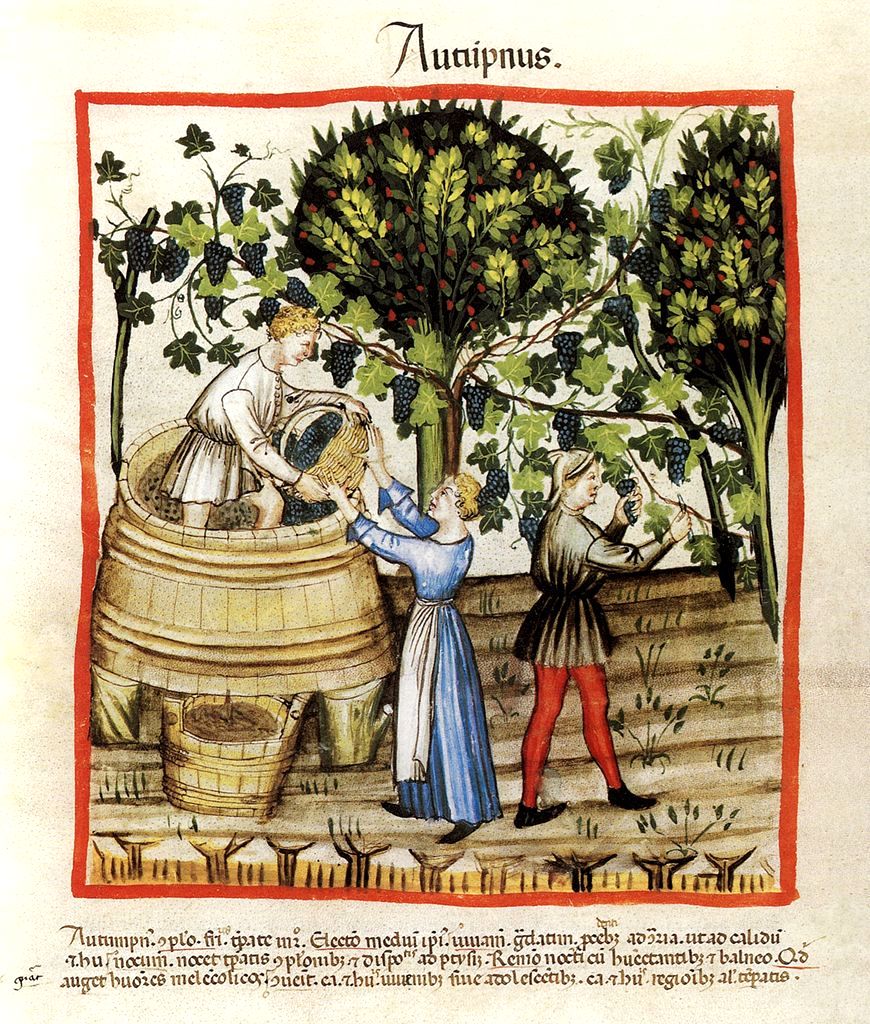
The increase in wine production became a concern of the legislator. In the municipal statutes there were many provisions related to the cultivation and management of the vineyards, at the date of the harvest, the transport, the retail and wholesale of grapes and wine, at the duties and the tariffs. In general, the regulations tended to push towards a production of quantities, capable of providing enough wine for the consumption of the community. Furthermore, the statutes were aimed at favoring the consumption of local wines and making it difficult for foreigners to enter (vina forensia).

In the thirteenth century, however, the poet Cecco Angiolieri wrote that he was tired of the local (Latin) wine and wanted to drink something different::
"... and all I want is Greek and Vernaccia wines, / because Latin wine bores me, ...".
In fact, the great availability of local wine pushed more and more the rich and powerful Italians to seek distinction in luxury products, represented at the time by the exotic wines of the eastern Mediterranean, which arrived together with spices, silk, jewels and the relics of the saints. Their prestige lay in the high price.
The wines traveled a lot from the thirteenth century onwards, throughout the Mediterranean, to and from Italy, passing through the three great trading posts of the time: Genoa, Pisa and Venice. The wine traveled in small barrels, by sea or river, on ships or barges. Upon departure (or arrival), the barrels were transferred to ox-drawn carts or to the burden of the mules. The above maritime republics dominated these trades for a long time, throughout the Mediterranean and towards the northern Europe.

The oriental wines were called in the documents of the time "ultramarine" (today we would say overseas) or "navigated". They reached the final consumer at considerable cost, both for the long journey and for the numerous duties that were charged there. The Oriental wines, often generically also referred to as "wines of Romania", came from the Byzantine Empire. In this generic group, several more specific origins will be distinguished later, such as the wine of Crete, Chios, Lesbos, Tire (now in Lebanon), ... At the time, these were the few wines that endured very long journeys, thanks to the high alcohol content. They were white wines, sweet and fortified, concentrated by cooking the must or drying the grapes, enriched with spices, perfumes and honey. These exotic wines, whose purchase possibility was a status symbol of wealth and prestige, conquered the rich of the time for over three centuries, from the thirteenth to the fifteenth century. Their trade became a monopoly of the Venetians after the capture of Constantinople in 1204. During the 13th century, this trade increased more and more, thanks to the expansion of the possible buyers, no longer only nobles and ecclesiastics, but also the new rich bourgeois.
Genoa tried to counter the monopoly of Venice with the trade of local and southern wines, produced in the style of the wines of Romania. They were Ligurian Vernaccia and wines from southern Italy, coming from those areas that had remained for centuries under the Byzantine rule: Calabria and part of Campania. For the latters, the term "Greek" wine was born, which at the time was equivalent to "Byzantine", as opposed to the so-called "Latin" wine, produced in the rest of Italy, but above all with very different characteristics. From Calabria, the Greek wines arrived in Naples. Here, they were taken over by Genoese and Pisan merchants, who market them throughout the western Mediterranean, in Northern Italy and the rest of Europe. The term "Greek" was then also used not only to indicate the real geographical origin, but for all the wines made with the same characteristics. This term has remained as legacy in the names of several current Italian wines and grape varieties.
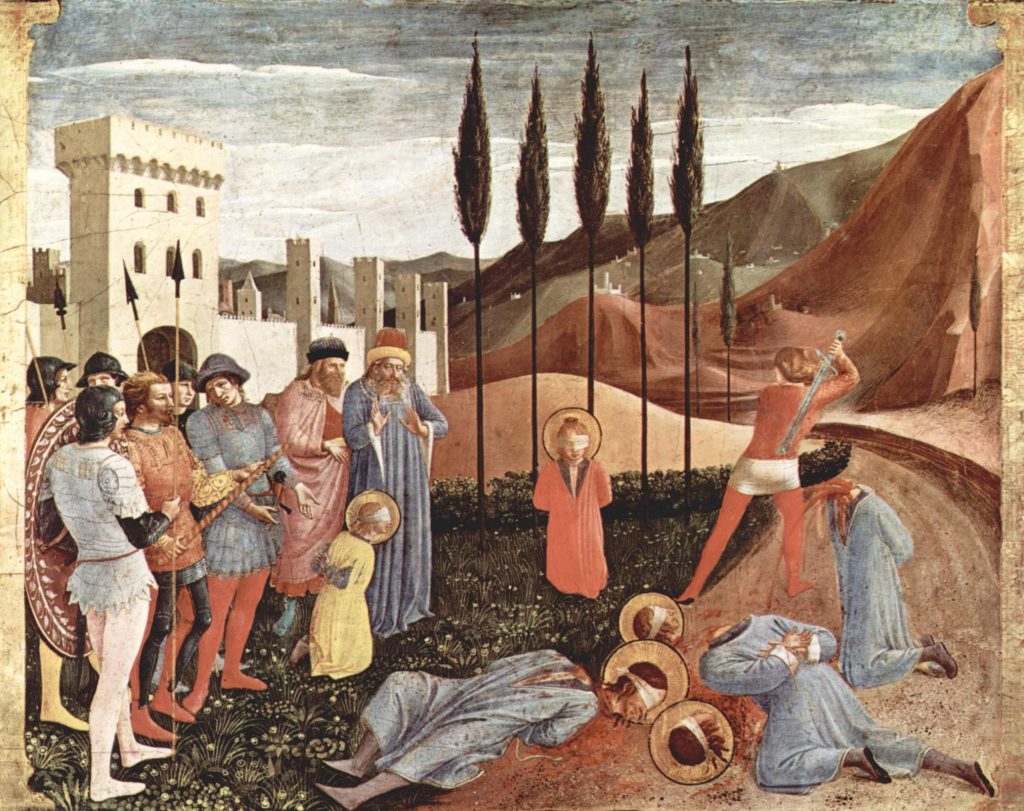
Then, other Italian wines began to be among the most expensive. The wine Ribolla, also marketed by the Venetians, was perhaps originally from Friuli or Istria. It was a sweet and strong white wine, but less than the oriental ones. Trebbiano was a dry white wine, probably of Tuscan origin, widespread in many other regions. Furthermore, Vernaccia began to be produced also in Tuscany. As in the previous cases, in fact, the names of these wines were born from geographical links but then became indicative of a type of wine. At the time, they could therefore be produced in different territories, with the local varieties. Trebbiano and Vernaccia were mainly marketed by the Genoese and Pisans, then also by the Florentines.
Vernaccia, wine par excellence in The Decameron. Vernaccia was among the first wines to take a name in the Italian Middle Ages, thanks to the Genoese who managed to give it the status of luxury wine, capable of competing with the wines of Romania. The success then brought production out of the Ligurian borders, especially in Tuscany and Sardinia. This wine was praised by poets, such as Folgore from San Gimignano in the 13th century, and in the novellas (short stories) of Boccaccio or Sercambi of the 14th century. Above all, it is Boccaccio who frequently mentions it in the Decameron. In the short story "Calandrino and the heliotrope", Vernaccia is the symbol of pure enjoyment. Maso tells of the Land of Bengodi ("Great Enjoying") where the vineyards are tied with the sausages and the mountains are made of grated Parmesan cheese. There, it is possible to drink Vernaccia all day, which also flows in the rivers: "and nearby ran a river of Vernaccia, the best you ever drank, without any drop of water in it". In the short story "Calandrino and the stolen pig", Vernaccia takes on a magical value. Bruno and Buffalmacco, who enjoy making fun of the naive Calandrino, try to convince him to pretend the theft of his pig, to deceive his wife and enjoy the money. Because his refusal, they steal the pig secretly and accuse Calandrino of having implemented the plan on his own. At this point, they push him to organize a sort of "ordeal", those tests of the most ancient Middle Ages in the balance between religion and magic, to demonstrate who was the author of the theft. They make him believe that they are able to prepare enchanted ginger biscuits, served with Vernaccia, which will be indigestible for the culprit of the theft. All the inhabitants of the village are invited to the test, who are served biscuits and wine. The two pranksters manage to give only Calandrino some biscuits made very bitter by the addition of aloe, blatantly demonstrating his guilt. The final joke is that the poor man is also forced to give them two capons, so that they do not tell anything about what happened to his wife. In another short story, Vernaccia also demonstrates healing abilities. In fact, the brigand-gentleman Ghino di Tacco cures the terrible stomach ache of the abbot of Clignì with a diet based on toast, broad beans and Vernaccia ("Ghino di Tacco and the abbot of Clignì").
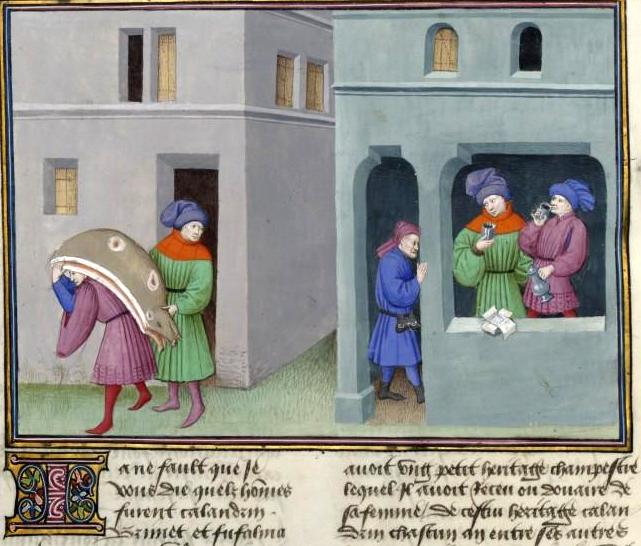
To be continued ...
Bibliography:
Prof. Alfonso Marini (AA 2020-2021) Dispense del corso di storia medievale.
Pini, Antonio Ivan (2003) Il vino del ricco e il vino del povero. In: La civiltà del vino. Fonti, temi e produzioni vitivinicole dal Medioevo al Novecento. Atti del convegno (Monticelli Brusati, Antica Fratta, 5-6 ottobre 2001). Centro culturale artistico di Franciacorta e del Sebino, Brescia, pp. 585-598.
Antonio Saltini (1998), Per la storia delle pratiche di cantina (parte 1) enologia antica, enologia moderna: un solo vino, o bevande incomparabili? In Rivista di Storia dell’Agricoltura n.1, giugno 1998.
Anna Maria Grasso, Girolamo Fiorentino (2012) Archeologia e storia della vite e del vino nel medioevo italiano. Il contributo dell’archeobotanica e di nuove metodologie di analisi integrate per la caratterizzazione varietale applicate ai contesti archeologici della Puglia meridionale. 2012, VI Congresso Nazionale di Archeologia Medievale
AAVV (1988) Il vino nell’economia e nella Società italiana medioevale e moderna. Convegno di Studi Greve in Chianti, 21-24 maggio 1987 Firenze, in Quaderni della Rivista di Storia dell’Agricoltura, Accademia dei Georgofili Firenze.
Emilio Sereni (1961), Storia del paesaggio agrario italiano, Editori Laterza.
Pietro Stara (2013), Il discorso del vino - origine, identità, come problemi storico-sociali, ed. Zero in Condotta.
The wine in the Early Middle Ages: between pleasure and sacredness
Italy, called the Enotria by the ancient Greeks (= "land of wine"), continued to be its homeland even in the Middle Ages, but the transition from Roman times was certainly not easy (as I have already told here). Already from the end of the Roman Empire, there was a generalized political crisis, with wars and invasions, which was also reflected in the viticulture crisis. The cultivation of the vine requires high specialization, as well as constant and expensive care for almost the year, so it suffers more than many other crops in times of instability.
Gregory the Great wrote in the 6th century that in Italy “eversae urbes, castra eruta … nullus terram nostram cultor inhabitat”: “the cities are destroyed, the castles demolished, … the lands deserted by farmers”. The production of wine therefore dropped significantly, albeit in a different way in different European areas.
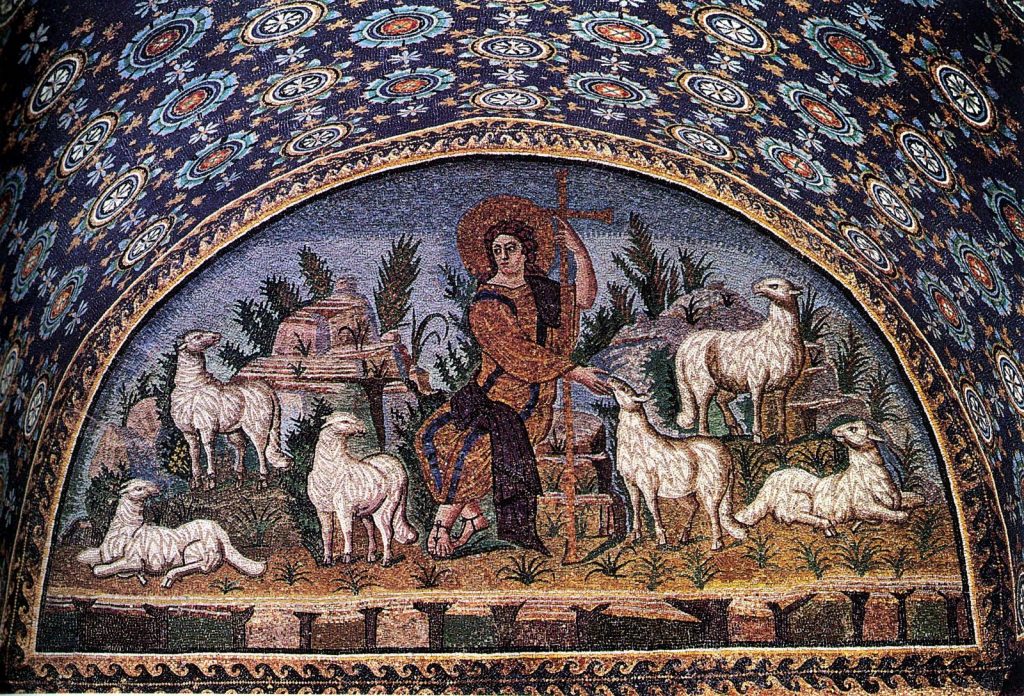
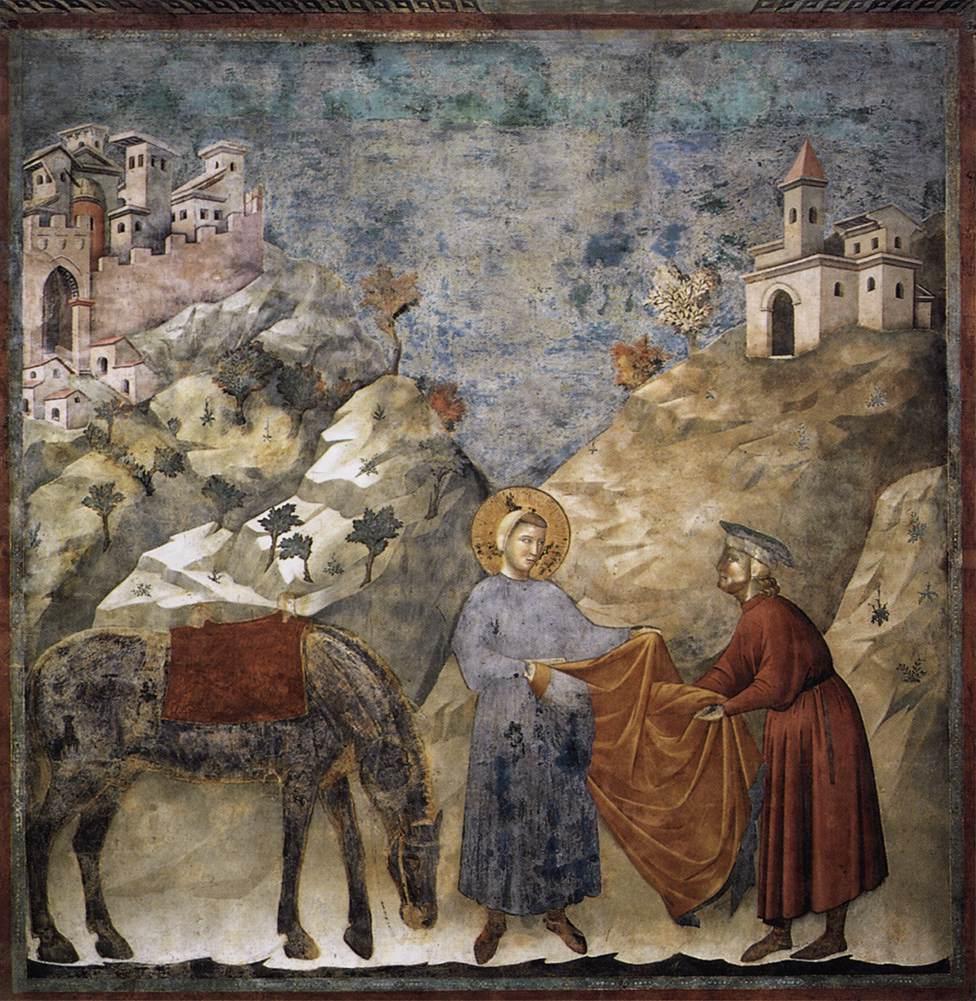
In general, the reduction in production made the wine a product almost exclusively of the rich and powerful, as in very ancient times. The mass of the people partly turned to poorer alcoholic products, obtained by fermenting the available fruits, such as apple, fig, carnelian, rowan, blackberry, medlar, etc. As mentioned in the previous post, the refined Roman production techniques, both viticultural and enological, were lost, as well as knowledge in many other fields. In the Middle Ages something then re-emerged, as evidenced by the agrarian treatise by Pietro de' Crescenzo from Bologna (1304). Most of this knowledge will be regained more later.

The Christian religion played a great role in this complicated transition. The wine was used in religious rites since ancient times but in Christianity it assumed an importance as perhaps never before. The Mass took shape precisely in this period and in the Eucharistic rite the act of Jesus Christ of the Last Supper was repeated ("This is my body, this is my blood"). The Middle Ages was a period very rich in symbolism: the bread was also a symbol of active life, the wine symbolized contemplative life, that is, the ability to know the essence of things, a virtue that God has granted only to human beings among all his creatures. In any case, wine became a fundamental raw material for mass and its production was therefore indispensable for every church and every convent. The production of Mass wine was tried everywhere, even where the climatic conditions were prohibitive or otherwise difficult.
The miraculous wine. The wine also played a very important role in the many miracles attributed to medieval saints. It is wrotten in the book "Tractatus de miraculis S. Francisci" (Treatise on the miracles of St. Francis) by Tommaso da Celano (1247-1257): "When he was at the hermitage of St. Urbain, the blessed Francis was gravely sick; he asked for some wine with dry lips, they told him there was none. He then asked some water and, when they brought it to him, he blessed it with a sign of the cross. Immediately, the water lost its flavor, and took another. What before was pure water became excellent wine, and what poverty could not, sanctity provided. After drinking it, that man of God recovered very quickly and as the miraculous conversion of water into wine was the cause of the healing, so the miraculous healing testified to that conversion.”
The gravestone of a 9th-century abbot from Milan reads: "Templa, domos, vites, oleas, pomeria struxit", that is, "he built palaces and houses, planted vines, olive trees and fruit trees". The monastic orders and bishops dealt abundantly with viticulture, not only for liturgical purposes, but also to have this drink as a sign of hospitality towards illustrious guests (or not). Around the year one thousand, the invasions and wars eased and civilized life began to regroup. The vineyards also extended to the nascent new political order, made up of princes and lords, by imitation of the Church, by prestige and to honor the guests.
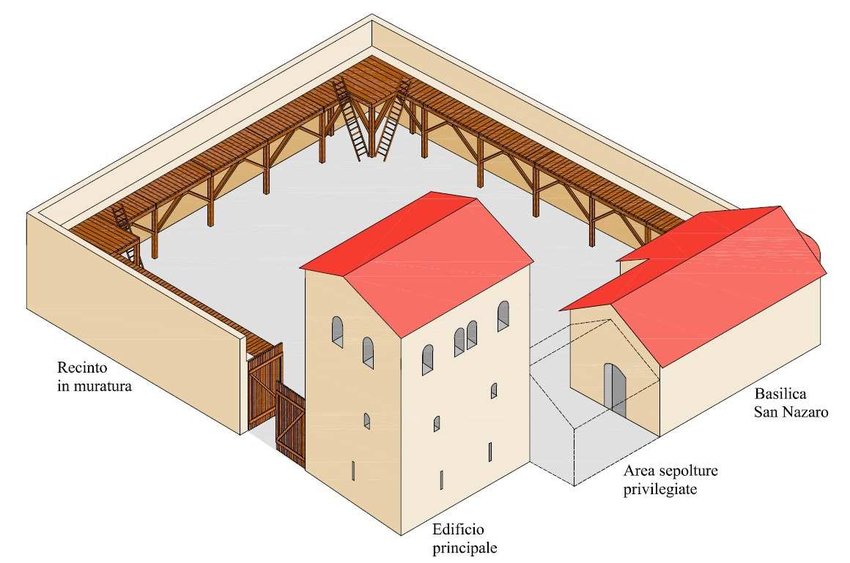
The reorganization of the countryside often restarted from the ancient Roman villae, where the invader, the new lord, settled. In Lombard and Byzantine times, the old villa, which has now become a fortified farmhouse (castrum), was the center of the new territorial lordship, called curtes or domuscultae or massae, ... depending on the different areas of Italy. It was the place of residence of the lord or of his local administrator or of the ecclesiastical power. The castrum formed the pars dominica (the part of the lord), together with a church and directly managed agricultural areas, worked by non-free servants. They included cultivated fields, pastures, specialized crops such as vineyards or orchards, as well as particular resources such as mills, ponds, etc. The second element of the curtis was constituted by the pars massaricia, that is the farms cultivated by dependent peasants, required to pay taxes and work also in the pars dominica. We speak of the feudal system, very similar to that of Late Roman Empire (see here)
Another religion, Islam, which was born in this period (7th century AD), instead led to the disappearance of wine production in all those Mediterranean countries that came under its influence. It seems that only a small production made for pharmaceutical purposes but also for clandestine consumption, more or less tolerated by the authorities, survived. Moreover, the Christian and Jewish communities often maintained the possibility of producing wine in derogation, with payment of a tax. A particular case seems to be represented by Sicily, whose Arab invasion began in 827 and lasted until the beginning of the Norman conquest, in 1061. A recent research has revealed that the production of wine in the Arab Sicily not only continued but that it even increased, compared to the previous period. It is not known if the Sicilian Arabs produced or drank wine. Almost certainly, the numerous Christian communities that stubbornly opposed Islamization did it. However, it has been ascertained that there was a significant trade in Sicilian wine in the Mediterranean during the period of Arab domination.
However, in general, in the early Middle Ages a new geography of wine was born, defined more or less by the borders of Christianity, with a center of gravity a little more shifted from the Mediterranean towards the heart of Europe.
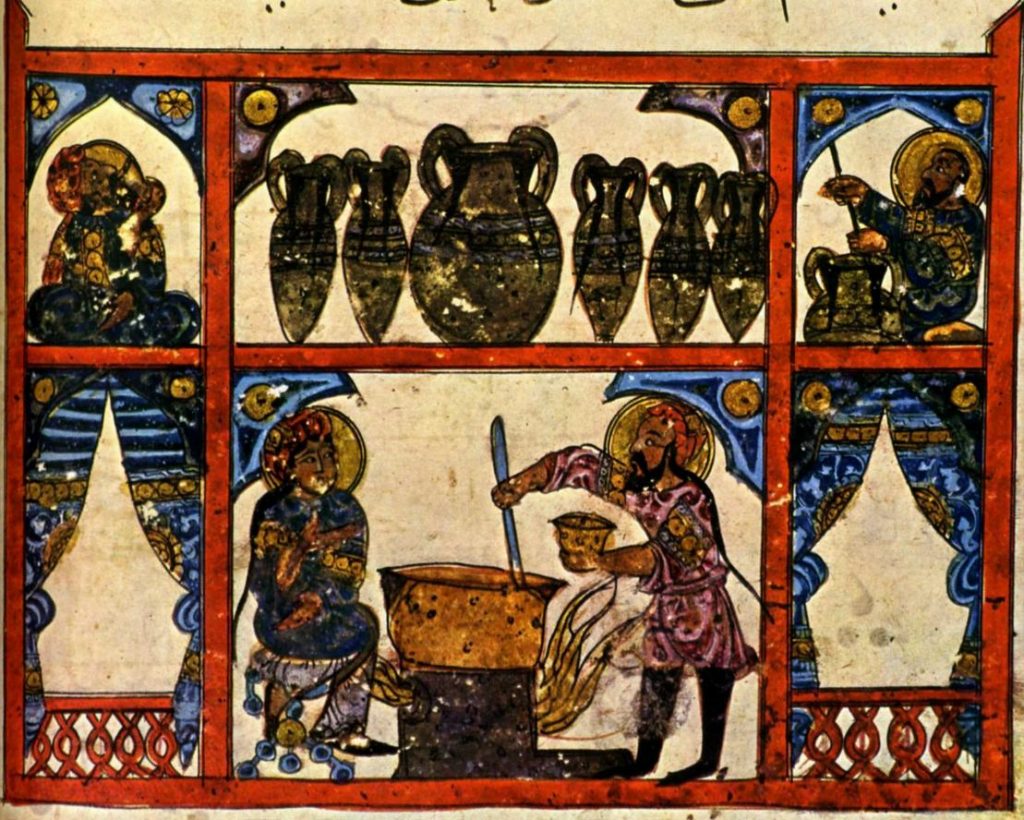
The center of agricultural knowledge was the Arab world int he Early Middle Ages, as in many other fields. Among the many treatises on agriculture, the one considered to be the most important was written by Ibn al-Awwam in the 12th century ("Book of Agriculture"). He was able to merge the legacy of the knowledge of the Romans, especially of Columella, with those of his time. However, he does not speak of wine, given the Koranic prohibition of alcoholic beverages. He only mentions the cultivation of grapes, for fresh and dried consumption. The cultivation is described in the two usual forms that we have already learned about, spread throughout the Mediterranean by the Romans: the low vine, cultivated as sapling without support, sometimes in holes or with poles, and the high one, often "married" to other fruit trees or pergolas.
If these indications are valid in general, there are also important differences between the Italian world of wine and that of more central and northern Europe. Where the climatic conditions were more difficult, the production of wine was more expensive and complicated, so for centuries viticulture remained almost the exclusive prerogative of ecclesiastics or lords. On the other hand, thanks to our Mediterranean climate, the winegrowing remained notably widespread even in the peasant world, because it was much more spontaneous and easier to manage. For example, Grasso and Fiorentino (2012) examined the archaeo-botanical remains of vine seeds in 39 medieval archaeological sites throughout Italy, from the 6th to the 15th century. AD They found evidence in almost all of them, not only in monasteries but also in villages, even in the most ancient centuries.
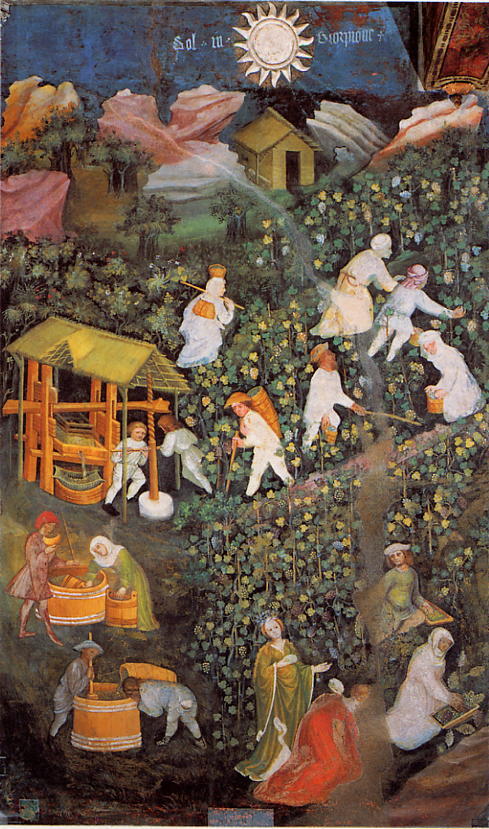
The viticulture in Italy was certainly reduced but not as dramatically as elsewhere. We can also think of a patchy situation, where some areas suffered more and others instead had more continuity with the past. For example, in the sixth century AD, Cassiodorus, minister of the Gothic king Theodoric, testifies in a letter to the quality of the wines produced by the peasants of the hills near Verona, in particular the acinaticum wine, a passito wine which he describes as follows: "A very rich set on the royal tables is praised as an ornament of the State [...] and, therefore, the wines that the fertile Italy produces in a singular way must be procured ... This is a very pleasant wine, regal in the color, singular in the flavor. [...] Its sweetness is felt with ineffable delicacy; its concentration receives vigor from I don't know what force; its density is incredible, so that you would say it is a fleshy liquid or a drink to be eaten."
The "dead's thirst". The wine stood between pleasure and religion for the people of the Middle Ages, between earthly and afterlife. This conception is magnificently exemplified in the Facezia XXX of the "Mottos and Jokes" by the Priest Arlotto (1484). One day, at dawn, the priest is talking to an innkeeper at the Uccellatoio hill (near Florence), when a panting man approaches and asks him to offer him some wine: "For Goodness sake, pay me a half-pitcher because I am very thirsty". Surprisingly, the priest Arlotto recognizes the man as the famous humanist Leonardo Bruni from Arezzo, and is amazed by his anxiety and such an early hour. Bruni replies: "Don't you see that I am dead? I must walk away and I cannot stay with you. Don't you see my problem: I am so thirsty and I have no money to pay for a little wine?". Then, the priest asks him amazed what happened his wealth, his science, his illustrious fame ... In short, he argument about the transience of earthly goods. Bruni's answer is obviously that nothing remains after death, that it is wise to enjoy life in moderation and also do good. The story shows the dead as a very anguish man, disoriented in front of an unknown journey. He dwells on his life, he is afraid for the divine judgment that is coming. He is in a hurry, cold but he makes very thirsty at the same time. The meeting between the living and the dead man takes place at dawn, on a road on the top of a hill, in an ordinary but at the same time supernatural situation, rich in symbolism on the theme of transit. As the historian Franco Cardini tells us, the "dead's thirst" is a theme that has ancient roots in the Mediterranean area. In various civilizations, particularly those of arid areas, where the suffering of thirst is well known, it was believed that the dead had difficulty in leaving life and suffered from a sort of thirst, that is, the urge to move on, to die permanently, to return into the earth. They need the living to help them die, by quenching their thirst. The ancient Greeks poured water into the crevices of the tombs in the Hydrophoria feast. In the Anthesteria festival, it was believed that the first rains of spring quench the thirst of the dead. I also remember you the Gospel parable of the poor Lazarus and the rich man, who gives nothing to the beggar of the leftovers of his rich table. After death, Lazarus goes to heaven and the rich man burns in the hellfire. The damned invokes Abraham to send Lazarus to at least dip his finger in the water to relieve his terrible thirst. However, the water is more linked to baptism in Christianity. The last drink, in continuity with the classical world, is instead the last glass of wine of farewell from the friends, therefore also the last drink of the funeral wake (or banquet), as well as the comfort of the Eucharist. The priest Arlotto offers the dead man, tired and frightened, the warmth of charity and of the last glass of wine, which gives him the strength and courage for his difficult journey.

To be Continued ...
Bibliography:
Prof. Alfonso Marini (AA 2020-2021) Dispense del corso di storia medievale.
Pini, Antonio Ivan (2003) Il vino del ricco e il vino del povero. In: La civiltà del vino. Fonti, temi e produzioni vitivinicole dal Medioevo al Novecento. Atti del convegno (Monticelli Brusati, Antica Fratta, 5-6 ottobre 2001). Centro culturale artistico di Franciacorta e del Sebino, Brescia, pp. 585-598.
Antonio Saltini (1998), Per la storia delle pratiche di cantina (parte 1) enologia antica, enologia moderna: un solo vino, o bevande incomparabili? In Rivista di Storia dell’Agricoltura n.1, giugno 1998.
Branca Paolo (2003) Il vino nella cultura arabo-musulmana. Un genere letterario… e qualcosa di più. In: La civiltà del vino. Fonti, temi e produzioni vitivinicole dal Medioevo al Novecento. Atti del convegno (Monticelli Brusati, Antica Fratta, 5-6 ottobre 2001). Centro culturale artistico di Franciacorta e del Sebino, Brescia, pp. 165-191.
Anna Maria Grasso, Girolamo Fiorentino (2012) Archeologia e storia della vite e del vino nel medioevo italiano. Il contributo dell’archeobotanica e di nuove metodologie di analisi integrate per la caratterizzazione varietale applicate ai contesti archeologici della Puglia meridionale. 2012, VI Congresso Nazionale di Archeologia Medievale
AAVV (1988) Il vino nell’economia e nella Società italiana medioevale e moderna. Convegno di Studi Greve in Chianti, 21-24 maggio 1987 Firenze, in Quaderni della Rivista di Storia dell’Agricoltura, Accademia dei Georgofili Firenze.
Emilio Sereni (1961), Storia del paesaggio agrario italiano, Editori Laterza.
Pietro Stara (2013), Il discorso del vino - origine, identità, come problemi storico-sociali, ed. Zero in Condotta.
https://www.agi.it/cultura/news/2021-02-24/islam-sicilia-vino-archeologia-11540051/
The golden period of wine in the Italian Middle Ages
And so that you wonder less at my words, consider the heat of the sun, which becomes wine when joined to the juice of the grape. (Dante, The Divine Comedy, Purgatorio Canto XXV)
Talking about wine and the Middle Ages, it is impossible not to mention Dante, who gives us a great definition: the wine is born from the perfect fusion between the heat of the sun and the earthly juice of the vine. As a perfect medieval man, however, it is not wine that he wants to talk about. The metaphor serves him to make reasoning of a religious nature. Dante is explaining the moment in which God blows the intellectual soul into the fetus, the one that characterizes the humans from all other living beings. With this act, the intellectual soul reabsorbs into itself the two natural souls, present since fertilization: the vegetative one, in common with plants, and the sensitive one, typical of animals. Thus, an intimate union is born, to the point that it is impossible to distinguish one soul from the other, just as described for wine.
The reasoning introduces us perfectly into the mentality of medieval person, for whom wine is wine, to be drunk, to be marketed, but it also becomes the blood of Christ, religious symbol par excellence, full of meanings and facets. Wine, as an abuse or vice, is opposed by the Church which, at the same time, makes it the protagonist of its religious rite and contributes to spreading its production like never before.
The Italian Middle Ages was a gold period for the production of wine, especially the one referred to as Late Middle Age, that is, the era of the Municipalities. Wine was produced and consumed in huge quantities, like never more since then. Italy was also the center of wine trade throughout the Mediterranean and towards continental Europe.
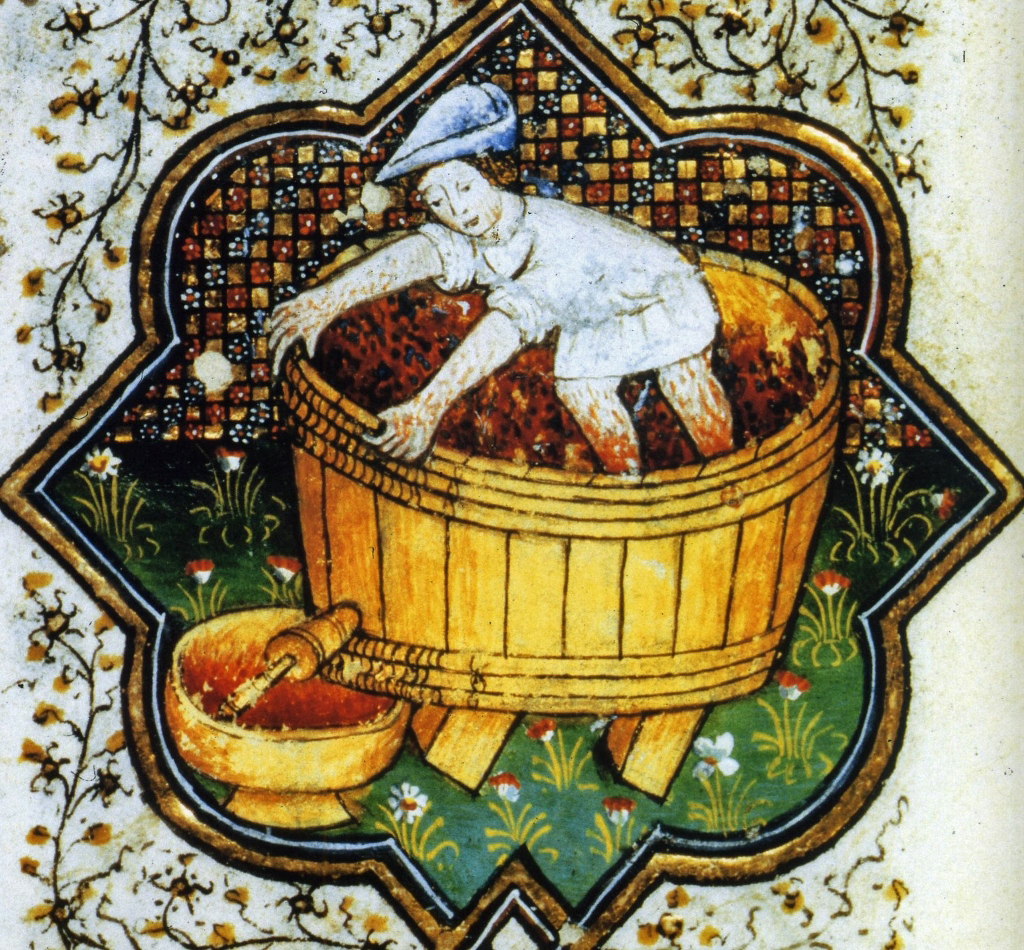
From antiquity to the Middle Ages: not only from the amphora to the wood
The transition from ancient to medieval production is often simplified in wine history books by focusing only on changing the containers. As is known, in ancient times terracotta amphorae (carefully waterproofed with wax, resins, gypsum and pitch) were used for winemaking, while in the Middle Ages wood dominated. According to the historian agronomist Saltini, this dichotomy was perhaps so clear for the rest of Europe, but probably not for Italy. In any case, the decidedly more important transformation was the loss of the remarkable production techniques achieved in Roman times, both in the viticultural and oenological fields. As I told you in my previous posts, in Roman times, especially from the late Republic, very advanced production techniques had been achieved, which made it possible to produce a huge variety of wines. They ranged from the cheaper ones to the more refined ones, still and sparkling wines, up to the real terroir-expressive wines (as we would say today). Wines were no longer drunk necessarily aromatized to cover their defects, as in much more ancient times, but were often drunk pure. In addition, they were storable. They ranged from the production of young wines to those capable of very long aging. In the Middle Ages, there was a return to a much simpler production of primordial wines. Even in the Late Middle Ages, wines were generally produced unable to exceed six months of life. It will still take several centuries before the best techniques return to be rediscovered and reintroduced into the wine production.
In the Middle Ages (and even after), the wines were consumed within one year from the production. In reality, after a few months, they were already altered in the taste, and people waited anxiously for the products of the next harvest. We will see how, for centuries, the only wines that managed to last a little longer and therefore to be transported were only some Mediterranean wines, thanks to the high alcohol content. Wines produced in continental climates, especially the more northern ones, lasted very little, given the low accumulation of natural sugar in the grapes and, therefore, the low alcohol content.
The Florentine notary Lapo Mazzei (1350-1412) wrote in a letter to Marco Datini that the wine, after the middle of July, tasted like forage for livestock. The statutes of various municipalities in central and northern Italy decreed that the date of the harvest was indicated by law, so that no speculations could arise. They wanted to avoid that the harvest was brought forward more and more, in order to sell the new wine before all the others. In the Late Middle Ages, perhaps some technical improvement had occurred if Mazzei himself testifies in other writings of some 2-3 year old Ribolla, but these were rare cases.
The wine was very different from what we taste today. The frequent defects were covered at the time of consumption with the addition of spices, herbs and various aromas, sometimes even sweetened, as in Greek and Etruscan times. We will have to wait a long time to have a flawless product. According to the French historian André Tchernia, the end of the "Middle Ages of wine", understood as a product more or less rich in defects (especially a frequent acetic cue, oxidations, microbiological alterations, etc.), there will be after the epoch of the same name. A real productive transformation will take place only after the eighteenth century.
In any case, it is not quite correct to speak of only one medieval wine, just as I have tried to make it clear that there was no only one Roman or ancient wine. The medieval period was very long, with great difference between the areas and with notable transformations along the time. We will see how these wines were in the next posts.
But how much did they drink in the Middle Ages!?!
“Vinum dulce, gloriosum / pingue facit et carnosum / atque pectus aperit. / Et maturum, gusto plenum / valde nobit est amenum / quia sensus asuit. / Vinum forte, vinum purum / reddit hominin securum / et depellit frigora …”.
Medieval anonymous
"Wine, sweet and glorious, fattens man and gives him health. The ripe and full-flavored one is very welcome and sharpens the senses. The strong and pure wine makes man safe and keeps the cold away ... "
The consumption of wine in the Italian Middle Ages (at least from the 13th century), as in ancient times, was daily and very abundant. The situation was quite different in North Europe, where wine remained the drink of the clergy and the rich for a much longer time, both for production and for consumption.
But you don't think that everyone was always drunk :-). The more alcoholic wines, such as ours, were then reserved only for important events, such as the visits of guests, banquets, parties, ... The daily consumption mainly concerned a light and low alcohol wine, often diluted with water. There was also the so-called "vinello" ("little wine") or "acquerello" (the "loria" of the Roman era), a slightly alcoholic product obtained by the extraction of alcohol and aromas from the marc with water. The production of the "vinello" will end in Italy only in the early twentieth century, prohibited by law to combat fraud on the market. Returning to the Middle Ages, among the different types of wine, there was not only a distinction between wine for the rich and wine for the poor according to historians. Apart from the more expensive wines, which obviously the poor people could not afford, it seems that everyone drank wine on some occasions and light wines (or watered down or the "vinello") daily, to quench their thirst.
In fact, at the time, drinking water was very unhealthy: the rivers and the wells were often dirty with mud and waste, the water easily had microbiological contamination that caused dysentery or other diseases (as still happens today in some very poor countries). For this reason, it was considered healthier to drink a very light wine. This is not so wrong: even a low alcohol content can be enough to eliminate some microorganisms.
How much did they drink at the time? It has been estimated that the average consumption of a citizen of Florence or Bologna in the fifteenth century could be almost two liters per day. Consider that the average in Italy today is about 22 liters per year. However, the comparison is impossible: today we drink more alcoholic wines, rightly in moderation (and not everyone is wine consumer). The children drank also, not only the adults. For example, in the fifteenth-century, in the treatise by Bartolomeo Platina (De honesta voluptate et valetudine), wine is not recommended only for infants under 5 months. However, for children and teenagers up to 14 years of age it was indicated only during meals, watered down for the little ones. They were considered adults after the age of 14.
The wine was obviously also drunk for pleasure, as an escape from the difficulties of everyday life. The wine thus also entered the goliardic songs of the wandering Clerics, the students who moved from all over Europe to study in the Italian cities where the first universities in the world were born, Bologna, Padua and many others. Here is a goliardic chant of the thirteenth century, "In taberna quando sumus", in the famous reinterpretation by Carl Orff (Carmina Burana).
... Tam pro papa quam pro rege / bibunt omnes sine lege. /Bibit hera, bibit herus, / bibit miles, bibit clerus, /bibit ille, bibit illa, /bibit servus cum ancilla, / bibit velox, bibit piger, / bibit albus, bibit niger, / bibit constans, bibit vagus, / bibit rudis, bibit magus. / Bibit pauper et egrotus, / bibit exul et ignotus, / bibit puer, bibit canus, / bibit presul et decanus, / bibit soror, bibit frater, / bibit anus, bibit mater, / bibit ista, bibit ille, / bibunt centum, bibunt mille...
... To the Pope as to the king / they all drink without restraint. / The mistress drinks, the master drinks, / the soldier drinks, the priest drinks, / the man drinks, the woman drinks, / the servant drinks with the maid, / the swift man drinks, the lazy man drinks, / the white man drinks, the black man drinks, / the settled man drinks, the wanderer drinks, / the stupid man drinks, the wise man drinks, / The poor man drinks, the sick man drinks, / the exile drinks, and the stranger, / the boy drinks, the old man drinks, / the bishop drinks, and the deacon, / the sister drinks, the brother drinks, / the old lady drinks, the mother drinks, / this man drinks, that man drinks, / a hundred drink, a thousand drink ...
At the time, the wine was not only consumed for pleasure and to quench one's thirst but was also considered positive for health, a sort of corroborating drug for the sick, as in ancient times. The wine was definitively released from the official medical treaties only in the 18th century. It was given to patients and pilgrims in hospitals. Even the poor were given both bread and wine as basic food. The calories offered by the wine were very important to supplement the daily meals. There were frequent donations of wine by the wealthy citizens to the charitable institutions, meticulously noted in the bookkeeping of the institutions as well as in the domestic ones of the benefactors.
The wine was also part of the workers' wages, both the day laborers and the masons and many others, who could also refuse a job if the wine (or the "vinello") was denied or was not good enough. The French Ch. M. de la Roncière wrote in the fourteenth century, on a visit to Florence, that the Florentine salaried people suffer more from the lack of wine than of meat. He notes astonished: "Le vin coule à flots sur les tables florentines" (The wine flows in gushes on the tables of the Florentines). The religious also drank habitually. The friars of the hospital of Santa Maria della Scala in Siena who transgressed the rules, in the early 1300s, were punished with a diet of bread only, but the wine was nevertheless not denied.
The taverns and wine bars had to have regular licenses issued by the municipalities, while the wine could be sold for home consumption or to retailers by any private individual. The specialized wine producer, as today, did not exist. In Florence, for example, anyone who had a piece of land dedicated to the vineyard, whether small or large, sold wine, as long as they produced a surplus over their own family consumption.
The places for the consumption of wine were numerous in the cities and towns. De la Roncière writes again that in Florence there were bars and taverns on all street corners. The opening hours were strictly regulated by the Municipal Statutes, influenced by the religious control of the time on social life. For example, Florentine winemakers had to remain closed during Lent and Good Friday and in other religious periods. Even in Florence, it was not possible to open a tavern within thirty meters of churches and crosses. In Montopoli town, every wine shop had to be closed while the churches were celebrating sacred functions, therefore for almost all holidays. It was not only the wine that frightened the authorities, but the pairing with the gambling, which was also strictly regulated. The wine was also sold in the hotels. In Montaione town, in the fifteenth century, there are distinct lists of hotels between those who offer wine, favored by the Municipality, and those without.
In the Boccaccio's story "Cisti the baker" (Decameron, 1350-1353, Sixth Day, story II) Pampinea tells of Cisti, an intelligent and polite baker, despite his social class. He had "always the best white and red wines, among his other good things, that could be found in Florence or in the countryside" in his workshop. Every morning, he saw Geri Spina, a Florentine nobleman, pass in front of his shop in the company of other gentlemen, papal ambassadors. He would have liked to invite them to drink and be part of that cool company but, given his social class, he could not step up. So, he began to sit down in front of his shop every morning, sipping with great satisfaction one of his best white wines. After a few days, both out of curiosity and thirst, the company of Geri Spina asked to taste the wine and everyone was struck by his goodness. Since then, every day, the group stopped by the baker to chat and taste good wines. At the departure of the ambassadors, Geri Spina wanted to offer a banquet and also invited Cisti. However, he declined because he did not feel he could participate, but he still wanted to send him some of his excellent white wine. Geri sent a servant to get the wine. The latter, who wanted to keep part of it for himself, arrived at Cisti's shop with a very large bottle (the traditional Florentine fiasco). Cisti sensed the intent of the servant and sent him back, telling him that Geri certainly did not send him to his shop with that bottle, but rather to fetch water from the Arno (the river that crosses Florence). The scene was repeated twice. Geri then asked the servant to show him the bottle and seeing its size, he understood what had happened. Cisti confided to Geri that he did not refuse to fill the big bottle out of avarice but because that was a wine of such value that it could not be wasted on large containers. When the servant returned with the right bottle, Cisti filled it and offered it for the banquet. So, Geri became friend with him understanding his intelligence and wit, beyond his social class.
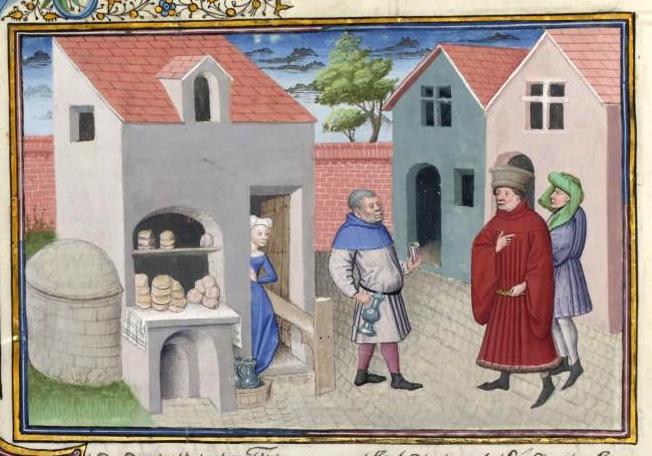
To be continued ...
Bibliography:
Prof. Alfonso Marini (AA 2020-2021) Dispense del corso di storia medievale.
Pini, Antonio Ivan (2003) Il vino del ricco e il vino del povero. In: La civiltà del vino. Fonti, temi e produzioni vitivinicole dal Medioevo al Novecento. Atti del convegno (Monticelli Brusati, Antica Fratta, 5-6 ottobre 2001). Centro culturale artistico di Franciacorta e del Sebino, Brescia, pp. 585-598.
Antonio Saltini (1998), Per la storia delle pratiche di cantina (parte 1) enologia antica, enologia moderna: un solo vino, o bevande incomparabili? In Rivista di Storia dell’Agricoltura n.1, giugno 1998.
Branca Paolo (2003) Il vino nella cultura arabo-musulmana. Un genere letterario... e qualcosa di più. In: La civiltà del vino. Fonti, temi e produzioni vitivinicole dal Medioevo al Novecento. Atti del convegno (Monticelli Brusati, Antica Fratta, 5-6 ottobre 2001). Centro culturale artistico di Franciacorta e del Sebino, Brescia, pp. 165-191.
Anna Maria Grasso, Girolamo Fiorentino (2012) Archeologia e storia della vite e del vino nel medioevo italiano. Il contributo dell’archeobotanica e di nuove metodologie di analisi integrate per la caratterizzazione varietale applicate ai contesti archeologici della Puglia meridionale. 2012, VI Congresso Nazionale di Archeologia Medievale
AAVV (1988) Il vino nell'economia e nella Società italiana medioevale e moderna. Convegno di Studi Greve in Chianti, 21-24 maggio 1987 Firenze, in Quaderni della Rivista di Storia dell’Agricoltura, Accademia dei Georgofili Firenze.
Video on Bolgheri DOC territory
The Consorzio Bolgheri DOC realized this video about our territory. Good vision!
Holidays closure
We will be closed from Monday 20th dec. We'll open on Monday Jan. 10th.
Season's greetings!

Guado al Melo News 2021
Here you are our News, about the last harvest and the year's memories. Here there is the PDF.

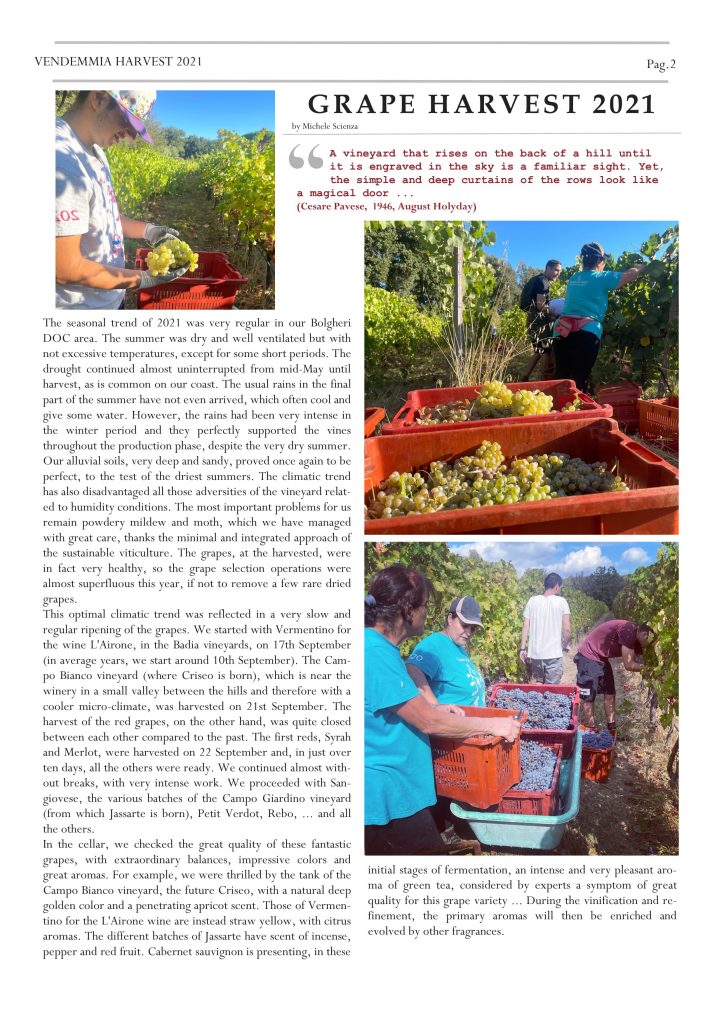
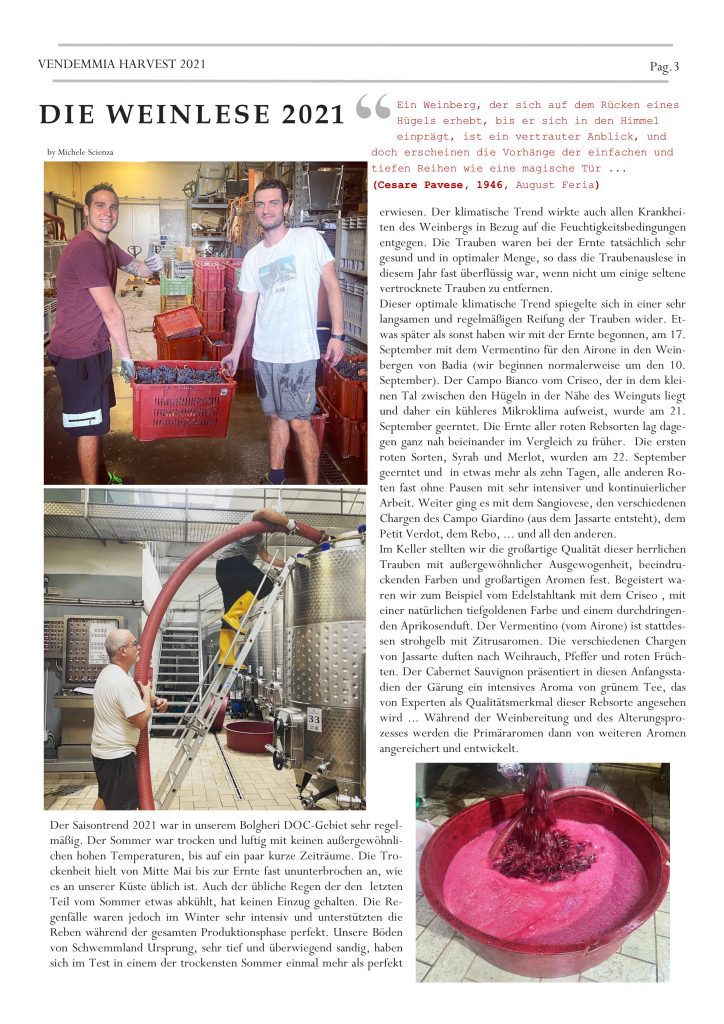
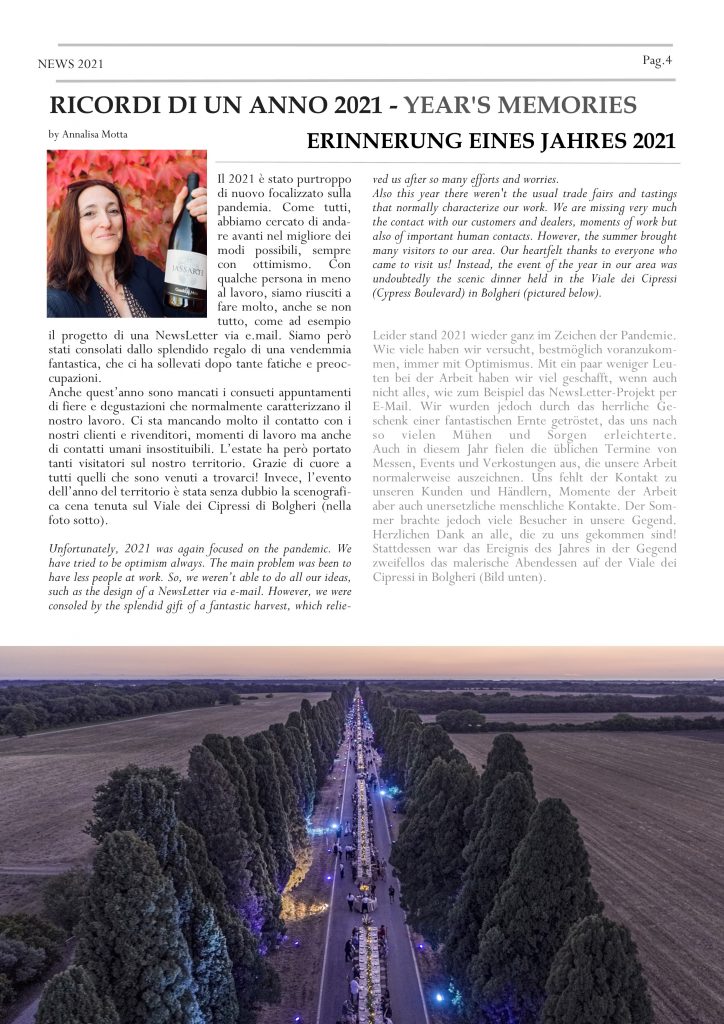
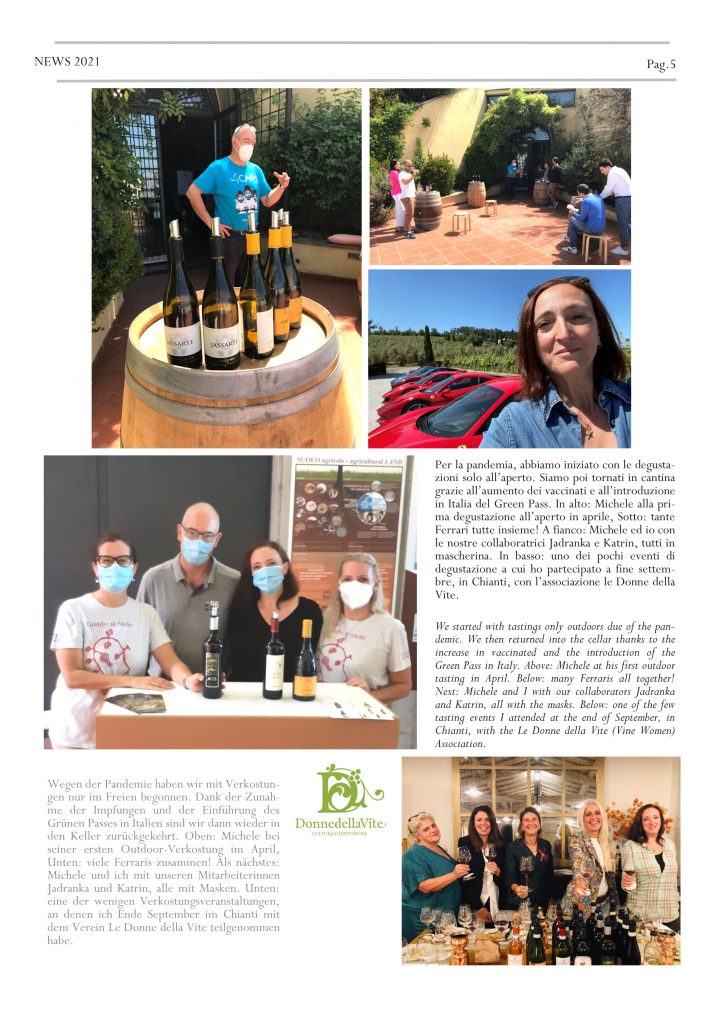
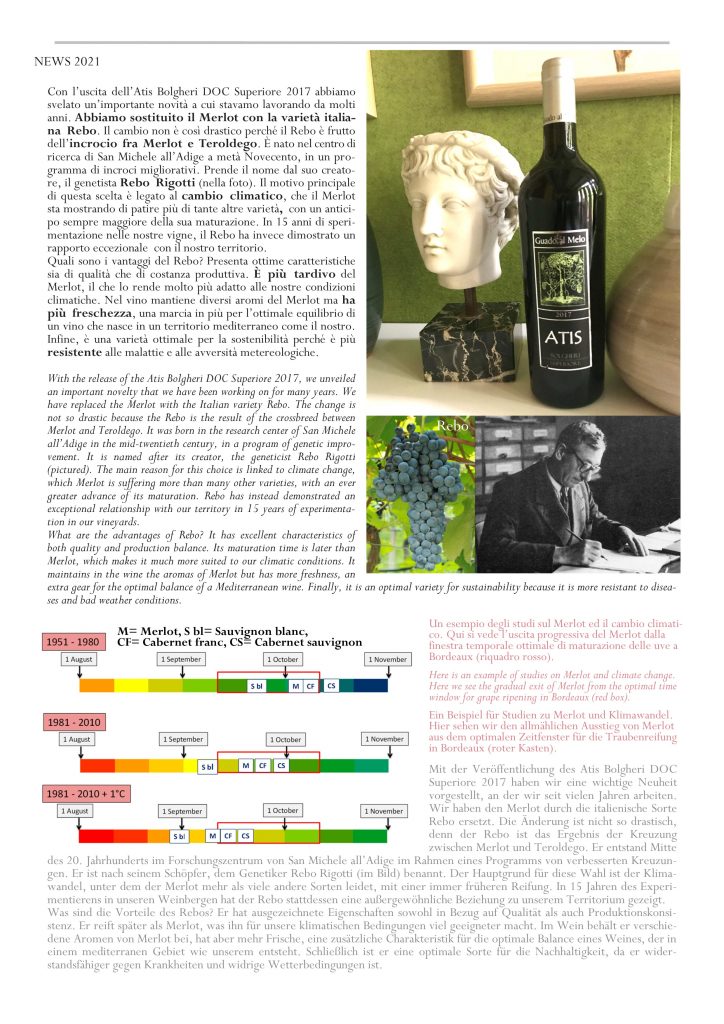
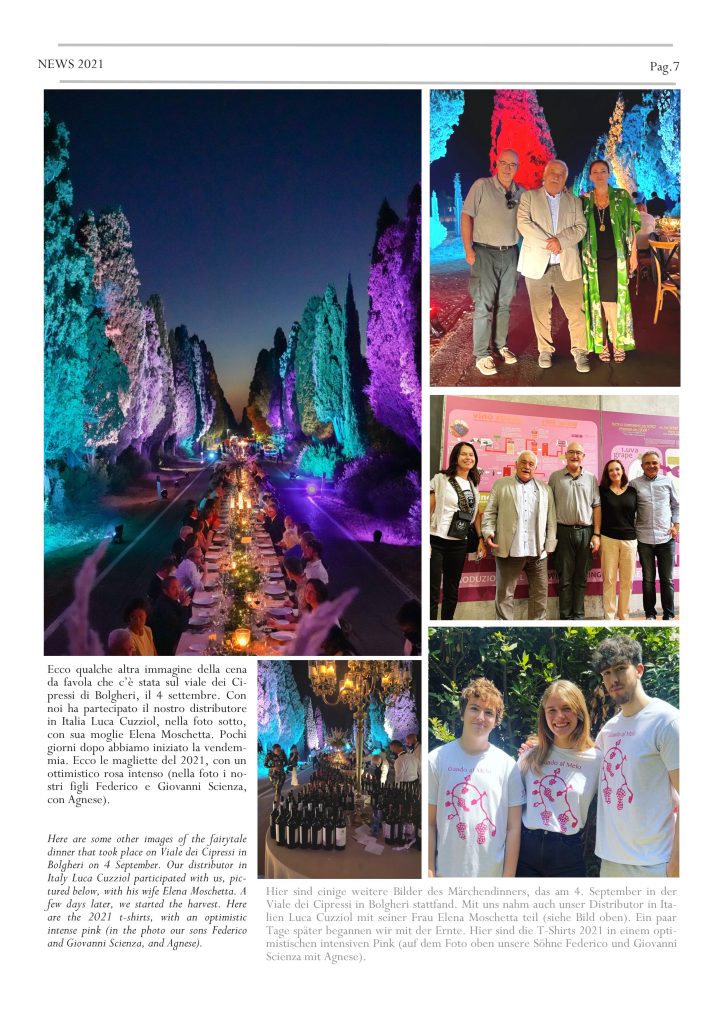
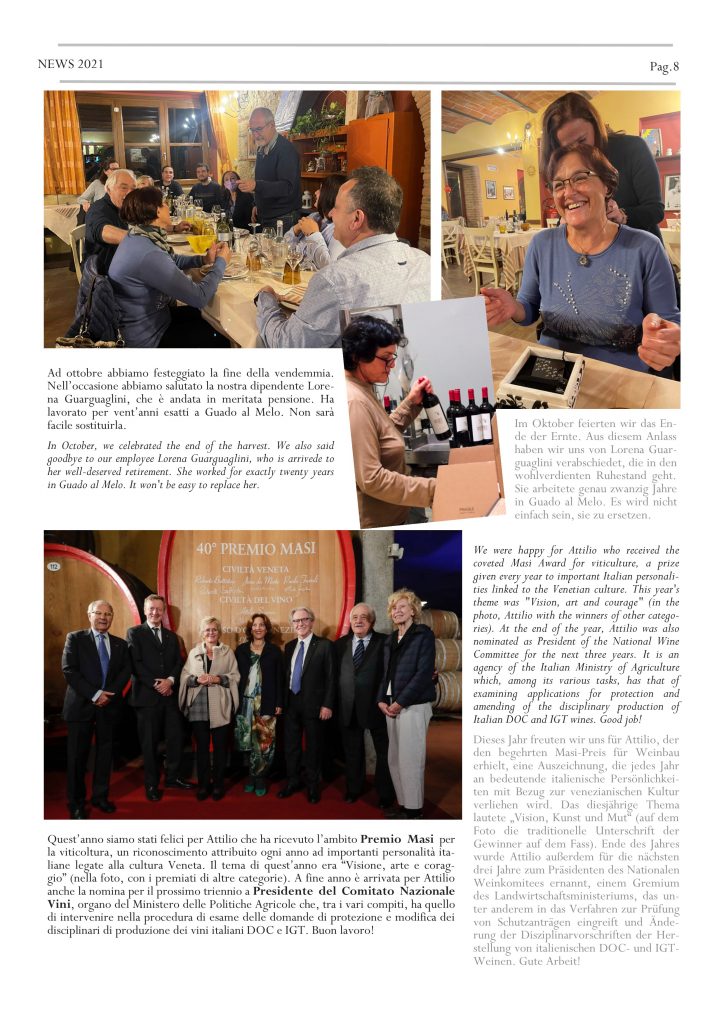
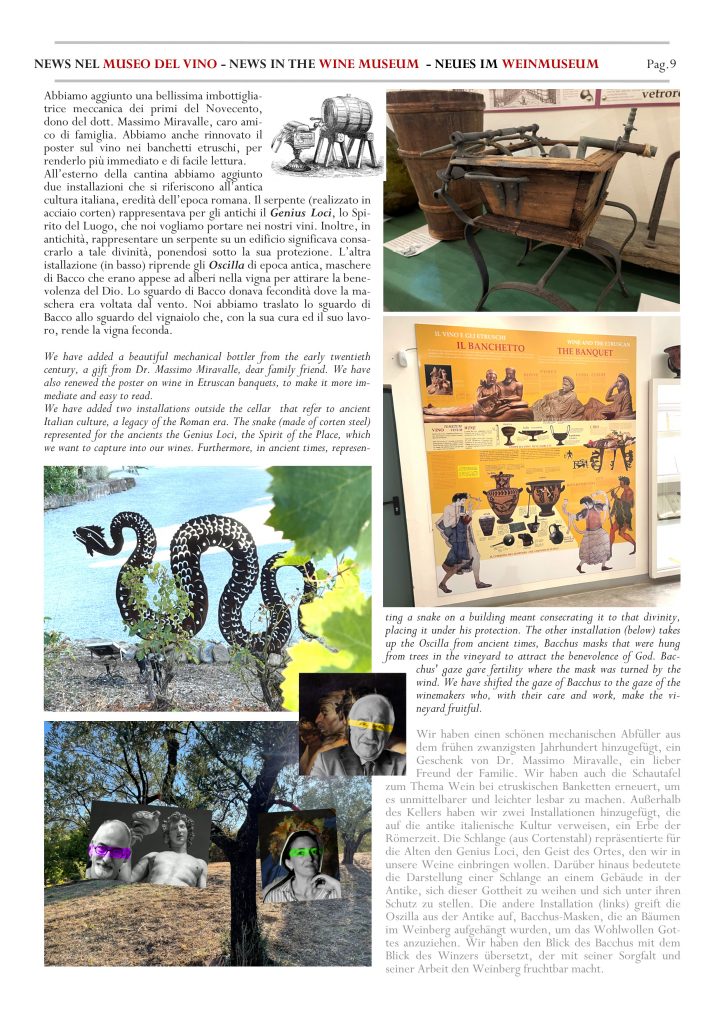
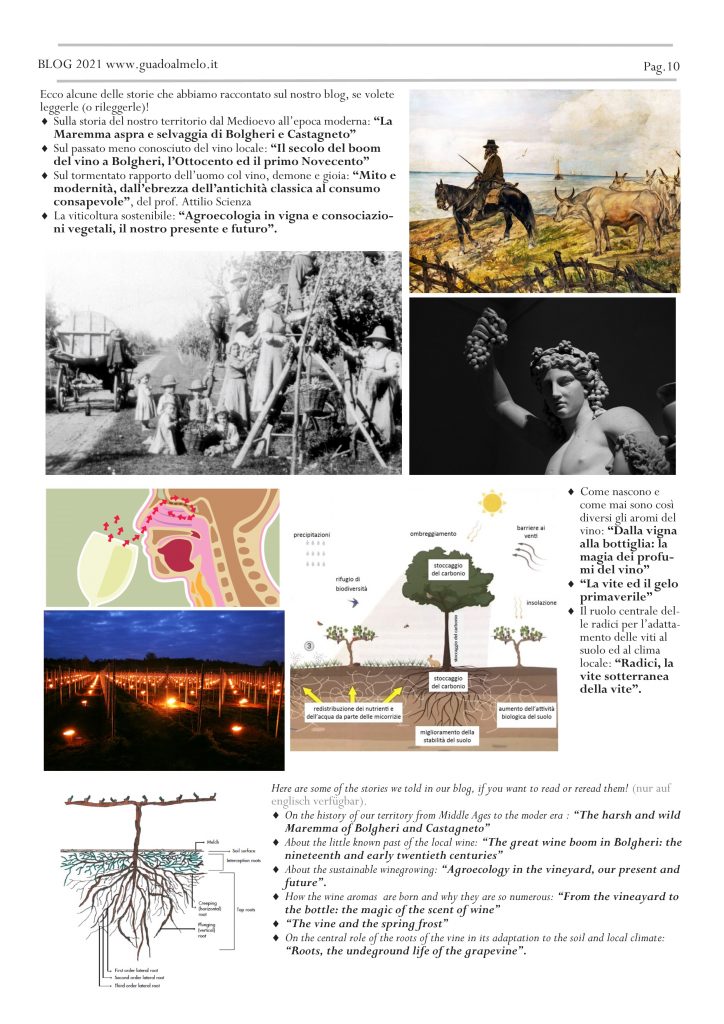
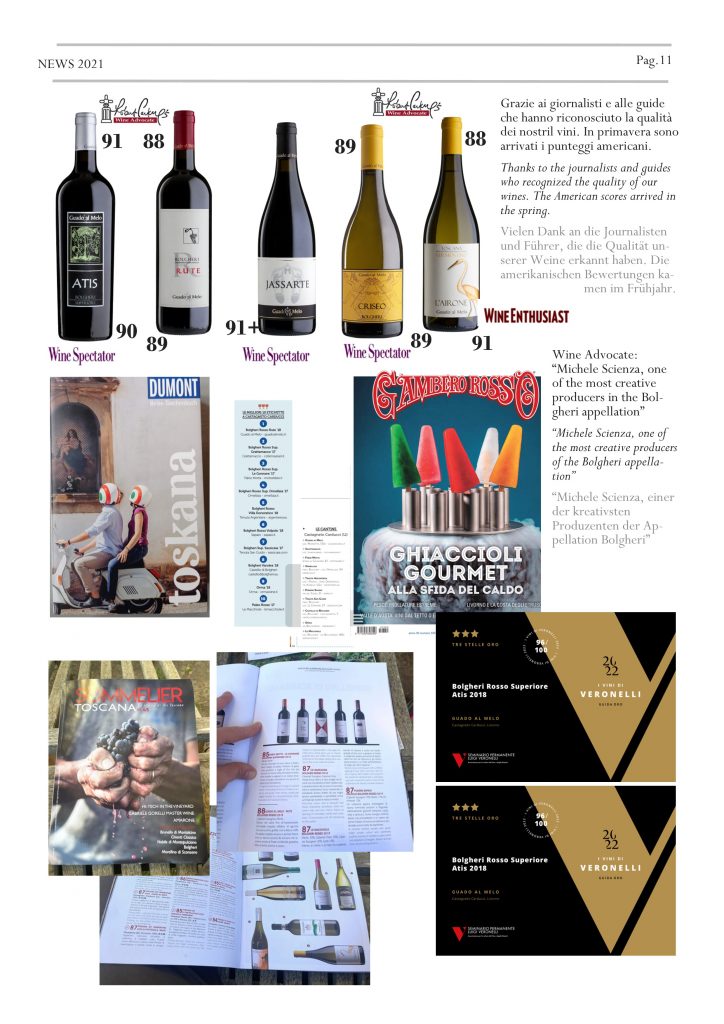
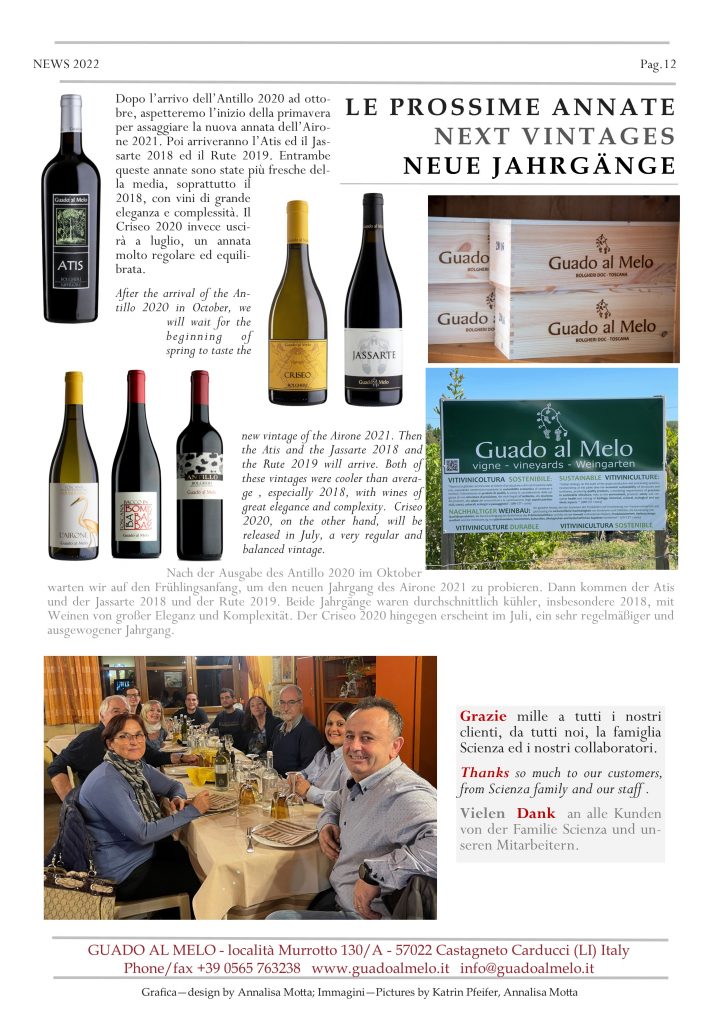
Atis and Jassarte: Golden Stars
Heartfelt thanks to the guide I Vini di Veronelli who awarded the Three Golden Stars to our wines Atis 2018 and Jassarte 2018, tasted in preview, with remarkable scores: 96/100 and 94/100.
The new 2018 vintage of both will be available, as usual, from next spring. For now, 2017 is still on sale.
2018 was a particular vintage.
It was preceded by a very dry 2017, which certainly limited the subsequent production. Winter and spring were very rainy, while summer was normal, with some rain at the end. The real surprise came in the second half of September. It was sunny, but temperatures lowered by about 10 degrees, thanks to the north-east wind (Grecale). Atis and Jassarte benefited in particular from this very special end of summer and early autumn, expressing a particular grace.


End of the tourist season
I remember you that, with October 31st, the tourist season ends for us. So, there will no longer be an opening time for tastings and visits to the wine museum. The hours you will see on Google will be the office hours.
The guided tours with tasting (Plena Visit) will are still possible, always and only by reservation. For groups of at least 10 people, they can be booked every day. For couples or small family groups, the visits take place preferably on Saturday, starting at 10.30 and at 15.00, grouping multiple requests.
The guided tours with tasting (Plena Visit) will are still possible, always and only by reservation. For groups of at least 10 people, they can be booked every day. For couples or small family groups, the visits take place preferably on Saturday, starting at 10.30 and at 15.00, grouping multiple requests.
Write or phone us (during the office opening hours) for any info
tel. +39 0565 763238 info@guadoalmelo.it
2021, a remarkable vintage: about the harvest
We concluded the 2021 harvest on Friday 1st October. It is always with prudence that we use certain words but we can say that 2021 was a great vintage. 2021 is one of those years in which everything went well in our vineyards. Obviously, I'm speaking for our reality, I know that there have been problems elsewhere. Recall that Italy has an incredible variability of climates and micro-climates. Any general consideration is always wrong.

The seasonal trend of 2021 was very regular in our Bolgheri DOC area. The summer was dry and well ventilated but with not excessive temperatures, except for some short periods. The drought continued almost uninterrupted from mid-May until harvest, as is common on our coast. The usual rains in the final part of the summer have not even arrived, which often cool and give some water. However, the rains had been very intense in the winter period and they perfectly supported the vines throughout the production phase, despite the very dry summer.
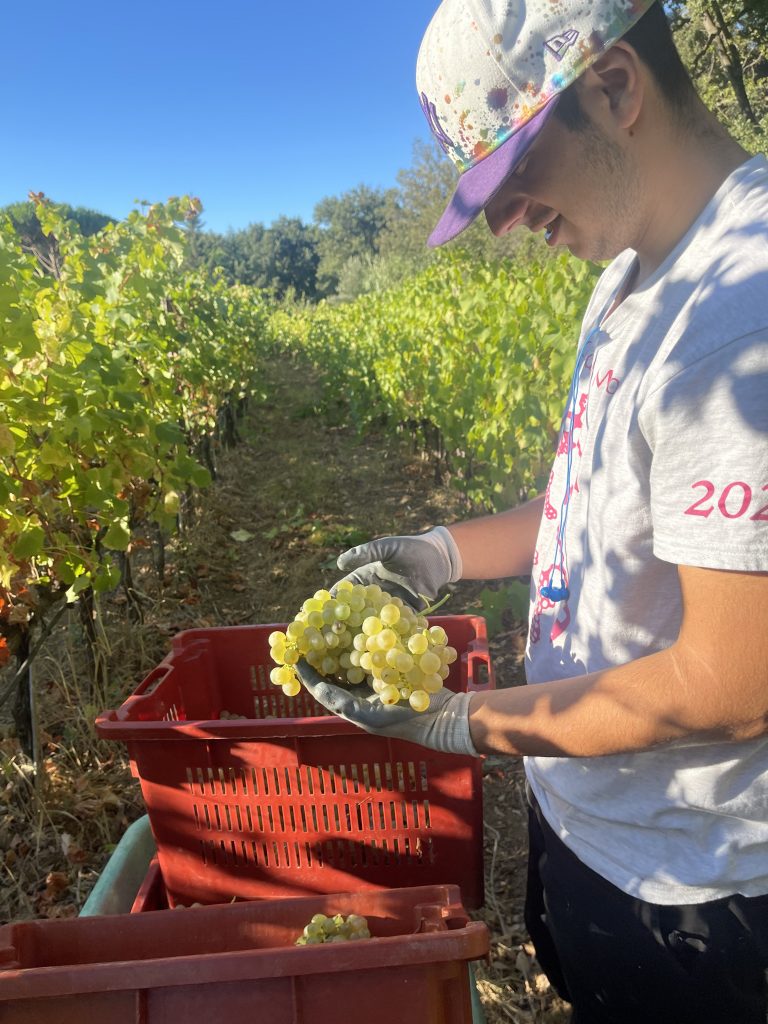
The vine, as we know, does not need a lot of water, but it must have enough to produce a great grape. It is not suffering in the Mediterranean area: this is its homeland and it has evolved perfectly to survive in this climate. In a territory like ours, with perfect pedoclimatic conditions for viticulture, the availability of water is the most important advantage (or limit), able to determine the difference between a great wine and a good wine. This difference depends from the choices made at the origins of the vineyard, first of all in the choice of the most suitable soils, that is, those that are able to guarantee the necessary quantity of water for our Mediterranean summers. Irrigation is not an option; it is not sustainable. Water is and will become an increasingly precious commodity for other primary purposes. If nature offers us soils suitable for viticulture, it is right that it be made there.
When it comes to soils, the emphasis is always on texture (clayey, sandy, etc.), often in a generalist way. However, perhaps the most important element in the Mediterranean area is depth. Only a deep soil allows the vine to fully express its incredible ability to become longer its roots to reach the water table which was filled in the cool seasons and lowered in the warm ones. This ability is also favored by lighter (sandy) soils, which are prevalent in Bolgheri. Those too clayey, here, with the summer drought, become impenetrable to the roots, hard as stone. The difference between vineyard and vineyard is in fact visible for those who know how to look. Wandering around our territory (or other Mediterranean ones) this summer, you could clearly see vineyards in good condition and others in water suffering, with numerous dry leaves and very few stunted clusters. Our alluvial soils are very deep and sandy. They proved once again to be perfect, to the test of the driest summers.
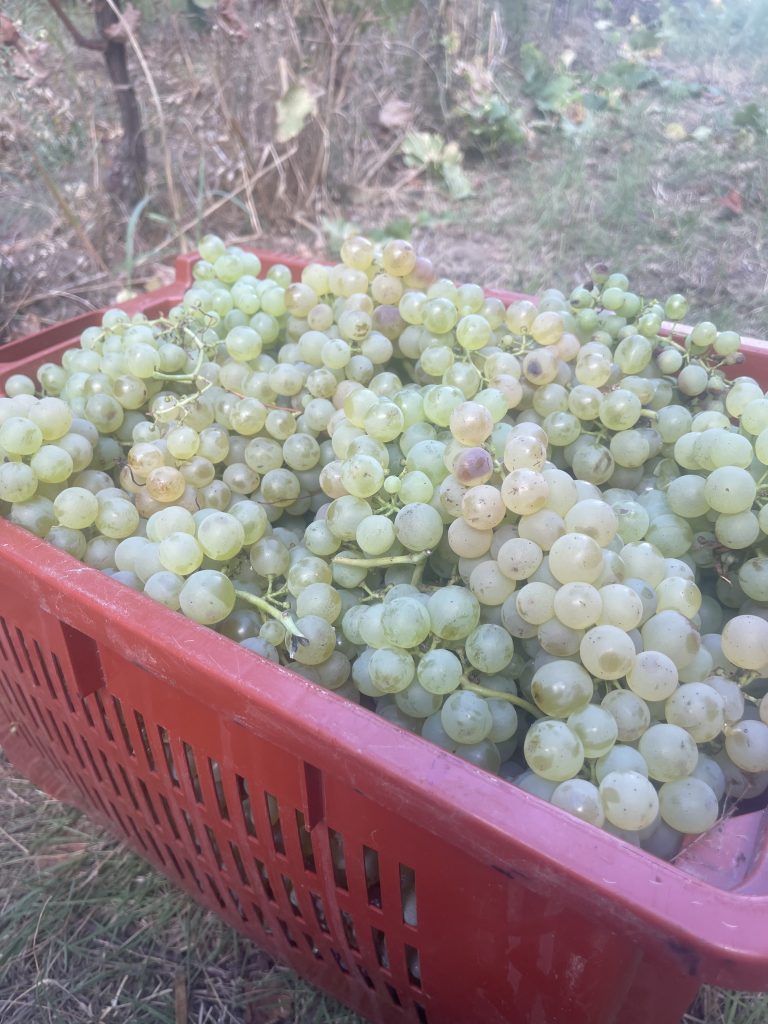
The climatic trend has also disadvantaged all those adversities of the vineyard related to humidity conditions. The most important problems for us remain powdery mildew and moth, which we have managed with great care, thanks the minimal and integrated approach of the sustainable viticulture. The grapes, at the harvested, were in fact very healthy, so the grape selection operations were almost superfluous this year, if not to remove a few rare dried grapes (just to be perfect).

Respecting our low production yields, even the quantity was not a problem, as it happened in the very dry and hot 2017. The problem, I repeat, is not the summer drought here. The big difference between 2017 and 2021 was above all that in 2017 it rained very little in the winter period. This year many areas of Italy have had production drops also due to the spring frost. Here it has not created any problems. There was a cold windy day that hit some little areas, but with very little damage as far as we are concerned. The problem in Bolgheri is not the frosts but the cold winds. The vineyards that do not run too many risks are those protected by natural barriers, such as hills or woods or rows of trees, toward north (Tramontana wind) and north-east (Grecale wind) directions.

This optimal climatic trend was reflected in a very slow and regular ripening of the grapes. The veraison itself was a bit delayed and then we harvest a little later than usual. As a rule, however, we are always among the last to start the harvest in Bolgheri, partly because we are in one of the coolest micro-climatic conditions, with the maximum temperature day-night range of the territory, and partly because we do not have some of the very early varieties that some of our colleagues have. We started with Vermentino for the wine L'Airone, in the Badia vineyards, on 17 September (in average years, we start around 10 September). The Campo Bianco vineyard (where Criseo is born), which is near the winery in a small valley between the hills and therefore with a cooler micro-climate, was harvested on 21 September. The harvest of the red grapes, on the other hand, was quite closed between each other compared to the past. The first reds, Syrah and Merlot, were harvested on 22 September and, in just over ten days, all the others were ready. We continued almost without pauses, with very intense work. We proceeded with Sangiovese, the various batches of the Campo Giardino vineyard (from which Jassarte is born), Petit Verdot, Rebo, ... and all the others. We concluded with the usual Cabernet Sauvignon on Friday 1st October. The harvest guys really did their best this year, with great dedication and determination, working with us tirelessly in the vineyard and in the cellar.
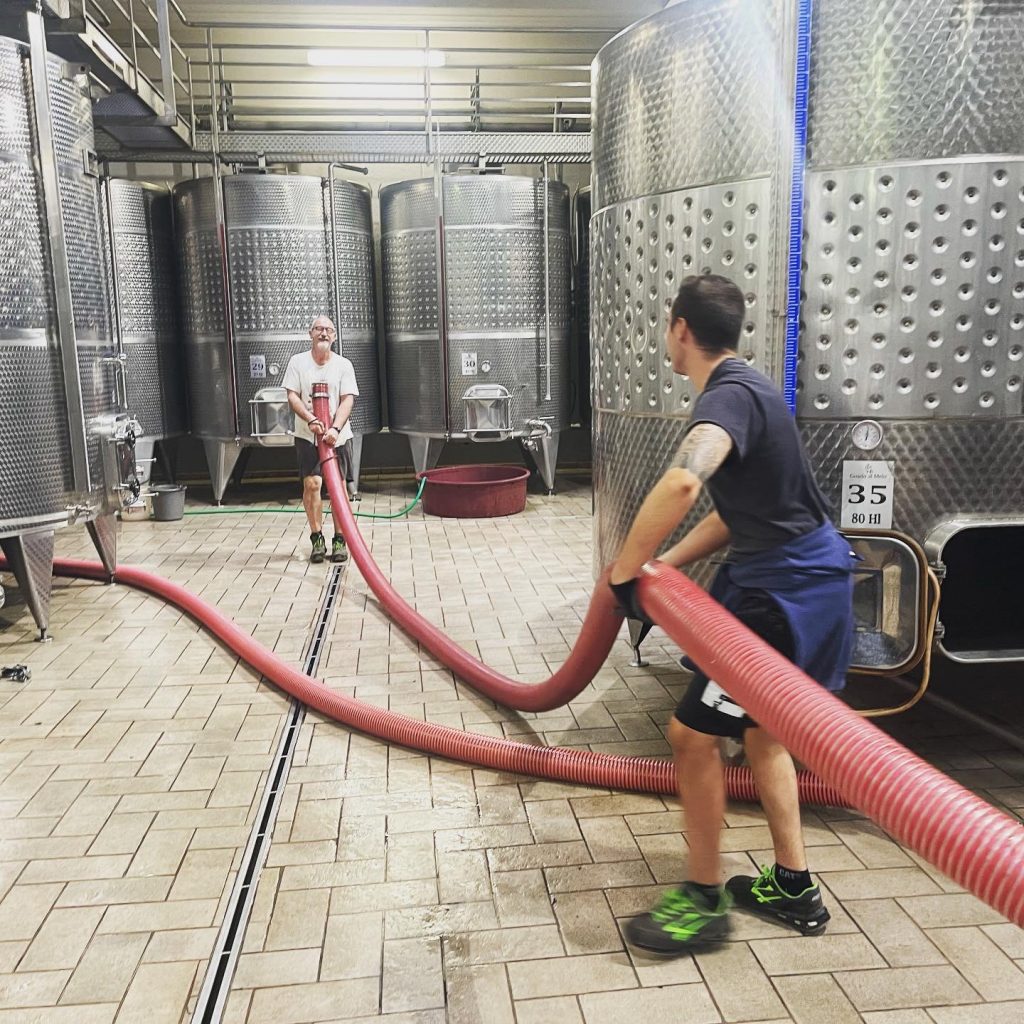
For Michele and me it was yet another fantastic experience of tasting the samples of the grapes, then the fermenting juices, following the transformations and making the difficult decisions from time to time. In the cellar, we checked the great quality of these splendid grapes, with extraordinary balances, impressive colors and great aromas. For example, we were thrilled by the tank of the Campo Bianco vineyard, the future Criseo, with a natural deep golden color and a penetrating apricot scent. Those of Vermentino for the L'Airone wine are instead straw yellow, with citrus aromas. The different batches of Jassarte have scent of incense, pepper and red fruit. Cabernet sauvignon is presenting, in these initial stages of fermentation, an intense and very pleasant aroma of green tea, considered by experts a symptom of great quality for this grape variety ... During the vinification and refinement, the primary aromas will then be enriched and evolved by other fragrances.
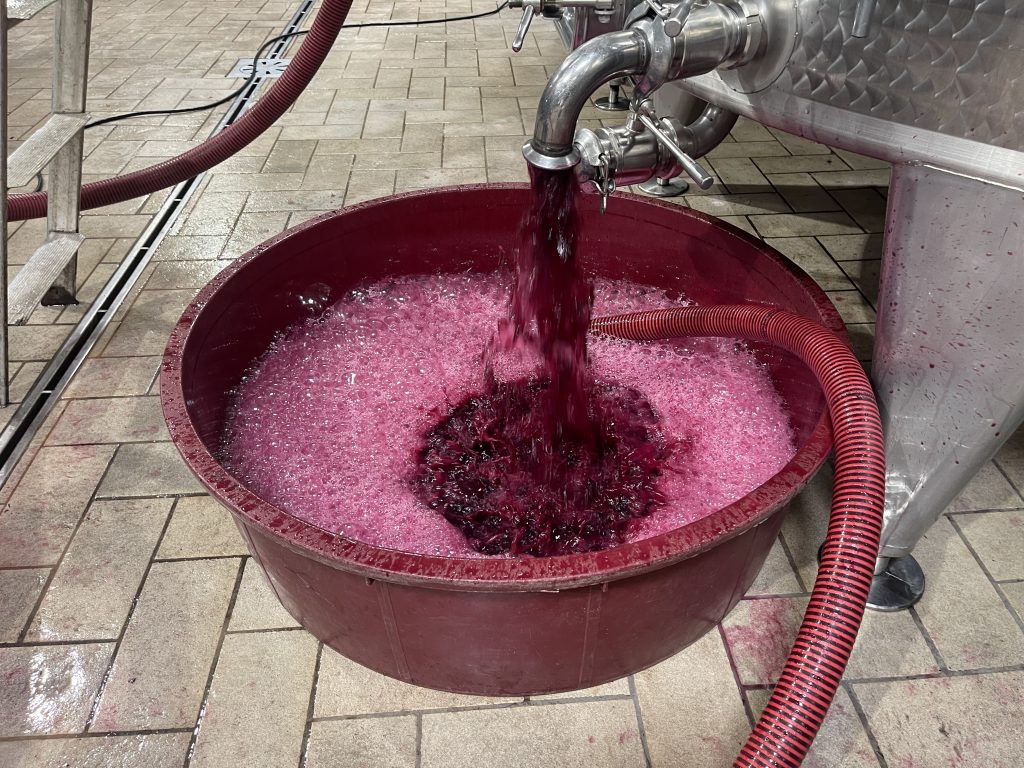
In artisanal wine producing, the balance of the wine is created in the vineyard, with a great deal of care for each plant, in different ways depending on the micro-climatic conditions, soil characteristics, variety, destination (young or aging wine ...) and vintage. In this way, each plant is in balance with its territory and produces a balanced grape, selected to be perfectly healthy, as well as harvested at the ideal moment of ripeness. Only with these premises it is possible to make a real terroir-expressive wine, with artisanal practices that accompany the transformation with care and respect, without making mistakes, but without corrections or other manipulations.
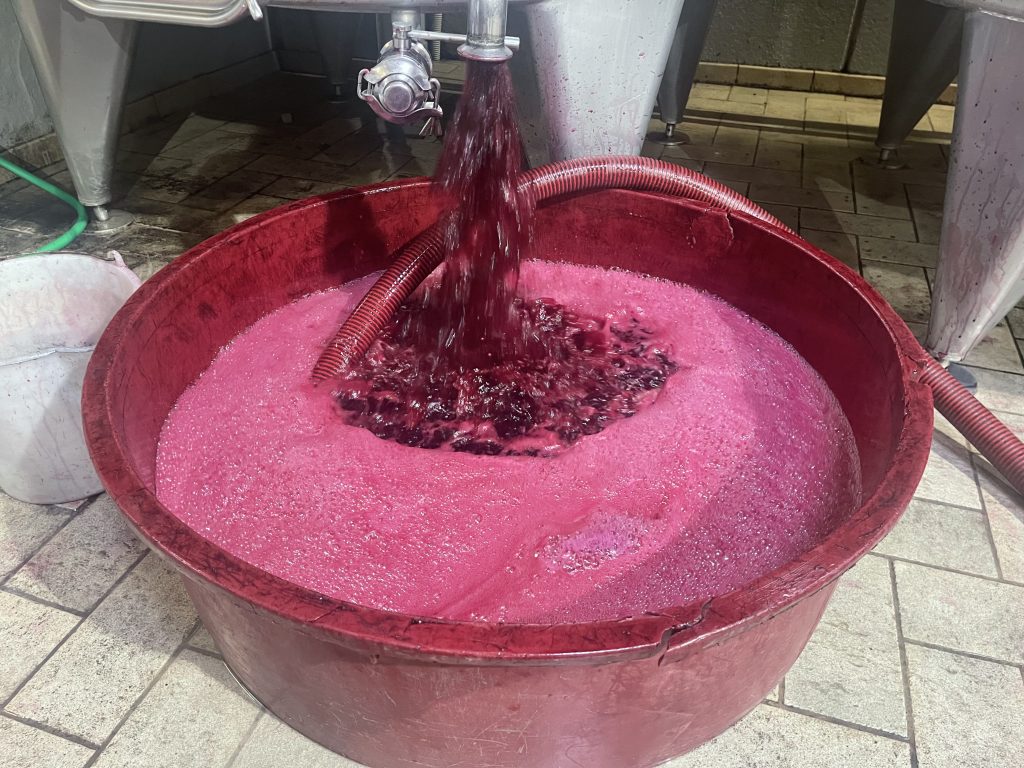
We are now in the vinification phase. Only some tanks have already finished fermentation and have been racked. Each of our small fermentation tanks hosts a homogeneous micro-particle of the vineyard, in some cases for a single variety (for our Bolgheri red wines, which are blends), sometimes with more varieties, to obtain the synergies that arise from the traditional practice of co-fermentation (as for Criseo and Jassarte). Fermentation and maceration are followed step by step, so that they continue on a regular basis, deciding how and when to do simple or aerating pumping over, to give some oxygen to the yeasts.
Tasting is always essential to decide the moment of racking, as well as for all the previous phases. Our senses (taste and smell) are irreplaceable in perceiving the nuances and above all the complex balances on which a great wine is based. The analyses, on the other hand, give us valuable information for each individual parameter. Returning to the racking, the tasting is essential to understand if the tannic extraction is optimal for that wine batch, considering the differences of origin and varieties, as well as the final destination (for a younger or more aged wine). In artisanal production there are never pre-established protocols: the most appropriate choices are decided every year and for each batch, with expertise. A great madness in the work, but it guarantees definitely superior quality and personality in the wines.
(As usual, I m not in the photos because I am the only one that stops her work to make some pictures. Snif!).
Our wine museum is enriched: a snake in the vineyard to tell the Genius Loci
For the ancient Romans the Genius Loci was the Spirit of the Place, a minor deity who watched over the place and its inhabitants. They often depicted him as a snake. Moreover, placing a snake on a building meant consecrating it to the Genius Loci.
it was very symbolic and evocative for me to place this snake on our winery: I ideally consecrated it to the Spirit of the Place, a conception that is the basis of all our work.
Here is the text that I have put to describe the installation, made with lasar-cut corten on a drawing of mine inspired by a fresco from the Roman era:
"In ancient Roman times, a snake picture on a building meant that it was consecrated to the Genius loci, the Spirit of the place.
There were numerous Genii in the ancient Latin culture. They were benevolent spirits who watched over each person, communities, places ... The Genius loci watched over the place, as well as over its inhabitants. It was depicted as a snake, an animal that lives in the soil, considered a symbol of luck.
To have its benevolence, you had to invoke it and make it offerings of perfumes, flowers, fruits, focaccia breads and wine. Above all, the place had to be respected. The Genius would then have been benevolent, would have revealed itself filling the place with its sacredness and protecting it from evil and bad luck.
On the other hand, if the inhabitants had been hostile to the place, had devastated it, had exhausted its resources, the Genius would have denied himself. It would have emptied the place of its presence, causing misfortune.
In later ancient times, he/she was represented as a human figure, surrounded by local plants and animals. The Genii, in general, were often also represented as winged people. They remained in Christianity, in the figures of Guardian Angels and Patron Saints.
IN ARCHITECTURE In the 1960s-1970s, the concept of Genius loci was introduced into the discussion on the meaning of "place" by architects Aldo Rossi and Christian Norberg-Schulz.
Genius loci thus began to be used to define the complex multiplicity of elements that make up the intimate identity of a place. It includes its intrinsic characteristics, made up of geographical and structural elements, both natural and artificial, but also intangible and changing elements, such as the historical and cultural stratifications, the "character" of the place, the colors, the variations of light, ...
IN THE WINE. Between the 70s and 80s, prof. Attilio Scienza, inspired from the architectural debate, introduced the use of the term Genius loci to recall the complex concept of wine-growing territory. Similarly, the term terroir had been introduced in France.
The deep bond between wine and territory is the heart of the Italian wine culture, a legacy of thousands of years, born truly in Roman times.
However, a new term was needed because the wine-growing territory goes beyond the common definition of territory, with its geographic characteristics, of soil and climate. It also includes intangible and changing elements, such as history and cultural stratifications, all those elements that have shaped the wine-producing landscape over time, created and transformed the winegrowing and winemaking traditions, as well as the variations of the vintages (both in terms of climate and of work choices), etc. All this is summed up in Genius loci."
A fairytale dinner for the Bolgheri DiVino event
1 Km of tables in the iconic Cypress Boulevard (Viale dei Cipressi) of Bolgheri, 1000 guests to taste the great wines of the Bolgheri Denomination.
Michele and I are not worldly at all, but I must admit that this event was very suggestive. Strangely enough, in the photo below you can see me in an evening dress. Michele didn't even it, he seems ready to go on the tractor :-)
Thanks to the Bolgheri Consortium and to all the organizers. The next appointment will be in two years, in 2023.

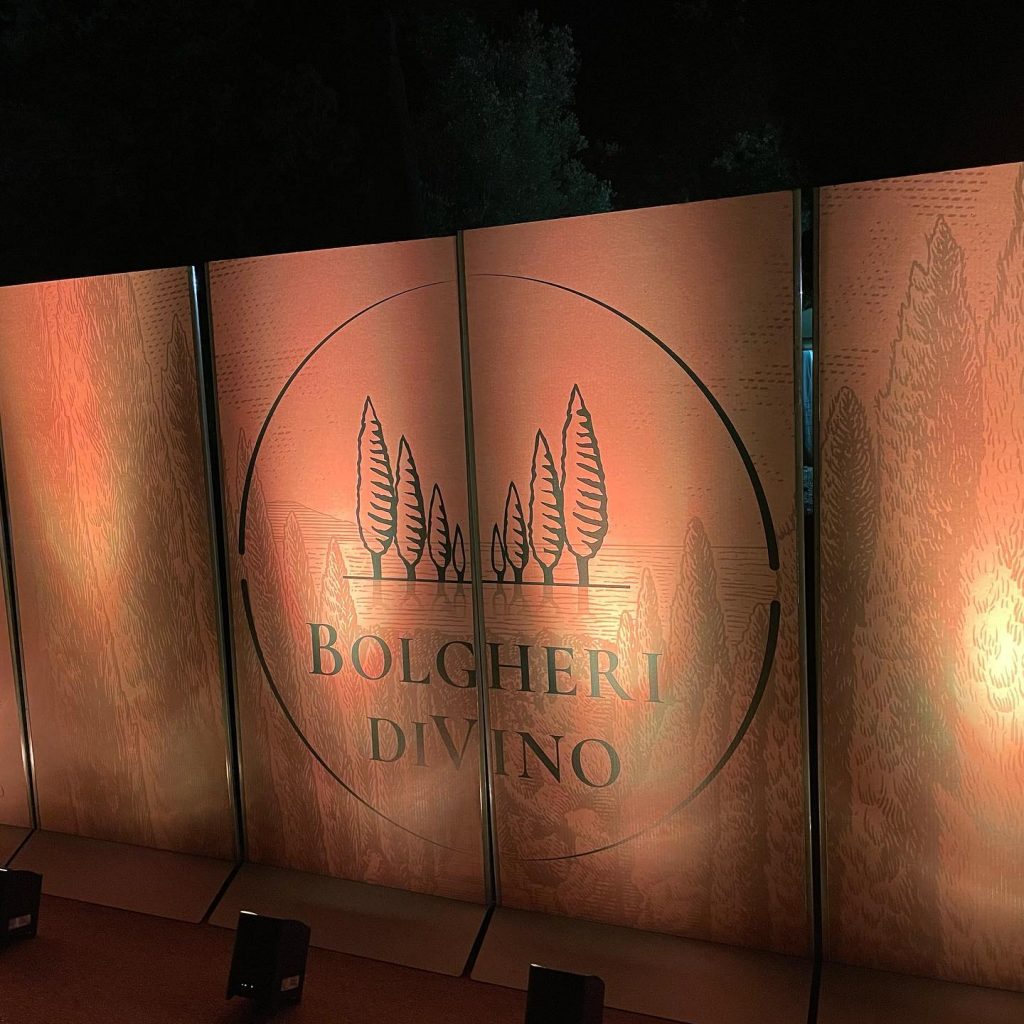


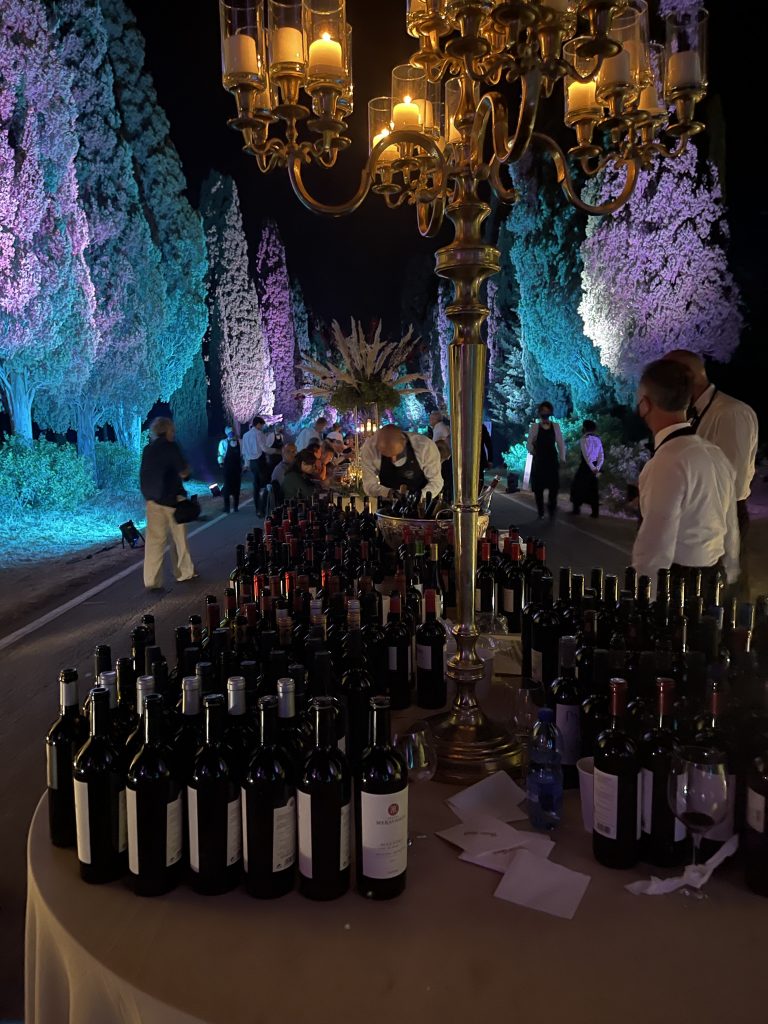
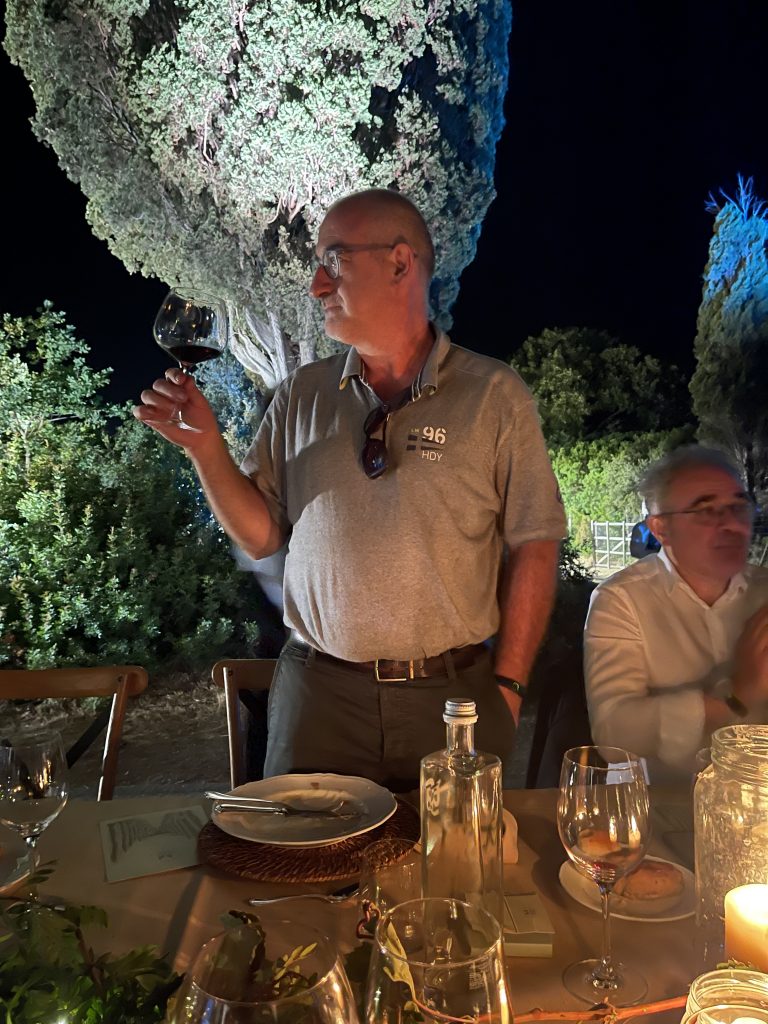
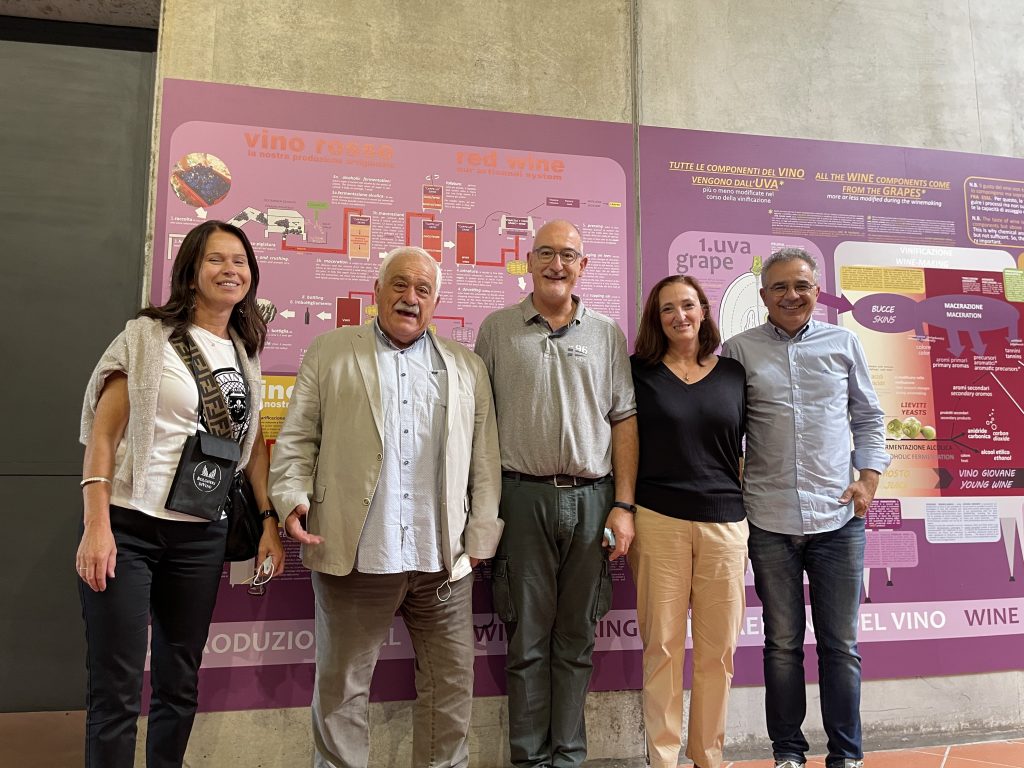
Fall opening hours
The harvest is coming, the days start to shorten and we start our fall opening hours.
Till the end of October, we'll be open from Monday to Saturday, h. 10.00-13.00 15.00-18.00.
We are waiting for you!
Our Rute, first on the best wine list of Bolgheri according to Gambero Rosso
I am pleased to discover that the August issue of Gambero Rosso dedicates a long article to the cuisine and wines of our Livorno coast. And who stands out? Our Rute Bolgheri DOC Rosso, of course. Thanks a lot to the editors.
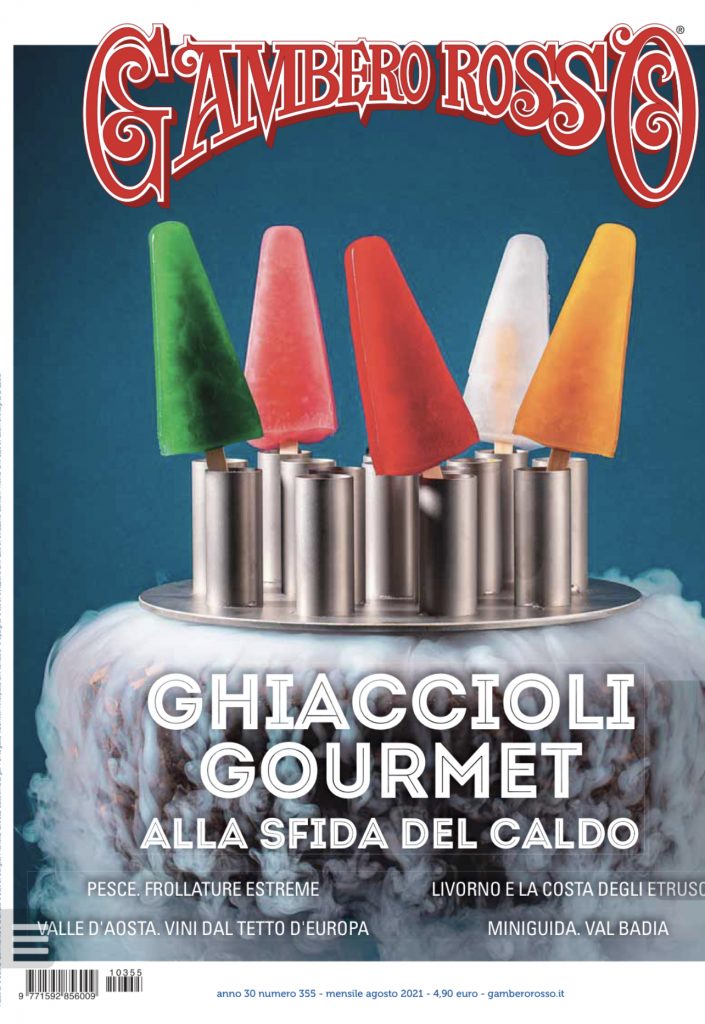

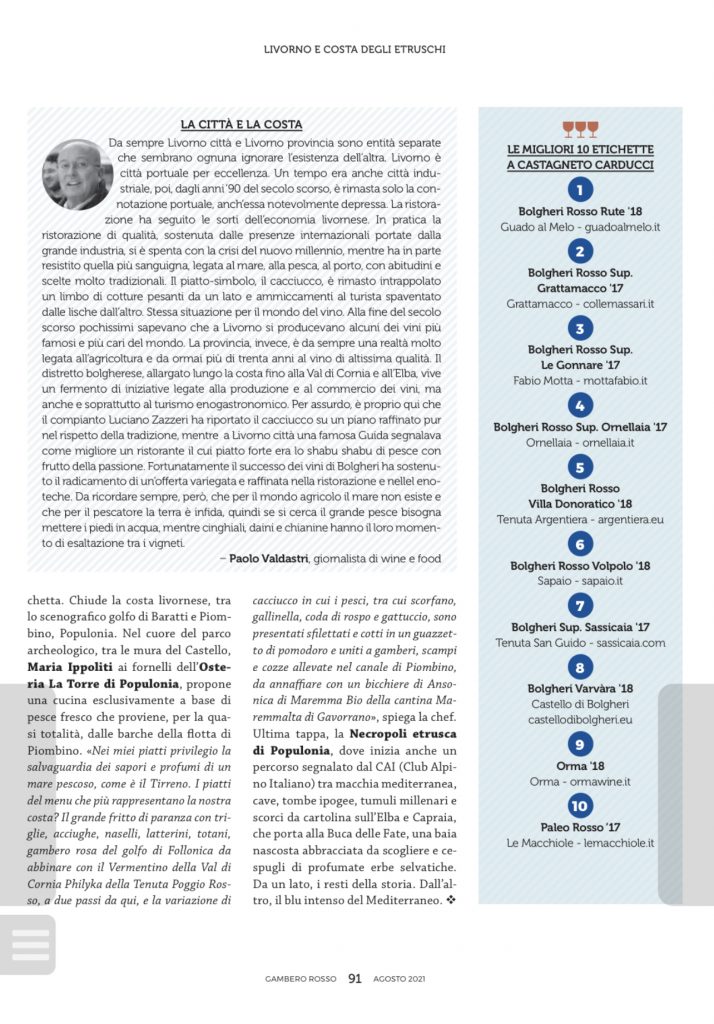
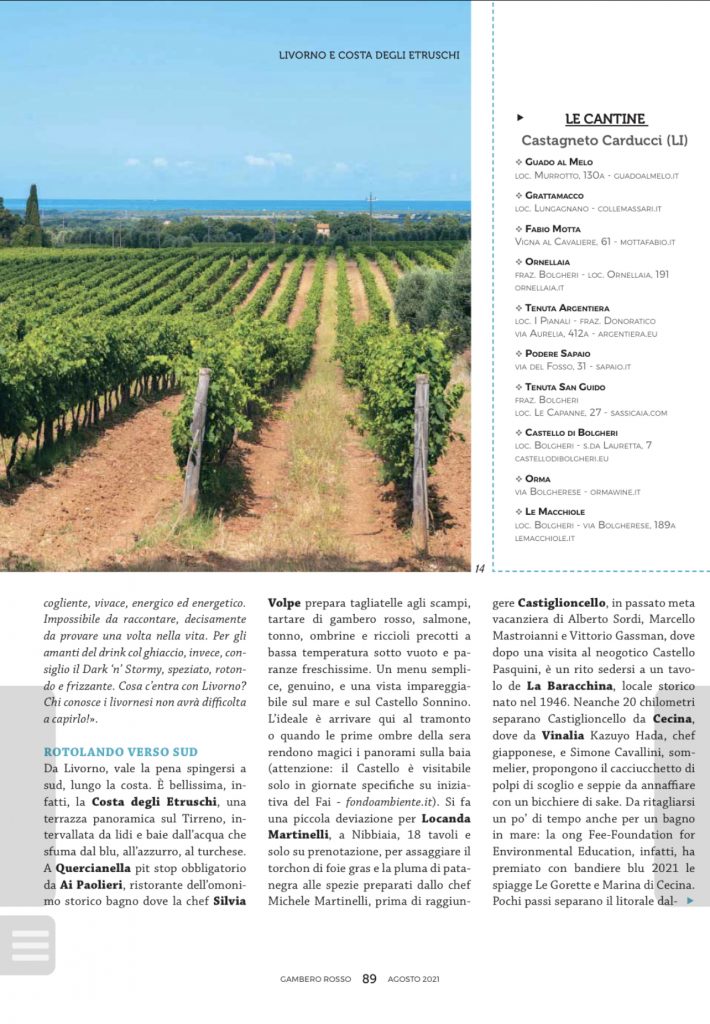
Roots, the underground life of the grapevine (2)
Continued from here
"Leave the flowers to others, still too far away. Your thought remains with the seeds and with the firm grip of the roots …" (Margherita Guidacci, "To myself")
We keep talking about roots. Let's see their functions and the influences that agricultural practices have on their development.
My main source is “Vine roots” by South African professors E. Archer and D. Saayman (2018, The Institute for Grape and Wine Sciences, Stellenbosch University), as well as several illustrations. This is an excellent overview. The University of Stellenbosch is considered to be the world’s most qualified center on wine-growing soil studies.
Water and water stress
The roots mainly influence the production of the vine on the basis of their ability to ensure water. They have evolved to survive in an environment at the limit for it. So, if well managed, they can be of great help to overcome the difficulties related to the climate change.
The vine does not need a lot of water, indeed it is established that it produces grapes of higher quality when it is a little stressed, not with the maximum of its vigor. However, the stress must not be more than necessary, otherwise the quality of the grapes undergoes and, therefore, of the wine. Especially at certain times of its cycle, the plant must have the water it needs on a regular basis. Conversely, the vine does not like excess water and the roots avoid stagnation areas if possible. They approach the aquifer and absorbs the water that rises above it by capillarity. The water table recedes during the late spring and early summer. The roots, which are in a phase of active growth, follow it (if they do not find obstacles).
Water absorption occurs mainly thanks to the thinnest roots, which is why their optimal development is important. It was once thought that the woody ones (with the bark) were completely excluded from this function. However, they also play a role, especially when the vine awakens and the subtle roots are very few (as we have already seen). The lignified roots can absorb water from the frequent breaks or cracks that form in the bark to allow lateral roots to emerge. However, they have a much lower absorption capacity than non-lignified ones (minus 40-70%).
The absorption and transport of water occurs in the plant mainly thank a sort of "suction" force that is created due to the water loss by leaf transpiration. The water molecules are strongly cohesive with each other and pressed in the thin tubes of the xylem (this is why we speak of capillarity): they thus form a kind of train, made up of many wagons linked together, which are dragged upwards.
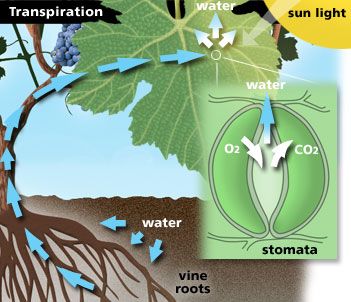
In the early spring, however, the leaves are not there yet. In this phase, the water thrust comes from the roots. When the soil begins to warm up, the roots resume metabolic activity and an osmotic potential is created, that causes water absorbation. That generates a pressure in the roots that pushes the water upwards. The roots are capable of very strong pressure: it has been calculated that they could carry water up to a height of 35 meters. When there'll be enough transpiring leaves, they'll become predominant in leading the process.


How does the plant regulate the flow of water? The vine, following a water stress, brings into play a whole series of changes that are driven by hormones, mostly produced by the roots, which we will see later. Among the different responses, there is the limitation of transpiration with the closure of the stomata, the stimulation of the root growth, the inhibition of the growth of the shoots, the production of proteins that prevent the cell membranes from drying out, etc.
In general, the grapevine has a great ability to resist drought, more than many other plants. It depends on its ability to form, if necessary, very long roots that are able to explore the soil and reach the water. This ability is essential in Mediterranean climates where summer is arid but, if the soil characteristics allows it, the roots can reach the deepest or most distant humid areas.
In a drought climate, however, there are other problems for plants. If part of the roots cannot find water, it may dry out and die. Also, imagine a straw where you suck too hard: the walls could crush, blocking any other transport. The great ability of the vine to resist water stresses also depends on its particular resistance to the contraction of the xylem vessels. However, this also happens because the vine is not a simple suction straw. Water does not enter only by physical forces, but, as mentioned, the plants control and regulate the flow. Moreover, compared to other plants, the vine has a not so thin xylem system. For this reason, the grapevine has a low hydraulic resistance: the "suction" is never too strong (except in really extreme conditions). For the same reason, the roots that remain without water do not die: there is a quickly redistribution to them of the available water. This phenomenon is called hydraulic conductivity of the roots.
However, in very extreme conditions, even the vines can have problem. If the aspiration become too intense, some air bubbles may form in the vessels (embolism) which interrupt the water column and hinder the transport.
Mineral salts
In addition to water, the roots also absorb mineral salts. They are essential for the nutrition of the vine, to support all its vital functions. Some, such as phosphorus and nitrogen, are indispensable for stimulating the growth and branching of the roots.
The grapevine has the reputation of being able to live in very poor soils, due to its ability to use the minimum presence of minerals and to "go and look for them". The roots, in fact, have a strong chemotropism: they develop in the direction of where they find the nutrients. For this reason, it is important that there is not too intense fertilization, especially in the first years of the vineyard, otherwise the roots would be induced to develop only in the fertilized areas.
The roots of the vine also have the ability to avoid, up to a certain point, intoxication due to excesses of some substances, such as sodium or metals (as aluminum or copper). Their transport is blocked in the roots and they are stored.
The absorption of mineral elements occurs mainly in the thinnest roots. Some, such as potassium, can migrate centimeters, nitrogen even over 10 cm. Some elements instead (such as boron, phosphorus and calcium) must be in the immediate vicinity of the root to be absorbed, a few millimeters away. In these cases, the help of the subtle hyphae of the mycorrhizae can be useful.
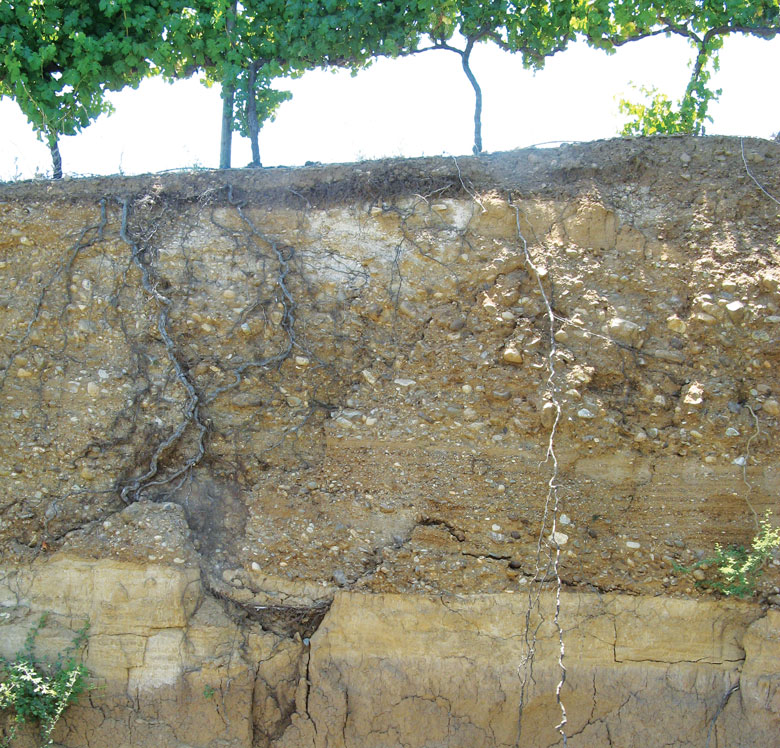
The absorption of the mineral elements of the soil, as well as for water, can take place both passively and actively. Mineral salts are absorbed in the form of cations and anions. As for water, the passage into the endodermis is only active, after neutralizing the charges. The ions are bound to transport molecules, which accompany them in the passage through cell membranes and then in the xylem flow.
The absorption of mineral salts is not continuous. Understanding their cycles is essential to understand the moments of real need for the vine. For example, one of the most important elements is nitrogen, the absorption of which has peaks and periods of stasis throughout the year. From awakening to the end of the rapid growth phase of the shoots, the plant seems to depend above all on the nitrogen accumulated the previous year. The vine begins to accumulate nitrogen again after the flowering until the veraison. From the veraison to the harvest, the absorption stops and the bunches are replenished above all by that accumulated up to that moment. After the harvest, the root absorption begins again: that is an important moment to restore stocks, in view of the future budding. The roots continue to accumulate nitrogen until the leaves fall.
For iron uptake, one of the most difficult times for the plant is that of the pre-flowering phase, , when it can show symptoms of deficiency. This happens because the iron is mainly absorbed by the tips of the thinnest roots which, at this stage, may still not be sufficient in the cooler climates.
However, there is a huge difference between the different rootstocks in the ability to absorb the different mineral elements from the soil solution, making them more or less sensitive to certain deficiency problems.
Storage of reserves
The vine not only accumulates nitrogen but also other reserves to support particularly difficult phases of its life. The stocks are made up of mineral salts, sugars and other substances (amino acids, citric acid, etc.). The sugars are produced by the photosynthesis and are stored in a storable form, the starch. When it is needed, some enzymes are activated that break down the starch into sugars (especially sucrose, as well as glucose and fructose). All the woody parts of the plant can act as storage sites for the reserves, but 80% of the starch and 70% of the nitrogen are in the roots, the rest in the trunk. Potassium, for example, is higher in the trunk.
The spring awakening of the vine is totally dependent on these reserves. It cannot be otherwise: at this stage, the leaves (that produce sugars with photosynthesis) are not yet there and the thinnest roots, the most absorbent ones, have not yet developed. The reserves remain important throughout the growth phase of the shoots. Then, they are partially restored, and consumed to support the growth of the bunches. Finally, they are strongly restored after the harvest, to guarantee the possibility for the plant to start a new cycle the following spring.
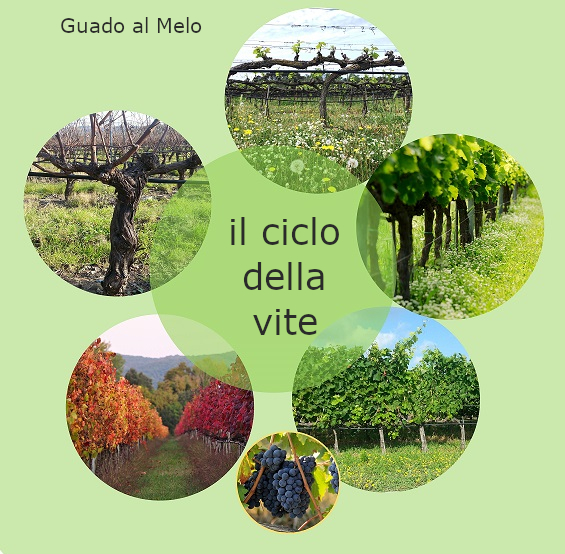
After the harvest, you might think that the vine will go into dormancy and therefore don't need much. On the contrary, it is working hard to accumulate stocks. Therefore, it is essential that the vine has the correct availability of nutrients, particularly nitrogen and potassium, and that it can continue to do photosynthesis as long as it can. Several studies have shown that vines that have accumulated low reserves in the fall will produce a limited number of shoots at the time of budding and will have poor shoot growth. The autumn accumulation can be altered by environmental stresses such as excessive drought, excess water, soil depletion, … This is why it is said that one vintage affect its production but also (partly) the next. Bad cultivation practices can also have a negative effect, such as too early pruning (done before the natural fall of the leaves), poor soil management, lack of fertilization, etc.
The production of hormones
Another very important function of the roots is the production of most of the hormones, chemical messengers that modulate the reaction of the vine to its environment. Let us therefore remember that any negative condition that prevents the growth and function of the roots, interferes with the synthesis of hormones, thus modifying the general performance of the plant.
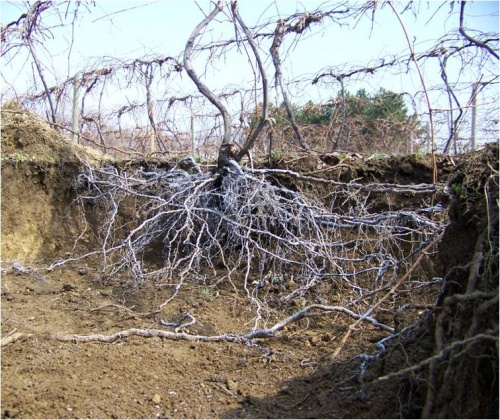
The main plant hormones are a group of molecules that are divided into 5 families: auxins, gibberellic acids or gibberellins, cytokinins, abscisic acids (ABA) and ethylene. The first three are mainly related to plant growth stimuli, the last two mainly to the aging and ripening of the fruit. ABA is among the most important for the response to water stress, with the regulation of the closure of the stomata. These hormones never act alone, but always in relation to one another. All the processes of growth, development and maturation of the vine are the result of the variable ratios of these hormones. That creates the possibility of a very fine and differentiated regulation.
The production of hormones depends on the stimuli of the external environment, both natural and those caused by the winemakers (pruning or topping, for example). The least expected aspect is that the most important stimuli do not come so much from the surface environment but often from that of the soil, that is, those that act on the roots: water stagnation, dryness, salinity, nutritional deficiencies, damage to roots due to toxicity phenomena for various substances, parasites, root cutting, etc.
It is not a hormone, but the roots of the vines are also the main area of production and accumulation of the citric acid. It is transported from here to the fruits, where it is oxidized to malic acid.
The influence of the agricultural practices
I have already talked about different practices in the course of the description of the roots, but here I add others that have a strong influence on the development of the roots.
A central moment, but often overlooked, is that of the birth of the vineyard. Numerous studies have shown that mistakes made in this phase, in relation to the root system, compromise the entire future life of the vineyard, both in the quality of production and in its longevity. The planting of the vineyard is fundamental: you have only one chance to do it well, afterwards it is impossible to change. First of all, of course, there is the choice of where to make the vineyard, in relation to what has been explained so far on the importance of the soil characteristics. Therefore, it is essential to know your soil well with well-done geological analyzes, in order to understand its viticultural potential, guide the choices of planting and of the future management. Another essential step is the preparation of the soil. This preparatory work affects the actual depth of the soil. It has been seen that an absent or shallow preparation in any case limits the root growth to the most superficial layers and there can never be sufficient root colonization.

Numerous studies have also shown that the way in which vines are planted also affects the root growth and its distribution throughout the life of the vineyard. If the digging system compacts the earth too much on the sides and bottom, it create like a small cage from which the roots will no longer be able to get out. The root reduction is also reflected in a weak growth of the rest of the plant. The depth of the excavation is also relevant: if shallow, the vine often dies from drying out; if too deep, downward root growth is inhibited. It is also better to make attention to too small holes, excessive cuts of the roots, to the distribution of roots in the digging hole, etc.

It has been seen that there is a decrease in the root mass for each vine with the increase in planting density (as we can expect). However, it has been seen that there is also an increase in the density of the roots, especially in the deeper profiles of the soil, with a better use of the available volume. However, by increasing the density too much, this positive effect stops, with a reduction in vigor that affect the quality of the grapes. Furthermore, with too high planting density, the soil resources can be consumed too quickly before the end of the growing season, especially in a dry and poor soil. Therefore, the choice of plant density should be determined by the potential of the soil to induce vegetative growth. Let us remember that it is a slight stress that gives better grapes. Too much stress produces poor grapes (and wine).
Once the plantation is done, it is important to keep the soil at its best to have optimal roots. Over time, the soil tends to compact and impoverish. For example, it has been seen that the frequent passage of the tractors in the vineyard can create a hard layer that reaches even 60 cm in depth.
The choice of the soil cultivation (how often, how deep and where) is linked to each specific situation. However, it has a destructive action on the roots of the worked layer. The utility of the root pruning is discussed. If done badly, too deep or too frequent, it has an inevitable limiting effect on the plant growth. If done lightly, it causes a slight stress on the vine which can increase grape quality. A light stress also seems to push the roots to colonize hitherto unexplored parts of the soil. In general, compared to the past, today most of winemakers avoid deep and continuous cultivation, which in any case affect too much the root system.
The roots that are most affected by the work of the winemaker are the superficial ones, also known as interception roots, which usually lie between 7,5 and 25 cm of soil. Numerous studies have shown how different soil management affects them in different ways. The most superficial roots remain in a soil managed with herbicides or mulch, while they are absent whit soil cultivation or with grassing (for a competitive effect). They can decrease in any case with the bare soil, because it is more subject to temperature fluctuations and excessive dryness. However, the different managements of the soil have consequences on the roots that can become advantages or disadvantages depending on the specific soil and climatic situation. If we do not know specifically our soil characteristics, we cannot choose the best management for our vineyards. For example, the grassing limits the vine's roots in the most superficial layers of the soil, but it can positively stimulate the exploration of the deeper ones. However, this is only an advantage if the soil is really deep, and if the layers are suitable for the roots.
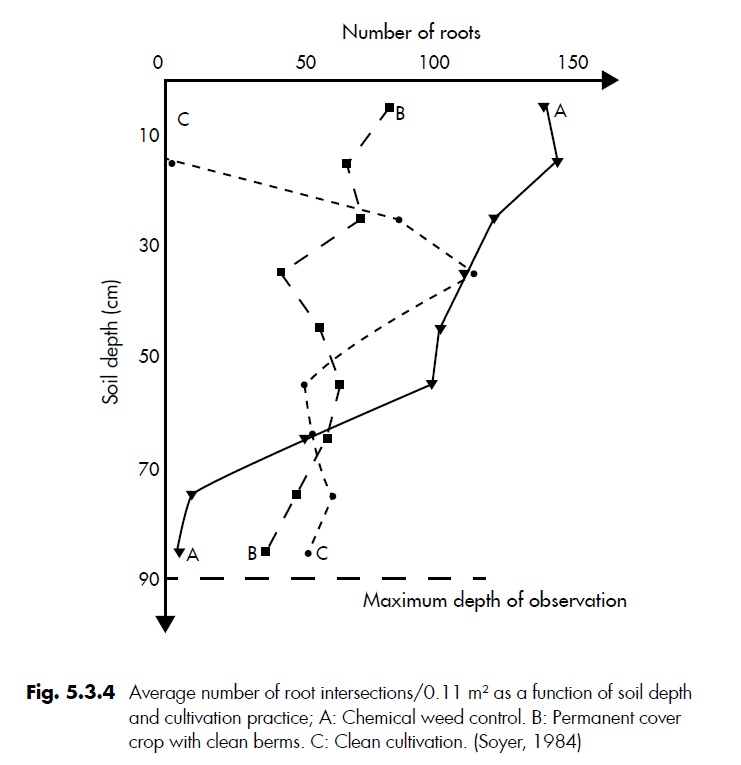
Also fertilization has an important effect on the root system. It has been found that the best effect on root growth comes from composting with vegetable waste, such as shredded shoots from pruning. These also create a layer of mulch which makes the soil temperature more stable and avoids excessive surface dryness, as well as a natural herbicide effect. Instead, the constant use of manure has been demonstrated to depress root growth. It appears to have an excessive salinizing effect on the soil and, in the long run, also causes nitrate poisoning. However, it has the faster effect on the growth of the shoots, significantly increasing their vigor. Furthermore, it should be remembered that the vine does not feed on organic material but on inorganic salts. Sufficient mineralization for vine's demands is not so obvious. So, the inorganic fertilization should not be neglected when necessary.
The research on irrigation is much more present in the countries of the new world than in the old. Since the roots are strongly guided by water in their growth, it has been seen that the implementation and management of the irrigation system has a very strong effect on their development. For example, irrigation plants that are focused and superficial, such as the drip one, tend to limit the development of roots enormously, especially if used in the first years of the vineyards. In this case, the roots concentrate in the small part of the soil where they find water and become dependent on irrigation forever, even when it would be not needed. The irrigation plants, if needed, should be realized in such a way as to favor optimal root development.
Also the other works in the vineyard have an effect on the roots, even if the studies are not numerous. For example, studies on the relationship between pruning and the root system have given quite conflicting results. It seems that the growth of the root system is more stimulated with medium pruning. Negative effects were found with too severe pruning or, vice versa, with too much buds. The defoliation seems to have benefits on root growth and the development of thin roots in particular. However, it must be well calibrated for the climatic situation. If done too early or too intensely, the density of the roots decreases.
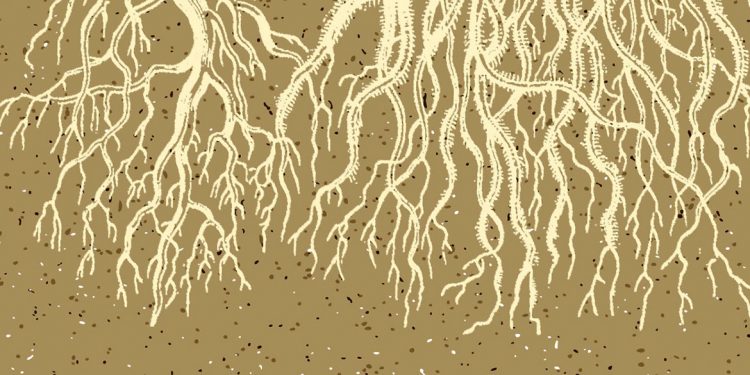
I hope you have understood the centrality of the roots and therefore of how their care should be privileged, starting from the creation of the vineyard. The vine is able to withstand environmental stresses, as well as producing high quality wines, only if it manages to develop an optimal root system. So, it is important to know all the aspects that influence the development and growth of roots in our vineyards: soil, climate, the influence of each agricultural practice, …
Winemakers who love their vineyards don't stop at the surface.
Roots, the underground life of the grapevine (1)
Normally we are used to considering a plant above all from what we see: branches, flowers and fruits. Yet, plants do not live like us only on the earth's surface. They occupy two very different environments at the same time: the overground and the underground.
Maybe you are surprised but for the plants, for the balance and interchange with one's environment, the under is almost more important than the top. Attilio (prof. Attilio Scienza) uses to say that the roots are the "brain" of the vines. Of course, they are completely different, but it is a useful metaphor to understand their very important function.
... Wanna live underground ... as a great legend, David Bowie, sang in a film of my adolescence (Labirinth).
However, it is not easy to study the roots in their underground world. It is not easy to reach them and subject them to tests, managing to keep them intact in all their subtlest ramifications or without upsetting local balances. For this reason, there are not many studies on them or, at least, not as many as they do on the aerial parts. So, there are still many open questions which will require further research, but we have learned something and here I am giving you a brief overview.
As we all know, the roots of the vine serve for the absorption of water and nutrients (the mineral salts of the soil). However, they are also essential for the balance and general well-being of the plant organism because they are mainly responsible of its ability to resist stress.
Animals can react to any environmental stress simply by moving around, as well as looking for food. Plants (as a rule) do not move and have therefore developed enormous adaptability and resistance to the stresses they can undergo during their sedentary life. Their reaction is essentially based on changing the way, speed and direction in which they grow. The signals are not transmitted by the electrical impulses of a neural network, as for animals, but are chemical. We are talking about hormones, that is substances that move around the plant, carrying with them a message to be transmitted. It is the roots that produce a large part of these hormones, which regulate the growth and physiological responses of the entire plant to the external environment.
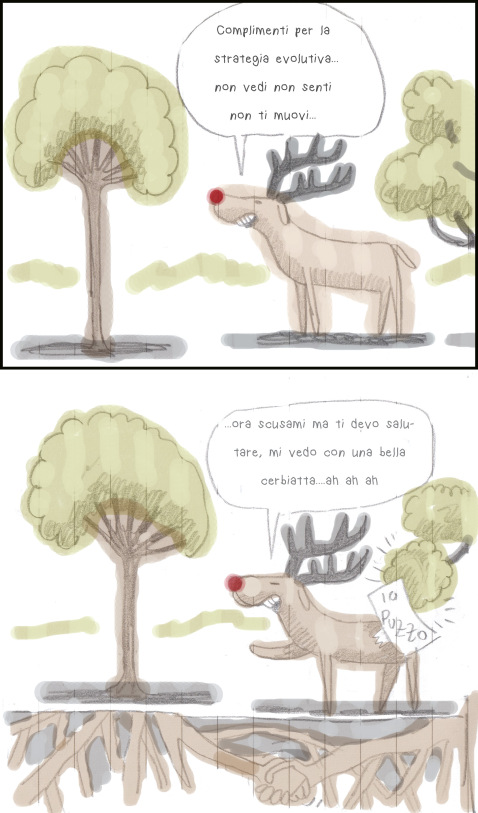
The natural environment of the vine is the Mediterranean one, which can also be very limiting. Since it is an arid or semi-arid climate, it has important limits related to the availability of water. In addition, frequently, it has low organic matter content in the soil. There may also be accumulations of limestone, salt, etc. The roots of the vine have evolved to survive in this difficult environment. They are able to respond well to water stress, to nutritional deficiencies, as well as to survive complex situations. This happens thanks to their ability to expand and renew themselves continuously, to store reserve substances, to enter into symbiosis with other inhabitants of the earth.
According to scholars, the knowledge and the optimal care of the root system is therefore one of the most important issues for the quality of wine. Furthermore, since the vine's response to stress lies in the roots, this knowledge can offer us great opportunities for optimizing viticulture in relation to climate change. So, let's see the reason for this importance and how it reflects on the work choices in the vineyard.
As this is a popular article, I have neglected the bibliographic references in the text. However, for those wishing to learn more, my main source is “Vine roots” by South African professors E. Archer and D. Saayman (2018, The Institute for Grape and Wine Sciences, Stellenbosch University), as well as several illustrations. This is an excellent overview. The University of Stellenbosch is considered to be the world's most qualified center on wine-growing soil studies.
Root structure
Without going into too much detail, I give you some general information.
A vine root is externally wrapped in a protective layer, a more or less thick epidermis which, in the larger and structural roots, is lignified (the cortex). The central part, wrapped in a second protective tissue (the endodermis) includes the most delicate tissues, including those with growth capacity (the pericycle) and which are responsible for transport in the plants, xylem and phloem. The xylem brings what comes from the roots to the whole plant: the water, the nutrients, the substances they produce (hormones and others). It is made of hollow tubes and the transport takes place by capillary flow, mainly driven by the leaf transpiration. The phloem mainly has a reverse path: it carries the products of photosynthesis from the leaves to the rest of the plant. It is made up of living cells, which actively move these products through them. These essential parts can be structured differently according to the different types of roots, depending on their role, the genetics of each rootstock, …

In fact, the are different types of roots. Those called primary, or even structural or tap root, are the thickest (6-10 mm). They are lignified and have the role of anchoring the plant to the ground. In addition, they are an important crossroads for the transport of nutrients and water. Finally, they are storage centers of the plant's reserves. The secondary roots are the thinnest ones (2-6mm). They stretch both laterally and in depth. The more superficial ones are very important especially for the absorption of mineral nutrients, which are mainly found in the upper layers of the soil. They are also useful for absorbing water, intercepting it before it flows away or goes down. The depthest are instead essential to resist water stress. Further branches start from these roots, the fibrous or absorbent roots. These live for just one season and are continually renewed. They are the most extreme offshoot of the plant, the main ones responsible for the absorption of nutrients and water. The contact surface with the soil is even more extended by the root hairs, as well as by the hyphae of the fungi in symbiosis with the roots.
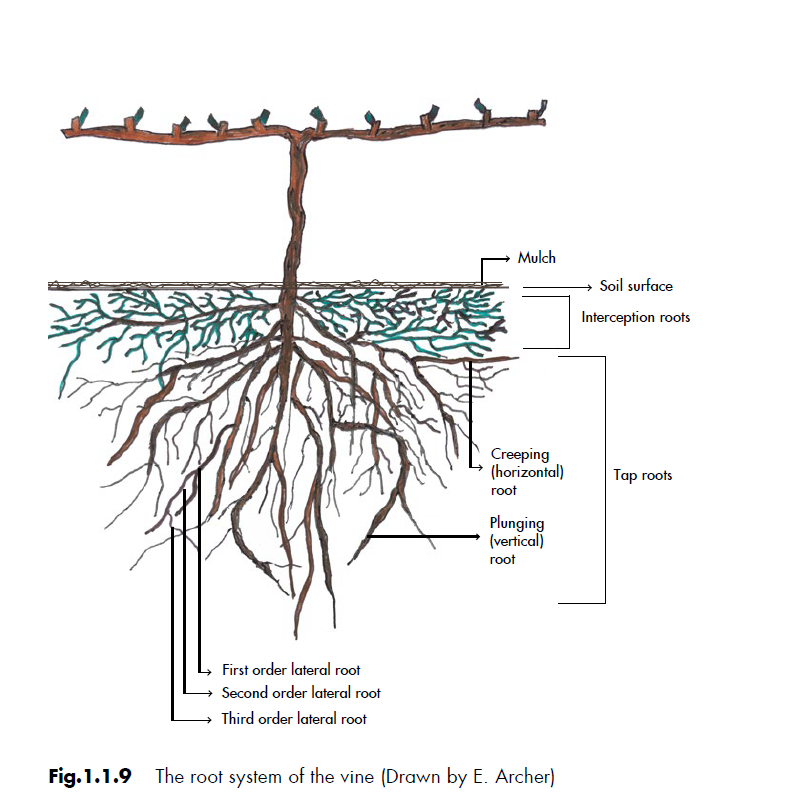
People often talk about the lenghts of the roots of the vine. However, the exchange capacity with the soil depends above all on their branching and, therefore, on the soil space they manage to occupy in density. The more the vine is in favorable soil conditions, the more it tends to branch and the more it optimizes its exchange capacity. It is possible to have 200 meters of root for every cubic meter of soil (about 1.0-1.5 kg of roots per cubic meter). Conversely, in the most unfavorable conditions, the roots are inhibited both in elongation and in branching. In this case, there is a wider mesh and the plant has less vigor. If the root density and distribution are very limited, an imbalance is created between the vegetative growth and the grape production which leads to poor grapes and wines of lower quality, especially in the driest years.

Thicker roots don't die easily. Instead, the finer roots die continuously and are replaced within a few weeks. This continuous restoration, together with the abrasion that the outermost tissue of the living roots undergoes, consistently enriches the soil with organic matter. Champagnol (1984) quantified this contribution up to 8 tons per hectare per year, for the entire life of the vineyard.
The relationship with mycorrhizae and other inhabitants of the rhizosphere
The roots are not isolated but "communicate" with their environment and the other inhabitants of the soil. They produce a mucus towards the outside, a gelatinous substance that has many functions, not all of which have been clarified, including that of limiting damage from abrasion by soil particles. This gel contains carbohydrates, amino acids, organic acids, enzymes and other compounds. Some of these substances are used as food by a wide range of organisms living in the soil. It has been seen that some also have a stimulating or vice versa blocking action on the growth of fungi, bacteria or nematodes. Furthermore, as already mentioned, the roots also annually produce a large mass of organic material, which is an ideal humus for various organisms of the rhizosphere.
One of the best known relationships that the vine establishes with other soil organisms is that with mycorrhizae. The name means "root fungus". They are in fact fungi that live in symbiosis with the roots of different plants, some outside and others also inside the root tissues. They are in symbiosis, that is, there is a reciprocal and not harmful exchange between the two organisms. Fungi mainly take the carbohydrates produced by the plant, while helping the vine in the absorption of water and nutrients from the soil. The mycorrhizae can consume up to 4-20% of the photosynthetic production of the plant. At first they have a negative effect, until an optimal balance is established.

The fungus optimizes the absorption of the plant because its hyphae are long (20 mm hips) and much thinner than the roots, which are up to 500 or 1000 times thicker. They are therefore able to penetrate the pores between the soil particles where the roots cannot reach. Their presence increases the absorption capacity for the plant of water and of some mineral elements (such as phosphates or iron). They have also been seen that they can increase the plant resistance to salinity, to heavy metals such as copper, as well as the resistance to some diseases and other adversities. Their action is also hypothesized in the hormonal regulation of the vine, but these aspects are still being studied. However, the root colonization by these fungi does not always occur: it is conditioned by numerous factors, above all by the characteristics of the soil. Their presence, for example, changes with the pH: they decrease in more acidic soils. They are absent in very dry, saline or stagnant soils, with too high or, conversely, too low fertility.
On the basis of these studies, there are those who propose the artificial inoculation of mycorrhizae in the soils of the vineyards. According to experts, this practice is of little use. It has in fact been seen that if the soil conditions are adequate, the mycorrhizae colonize the vines very easily in a natural way. If the soil conditions are unfavorable, the inoculated mycorrhizae would die anyway. The presence of these fungi is therefore an intrinsic advantage of the best soils for viticulture. We can try to optimize it with adequate soil care and agroecological practices (see here), but only if the conditions are favorable to their presence.
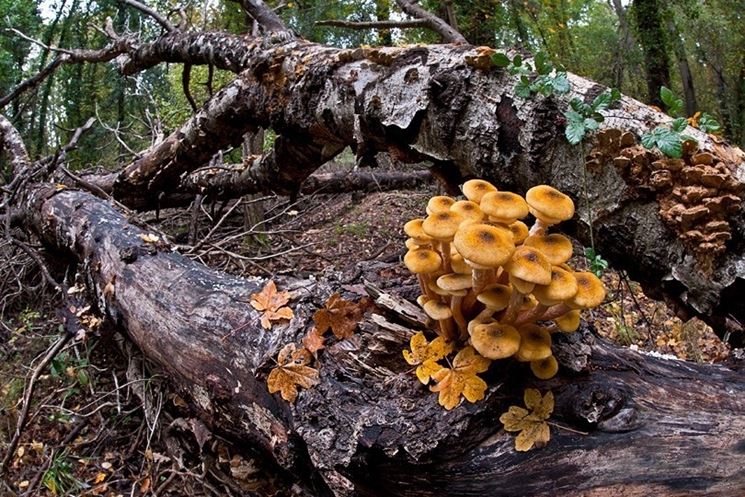
In the soil there are also organisms that can attack roots with dramatic effects. Some are better known, others less, again due to the intrinsic difficulty of studying the soil life. Beyond the well-known phylloxera (defeated in the past thanks to the use of resistant rootstocks), there are also other insects (beetles, nematodes, hemiptera larvae) which, directly or as virus vectors, can cause the weakening of the vines , sometimes until the plant dies. There are also numerous fungi that cause root rot, such as some species of the genera Phytophthora, Pythium, Armillaria, etc. It seems that even the infamous esca disease, which causes the death of many vines in the vineyards, is linked to soil fungi. Unfortunately, as experience has already taught us with the phylloxera, while it is relatively simple to study and combat a pathogen that attacks the aerial part of the vine, it becomes much more complicated if it happens in the soil. Our best answers, for now, come from the prevention of the spread of infections with controls in the nurseries, in the search for genetic resistance and in the care of the vineyard soil.
Where the roots develop
The winemakers often tell, poetically, that the roots descend into the depths of the earth even for tens of meters. This is partly true: the vine is one of the woody plants whose roots go deeper, but it is also true that there are hardly such deep soils (underneath there is the bedrock, impenetrable by the roots).
In any case, it has been seen that the roots tend to develop and occupy mainly the soil spaces where they find the best conditions in relation to water, temperature and air. On average, without other limitations, they prefer humid but not stagnant areas (where they would die of asphyxiation), warm and airy.
The direction of root growth is driven by two main forces: the search for water (hydrotropism) and mineral nutrients (chemotropism). The more superficial the aquifer is, the more the roots will stay on the surface. The root of the vine senses the depth at which it is located and changes its preferential direction of growth. It has been seen that the more superficial roots tend to grow downwards. Those deeper, if they can, prefer to expand laterally, because they do not like the deeper asphyxiating layers. The more deeper roots, if they can, tend to grow upward. Over time and the appropriate conditions are in place, all the roots tend to stabilize at the same optimal level, which can be variable but still relatively close to the surface: it is not too superficial (due to the risk of drying), it is not too deep (due to the risk of asphyxiation).
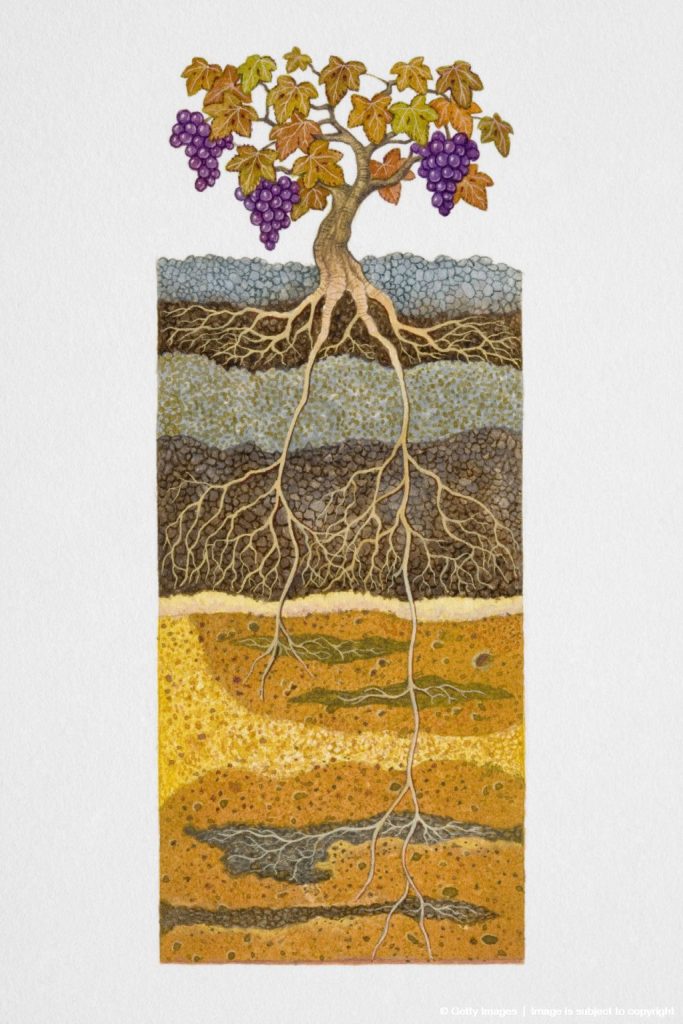
The element that most conditions the natural propensity for growth of the vine root is the physical structure of the soil. The differences in the soils considerably affect the ability to form an optimal root system, with important and proven effects on plant growth and on the characteristics of grapes and wine. Above all, they greatly affect the plant's need to have enough water available during growth times.
The depth of the soil is one of the most important elements in viticulture, because it guarantees the full development of the root system. The shallow soils are limiting: the root can expand little, it may not be able to reach groundwater or areas rich in minerals. The other key element is its softness. The more compact the soil, the more growth slows and the branching of the root is reduced, until it can become a real impenetrable barrier. The roots only advance if the pore size is adequate or if there are cracks or other pathways. For example, they grow well in spaces left by previous dead roots, in passages dug by the earthworms, etc. Instead, they block when they encounter hard layers, such as compact clayey areas or iron concretions. When they encounter an unfavorable area, they tend to branch out on and around it. The texture of the soil changes the penetration capacity and root density. The sandy soils on average determine a greater elongation but lower root density. A medium texture (silty), decreases the penetration but determines a greater density. The fine soils (clayey), on the other hand, reduce the penetration even more, while the density does not vary that much. Each of these characteristics may or may not be an advantage depending on your environment, the availability of water or the grapevines varieties. In a heterogeneous soil, the roots will be distributed differently depending on the nature of the layers, more or less favorable to root expansion.
The chemistry of the soil, on the other hand, seems a little less important, if not for a different sensitivity to the pH that the different rootstocks show. Below 5 is a bit limiting for everyone. The number of fine roots is positively influenced by the fertility of the soil, even if the vine has an accentuated chemotropism, so it can grow well even in poor soils.
Soil is the most decisive element. The genetics of the rootstock seems to affect mainly the root density. The rootstocks most resistant to drought are those that have the greatest density and distribution of roots. Those with smaller and thinner roots are instead the most exposed to the risk of drought.
Therefore, in a Mediterranean climate, with deep soil, the main mass of the roots is concentrated on average in the range between 25 and 55 cm in depth. This area can vary in relation to several factors. The climate, for example, is important: where it is cooler they tend to stay a little more on the surface, deeper where it is warmer.
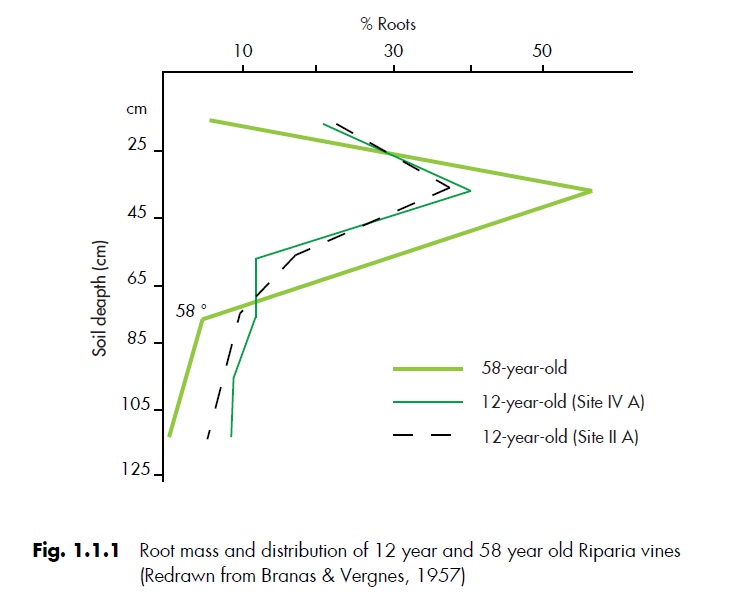
The most superficial part of the soil, above 25 cm, generally has fewer roots for several reasons. This is an area that can be too dry. In addition, in this band the work of the winemakers insist, which has a destructive effect. In addition, they also suffer competition with any cover vegetable species.
The deeper layers are also the least interested by the root mass. It is true that the roots can go down to great depths, if the soil is deep enough or leaves passage spaces. In this capacity lies the great resistance to water stress of the vine. However, we are talking about a minority part, because they are situations in any case at the limit as the roots are sensitive to the lack of air (under 10%, they die in a short time). There is, however, a different ability of rootstocks to resist radical asphyxiation.
To search for water, the roots preferably expand laterally, if they can, even for several meters. They also freely overlap with those of the neighboring vines, even if 80% is concentrated in the space of the single plant. The overlapping, however, has the effect of decreasing the vigor, as can be easily seen from the fact that the first grapevines of the row are always the most vigorous.
How the roots grow in the different stages of the plant's life and throughout the year
The roots grow more or less in relation to environmental conditions, the age of the plants and the activity of the canopy (the part of the leaves).
When the vine is young, the roots develop a lot and branch proportionally to the development of the canopy (if this is not pruned). This phase, which lasts about 7-8 years, is very important because it is the one of maximum elasticity. In this period the roots of the vines adapt to the local climate and soil conditions. After this stage, they will not be able to change their adaptation. In adulthood, the average elongation is increasingly scarce: the size of the root tends to stabilize, as does the vigor of the canopy. During the aging phase, the vine reaches its maximum complexity, but the plants can also suffer from the damage caused over the years by parasites and other adversities. The studies shown in the diagram above, which compared adult (12 years) and very old (50 years) vines, show that the old vine has a larger root mass, but is located more or less in the same area as that adult. However, the deeper roots are reduced. It seems that the strength of an old vine can be compromised more by damage to the trunk and the aerial part than to the roots themselves, which are generally very resistant.
Every year, more or less rapidly depending on the age, the roots grow and, above all, renew the thinner and more absorbent parts. This growth does not happen all the time, but at particular moments. It has been seen that root growth occurs when the plant has an excellent availability of the products of photosynthesis. This growth does not start immediately with budding, but after a few weeks. For colder climates, it can start even 10 weeks later. After that, there are peaks and slowdowns that vary with the climate. Broadly speaking, two main behaviors have been identified:
- in the warmer regions, in the Mediterranean ones and especially in the southern hemisphere, there are two peaks, one during flowering, when the growth of buds slows down, and a second smaller after the harvest.
- in regions with a more moderate climate, growth is slower and more continuous and reaches a peak in late summer or at harvest. If the leaves remain active after the harvest, the growth continues for several weeks.
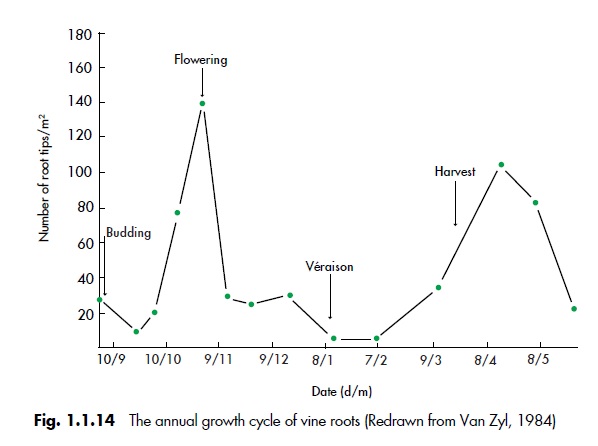
In autumn and especially in winter, many roots die, especially the thinner ones, due to frost, rot, damage caused by various parasites, etc. Furthermore, as the water table rises, part of the root system can go under water and die of asphyxiation. Immersion can only be endured by the largest and permanent roots, when they are in the dormancy phase and all processes are limited. Many new thin and absorbent roots will be reformed over the next spring, as already explained.
Continued ...
